Reserve Bank Bulletin – November 2001 Statement on Monetary Policy
Download the complete Statement 1MB
International economic conditions are at their weakest for many years. The United States has all the hallmarks of recession – declining output, sharply declining profits and investment, falling business and consumer confidence and rising unemployment. These trends were already in train prior to the events of 11 September, as the data up to August make clear, and have continued thereafter. The terrorist attacks themselves were always likely to have only a relatively small economic impact directly, but their effects on confidence – and therefore on the willingness of businesses and individuals to accept risk – are potentially substantial. Gauging these effects is of course a subjective process, and distinguishing them from what was likely to have occurred anyway is virtually impossible. But what is clear is that, for a range of reasons, perceptions of the short-term prospects for the US economy have deteriorated markedly in the past few months.
At any time, this would be a matter of significance for the world economy. The fact that it is occurring while other key regions are also experiencing weakness is all the more cause for concern. Japan remains in the grip of powerful deflationary forces, a decade after the bursting of the bubble that had taken prices for shares and land to extreme levels. Many countries in east Asia, and particularly those which had been able to take advantage of the global technology boom of the late 1990s, are now suffering the after-effects of the slump in that sector. In Europe, growth has also weakened noticeably.
Hence it is now clear that global growth in 2001 has turned out to be a good deal weaker than previously thought, running at less than half the pace recorded in 2000, and many observers now expect 2002 to be almost as weak. Even the latter forecast depends on the US economy beginning a recovery during the first half of next year. The weakening of international economic activity is exerting downward pressure on prices for internationally traded goods and services. Many commodity prices have fallen sharply, the price of oil prominently among them. But also notable is the continued downward pressure on prices for many manufactured goods, especially, but not only, high-technology goods. Exports from the major countries, for example, are receiving lower prices than a year ago, and the degree of price decline is larger for the east Asian producers of electronic components. These influences can be expected to exert a dampening effect on CPI inflation in most advanced countries over time.
Substantial adjustments have taken place in financial markets over the past year or more. Share prices in many countries are 30–40 per cent below their early 2000 peaks. Bond yields have fallen, and monetary policies have been eased. Short-term interest rates, particularly in the English-speaking countries, are at the lowest levels for 30 years. The events of 11 September imparted an additional element of uncertainty to markets, though the short-term impact had largely passed by late September. Yet, with consensus forecasts for world growth continuing to be revised down and great uncertainty remaining about the economic outlook, a difficult period for markets may still lie ahead. For their part, markets expect that central banks in major countries will need to ease monetary policy further in the months ahead.
The most pronounced policy changes have been in the US. The Federal Reserve has reduced short-term interest rates by 450 basis points since the beginning of the year. The US government is also giving a substantial boost via fiscal policy. Much depends on the effectiveness of the US measures, if only because the scope for policy action in other regions seems, for one reason or another, to be limited. In Japan, fiscal and monetary measures over an extended period have all but exhausted the scope for conventional macroeconomic policies – but have not been able to revive chronically weak economic activity, to prevent prices falling or to revitalise weak financial institutions. Underlying structural rigidities in Europe, and the difficulties of building credibility for a new currency, have limited room for expansionary monetary policy measures to date. These constraints should ease as inflation pressures subside, but agreed limits on fiscal balances are likely to become more binding as economies slow.
Were it not for such a gloomy prognosis for the world scene, prospects for the Australian economy would be for very strong growth in the coming year. Real GDP expanded at an annualised rate of just over 3 per cent through the first half of 2001, and this before the upswing in housing construction had really begun. Over the coming few quarters, as dwelling construction rises, a significant boost to production can be expected. The decline in non-residential construction which has taken place over the past two years, also appears to be drawing to an end. With even moderate growth in consumer spending, these trends suggest a distinct firming in domestic demand. But at the same time, the externally oriented sector of the economy – where the rise in the trade balance added nearly 4 per cent to national income over the past two years – will find the going much tougher over the next year. Hence it remains the case, as at the time of the last Statement, that the downside risks to Australia's growth performance come mainly from abroad.
Surveys of business conditions reflect the strengthening trend in domestic demand, particularly in construction and sectors which supply it. At the same time, indicators of confidence about future conditions have shown a noticeable deterioration in readings taken after the terrorist attacks on the US. Such indexes can give misleading signals – they foreshadowed a sharp economic slowdown in 1998, for example, which did not eventuate – and they may be unreliable when surveying early responses to non-economic events, which could not hope to be more than impressionistic. Nonetheless, it would be understandable if an air of caution prevailed as far as financial, investment and hiring decisions were concerned, at least for a short time. When taken together with indications of pressure on profitability, and softness in business credit, this suggests that a significant expansion in business investment which might otherwise be due may not materialise just yet. An additional factor is the impact of both a decline in international air travel and the demise of Ansett on the tourism industry. In the medium term, the effects of these factors will be ameliorated, and possibly offset, by changes in travel patterns and the supply of additional domestic airline capacity. In the short term, however, there is a quantitatively significant impact on tourism activity.
The extent to which business caution may affect the labour market is unclear. Employment has grown during 2001, following a period in which it declined in the second half of last year, but the growth has not been strong enough to prevent a rise in unemployment. Construction and related parts of manufacturing are now seeing stronger demand, but at the same time several services areas, which had been strong for some years, now are reducing their demand for staff.
Labour market outcomes will be an important factor affecting household consumption spending, through both income and confidence effects. To date, modest gains in employment and real wages, together with income tax reductions, have assisted growth in consumption. At the present time, this trend appears to be continuing. Household spending should also be supported by household wealth, which has continued to increase and is at an unusually high level relative to current incomes.
For the past year, assessing inflation has been complicated by the price level rise associated with the introduction of the GST in July 2000, the size of which was estimated to be of the order of 2½ to 3 per cent. With the September quarter 2001 CPI figures, it is now possible to gauge the trend in prices over a one-year period which is largely free of these effects. Over the four quarters to the September quarter, the CPI rose by 2.5 per cent. This compares with 3.2 per cent for the year to June 2000, immediately prior to the GST's introduction. The recent decline in petrol prices is the principal factor behind the decline in CPI inflation between these two observations. In underlying terms, inflation was closer to 3 per cent over the latest twelve months, up slightly from 2½ per cent in the first half of 2000.
So it is now increasingly clear that the economy has weathered the substantial price shocks which occurred last year – the GST, a substantial rise in wholesale import prices due to the decline in the exchange rate, and the rise in oil prices (since partly reversed) – without a significant deterioration in ongoing inflation performance relative to the target of 2–3 per cent. Inflation expectations, after an initial spike associated with the GST, have declined again, wage claims have remained moderate, and competition in most product markets remains keen, notwithstanding the demise of some firms which had cut prices most aggressively in some areas.
At current levels of the exchange rate there should, all other things equal, still be some upward pressure on prices for traded goods and services in the next quarter or two. This factor, together with the impacts of higher insurance premia, rises in air fares and increased electricity charges in some areas, suggests that annual rates of underlying inflation slightly above 3 per cent could still be observed in the near term, as profit margins are gradually restored. These forces have a finite life, however, and given the apparent continued moderate increase in labour costs, the pace of price increases can still be expected to lessen somewhat in due course, as the price level for tradables measured in Australian dollars reaches its new, higher long-term level and other one-off factors fade. International developments, moreover, are placing downward pressure on the foreign currency prices for tradables in international markets. This in turn means that profit margins for importers might be restored without as large a rise in the price to Australian consumers as would otherwise have been the case.
The relatively good performance, by international standards, of the domestic economy has been reflected in financial markets. Australian share prices remain only a little below their peak, in contrast to the falls of 30 per cent or more in many other countries. While domestic interest rates have fallen to historical lows, they have not fallen as much as in some other countries. As such, interest differentials have moved in the Australian dollar's favour. This and the share market's resilience have in general supported the exchange rate. On the other hand, with the international trading environment deteriorating, there have been periods of weakness in the exchange rate, particularly after the terrorist attacks in the US. The Bank thought it important to provide a stabilising influence in these circumstances, and undertook foreign exchange intervention to support the exchange rate in the month of September.
At its meeting on 4 September, the Board judged that the risks to the world economy and signs that inflation would soon peak made it appropriate to ease monetary policy further, notwithstanding the possibility that above-target inflation might be observed temporarily in the near term. The cash rate was reduced by 25 basis points.
The immediate aftermath of the terrorist attacks on 11 September proved a testing time for financial markets. In common with central banks in other major countries, the Reserve Bank sought to ensure, through its daily operations, that uncertainty and heightened risk aversion did not lead to settlement problems or systemic failures in the Australian market. The Bank did not, however, see a case to depart from its normal timetable for considering monetary policy as a result of these developments. The key priority immediately following 11 September was to ensure that the financial system remained functional. Apart from that, the direct short-term impact on the Australian economy of the events themselves was not likely to be large, and a considered response to any likely longer-term impacts was always advisable. Hence the Board met at its normal time on 2 October and, assessing all the available evidence about global events both pre and post the attacks, decided on a further reduction in rates, bringing the cash rate to 4.5 per cent. By any conventional measure, this represents an expansionary setting of monetary policy, a conclusion which can only be reinforced by the low level of the effective exchange rate. To be sure, Australian interest rates are now noticeably above those in the US. But that reflects the contrast between the particular circumstances of the US economy, to which the US authorities have needed to respond, and the relatively stronger performance of the Australian economy since the start of the year. It was with these factors in mind that, at its 6 November meeting, the Board elected not to change the stance of policy for the present.
The period ahead is shaping up as a particularly testing time for the global economy and Australia cannot hope to be unaffected by these events. But Australia can reasonably hope to fare better than most other economies in the current episode. Because exposure to the production side of the ‘new economy’ was limited, a major contractionary force at work in the US and Asia is not affecting Australia to the same extent. In fact, as an importer of high-tech manufactured goods, Australia's terms of trade, and hence national income, are improved by the decline in prices of a wide range of such goods. The Australian share market had not been subject to the excesses seen in some overseas countries in earlier years, and it is therefore not facing the same correction now. While profits have declined somewhat, company balance sheets are in good shape and the financial system is sound. Macroeconomic policies are exerting an expansionary influence on output, and have scope to do so because inflation is well controlled and public debt is low. These are the benefits afforded by consistently disciplined policies in the past decade or more.
As always, the Bank continues to assess the available information and will adjust as necessary the stance of policy in pursuit of sustainable growth, consistent with the inflation target.
International Economic Developments
Global economic conditions have deteriorated through the year, with growth slowing in all major regions (Table 1). While the main catalyst for the slowdown came initially from the information technology and communications (ITC) sector, which had underpinned growth in many countries in previous years, it became more broad-based as the year progressed, with weaker production and investment outcomes spreading across the industrial sectors of many countries. More recently, and even prior to the terrorist attacks in the United States, consumer spending also began to slow, partly reflecting softer labour market conditions. Unemployment rates have stopped falling in most of Europe and are rising in North America and most countries in Asia. While the slowing in output growth has been synchronised, unlike the recession of the early 1990s, the policy response in a number of countries has been relatively rapid.
| Year to June 2000 |
Year to June 2001 |
|
|---|---|---|
| United States | 5.2 | 1.2 |
| Euro area | 3.9 | 1.7 |
| Japan | 1.0 | −0.7 |
| China(a) | 8.2 | 7.9 |
| Other Asia(b) | 7.5 | 1.2 |
| G7(b) | 3.6 | 0.8 |
| Australia's major trading partners(b) | 4.0 | 1.1 |
|
(a) Six months to June over six months to June of previous year Source: Datastream |
||
An easing of inflationary concerns in most countries has enabled monetary policy to be more accommodative, with the global slowdown putting downward pressure on prices due to increases in spare capacity. Wages growth in most countries remains contained. The recent fall in oil prices, if maintained, is also likely to put downward pressure on inflation, though the possible effect of military action places more than the usual degree of uncertainty around this.
The Americas
The US economy contracted for the first time since March 1993 in the September quarter (Graph 1). The fall reflected a decline in business investment, which fell for a third consecutive quarter and is nearly 7 per cent lower than a year earlier (Table 2). Investment in ITC equipment has been particularly weak over much of the past year, following a significant run-up through the 1990s. Private consumption, which has underpinned growth, increased only modestly in the September quarter despite the boost to household income from the tax rebates received in the middle of the year. A rundown in inventories subtracted slightly from growth in the quarter, but has subtracted over a percentage point from growth over the past year.
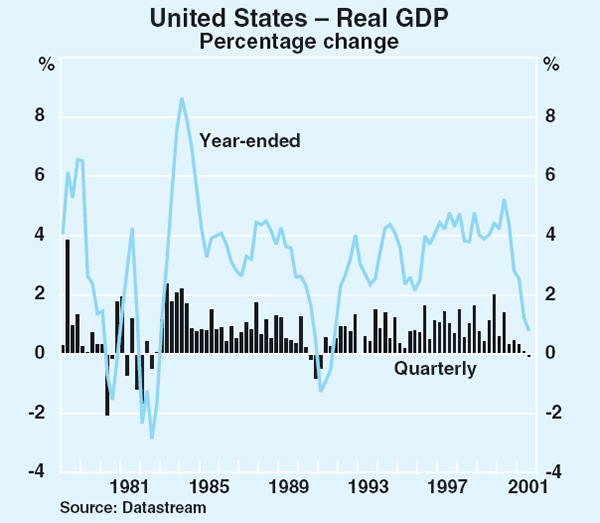
| September quarter 2001 |
Year to: | ||
|---|---|---|---|
| September 2000 | September 2001 | ||
| Private consumption | 0.3 | 4.9 | 2.5 |
| Residential investment | 0.4 | −0.5 | 3.7 |
| Business investment | −3.1 | 10.2 | −6.7 |
| Public demand | 0.4 | 2.4 | 3.8 |
| Change in stocks(a) | −0.1 | 0.1 | −1.1 |
| Net exports(a) | 0.1 | −0.9 | 0.2 |
| – exports | −4.4 | 11.3 | −8.7 |
| – imports | −4.0 | 14.2 | −7.4 |
| GDP | −0.1 | 4.4 | 0.8 |
|
(a) Contribution to GDP growth Source: Datastream |
|||
Manufacturing production fell by 1.7 per cent in the September quarter to be more than 5 per cent lower than the peak recorded a year earlier (Graph 2). Business confidence in the manufacturing sector, as measured by the NAPM index, showed some signs of recovery in the September quarter but fell sharply in October to levels last recorded in the early 1990s recession. Profits of non-financial corporations have declined sharply over the past year, with profits as a share of GDP falling back to around levels of the early 1990s. With firms facing intense competition in a slowing market, investment plans are being curtailed and the number of layoff announcements has increased.
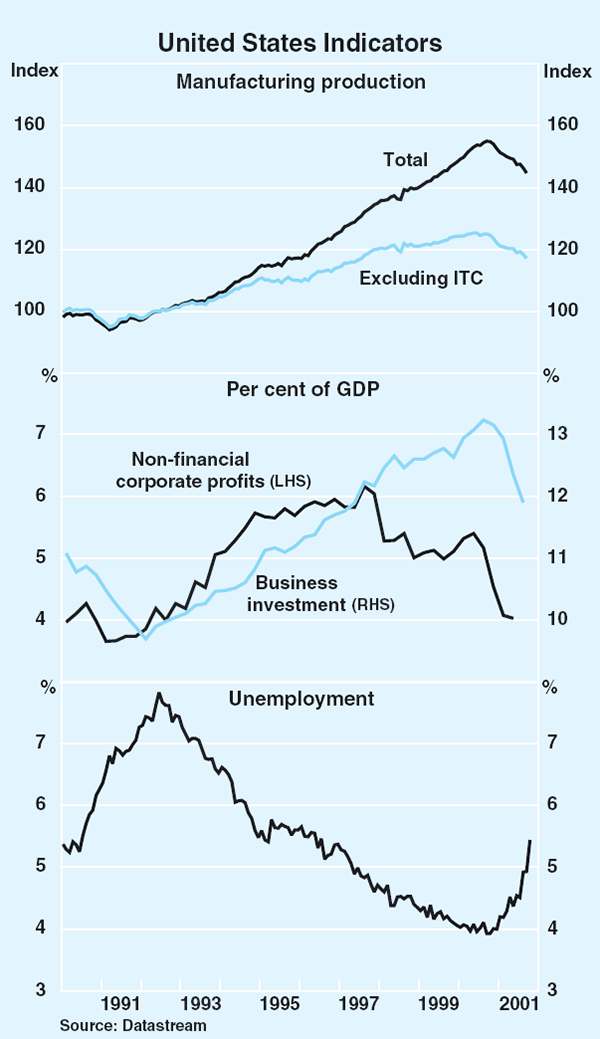
Employment has continued to fall over the second half of 2001, with the unemployment rate rising by nearly one percentage point over this period. The declines in employment were broad-based: falls were recorded in the wholesale trade, services and retail sectors, whereas previously the fall in employment had been concentrated in the manufacturing industry. Measures of consumer sentiment deteriorated from the middle of the year, with particularly large falls recorded in September. These factors, together with a fall in equity prices, have worked to offset the positive effect of increases in disposable income associated with the income tax reductions in the middle of the year and the increase in mortgage refinancings associated with lower long-term interest rates. In contrast to previous slowdowns, the housing sector remains reasonably buoyant as mortgage interest rates were already relatively low preceding the slowdown.
While it is difficult to quantify the impact of the terrorist attacks on the US economy, they had an immediate effect on both consumer and business confidence. At this stage, it is not clear to what extent the falls in business and consumer confidence will translate into falls in aggregate demand, though the speedy policy responses will be helpful. Immediate effects were also felt in a number of sectors where supply was either severely disrupted directly (such as airlines and business and financial services) or indirectly (such as retail and manufacturing). Higher frequency data, such as initial jobless claims and weekly readings of consumer confidence and retail sales, suggest that activity has recovered somewhat, though it is still below levels recorded prior to the attacks.
Underlying inflation has remained stable with higher medical costs being offset by falls in the price of electronic goods and motor vehicles (Graph 3). Wage outcomes are drifting lower, though this has been offset to some extent by an increase in benefits being paid. However, the outlook is for a decline in inflation due to increases in spare capacity of both the labour and capital markets, downward pressure on world prices and falls in the price of oil.
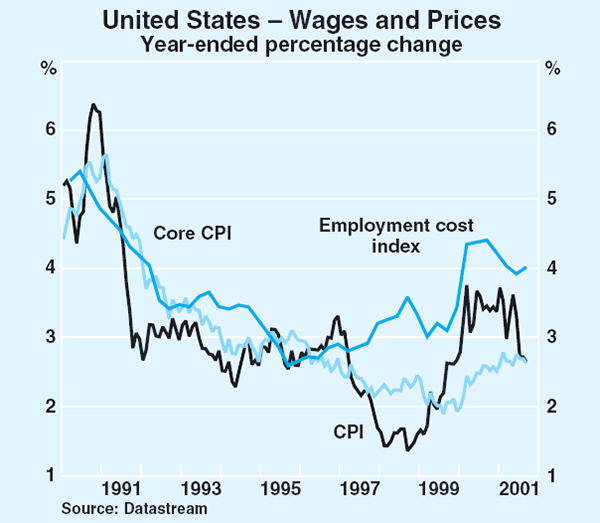
As signs of the slowdown have emerged, the US Federal Reserve has eased monetary policy much faster than in the early 1990s recession with the Fed funds rate now at its lowest level in almost 40 years. The Fed funds rate was cut by 50 basis points shortly after the attacks in an effort to reduce the likely negative effect on business and household confidence of the terrorist attacks, and by a further 100 basis points in subsequent months, bringing the cumulative easing over the course of the year to 450 basis points. Using the underlying measure of the CPI, the real Fed funds rate is below zero, a level previously reached in the recessions of the early 1980s and 1990s.
Fiscal policy has also become supportive of growth due both to policy initiatives and to the operation of the automatic stabilisers (Graph 4). The fiscal package announced mid year amounted to about 1 per cent of GDP spread over two years. Since then Congress has approved emergency relief and airline industry assistance totalling US$55 billion (around ½ a per cent of GDP) spread over the next two years and is considering a further US$100 billion package (equivalent to 1 per cent of GDP).
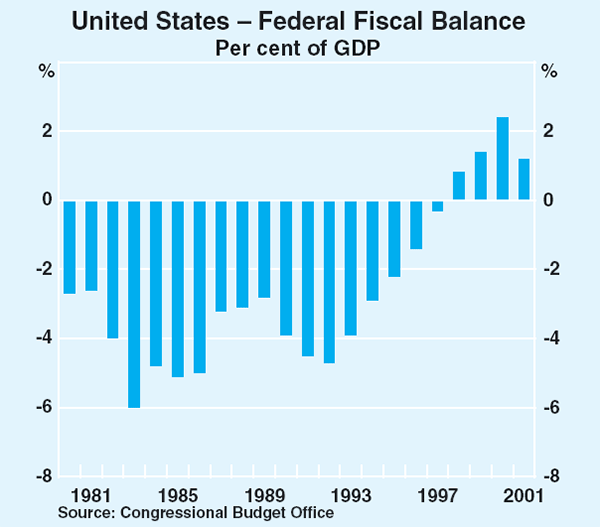
The slowdown in the US has had a significant impact on its two closest neighbours, Mexico and Canada. Growth in Canada has tracked that of the US fairly closely, with year-ended growth in output falling from 5 per cent in March 2000 to just above 2 per cent in June 2001. Much of the fall in growth is due to a decline in manufacturing production, with the slowdown in the US likely to cause further weakness in the transport and auto industries. Monetary and fiscal policies have both been eased, but not to the same extent as in the US. Mexico experienced its third consecutive decline in output in the June quarter, driven by falling investment and weaker exports. As in Canada, the export-related industries (especially tourism and oil) are likely to face lower revenues in the next few quarters.
The other Latin American countries are also experiencing weakness. Annual growth in output in Brazil has fallen from a peak of around 6 per cent in the middle of 2000, to around 1 per cent. The recent weakness reflects softer external demand, though energy-rationing measures also reduced output in the June quarter. Argentina's economy continues to contract, with year-ended growth in output falling for the fourth consecutive quarter in June (for details on Argentinian financial markets see ‘International and Foreign Exchange Markets’).
Asia-Pacific
Japan
The Japanese economy has deteriorated further with the national accounts showing a decline in output in the June quarter. Real GDP has shown little growth over the past four and a half years (Graph 5). Moderate growth in private consumption in the quarter was more than offset by falls in private investment, driven largely by the slowdown in global demand for ITC goods.
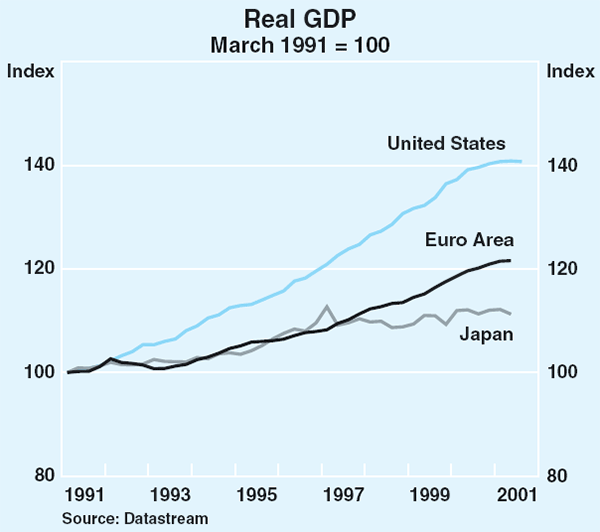
Indications are that the Japanese economy contracted further in the second half of the year. Weakness in the ITC sector, which accounts for about 14 per cent of industrial production, has persisted, with manufacturing output in that sector almost 30 per cent below late-2000 levels and export volumes down by a similar amount over the same period (Graph 6). However, weakness in the manufacturing sector has become more broad-based, with non-ITC output down to levels below those seen during the Asian crisis. Business sentiment, as measured by the Tankan survey, declined further in the September quarter, in response to deteriorating economic conditions and the potential fallout from the terrorist attacks in the US, though the index is still above the levels recorded in the Asian crisis and the early 1990s recession. The survey also pointed to subdued capital expenditure plans.
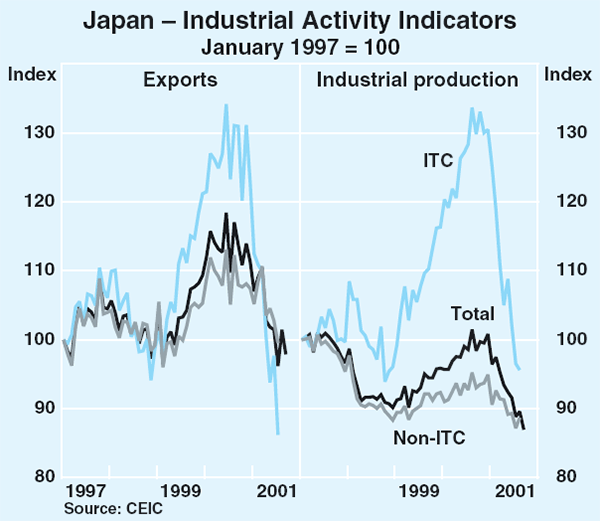
The prospects for consumer spending have worsened. Employment has declined by around 1½ per cent since late 2000 with the unemployment rate reaching an historic high of 5.3 per cent in September; job offers are also trending downwards. Consumer prices continue to fall, with the core measure of inflation around ¾ of a percentage point lower in September 2001 compared with a year ago.
The Bank of Japan has responded to the deteriorating economic circumstances by implementing measures to boost the level of settlement funds held by the banking system as there is no scope for official interest rates to be reduced further. The government has announced the outline of a fiscal package which includes employment support measures and assistance for small business. A self-imposed limit on bond issuance by the government has limited the size of the package. Senior Bank of Japan and government officials have suggested that asset sales may be used to fund any further increases in expenditure. In any case, the spending is likely to be more modest than previous supplementary budgets and will therefore do little more than maintain the support for activity currently in place.
Non-Japan Asia
Much of the region's exports have been affected significantly by the downturn in global growth and demand for ITC goods. Exports of the four major ITC producers – Korea, Taiwan, Singapore and Malaysia – were around 25 per cent lower in September than their peak in 2000 (Graph 7). The sharp decline in exports over the past year has, in turn, dampened production and investment, although production appeared to be stabilising in the middle of the year, with solid increases in July and August. In contrast, consumer spending, which had underpinned growth in most countries over the first half of the year appears to be moderating, especially in those countries experiencing rising unemployment (Taiwan, Singapore, Hong Kong and Thailand). Korea has fared relatively better, due to ongoing strength in domestic demand.
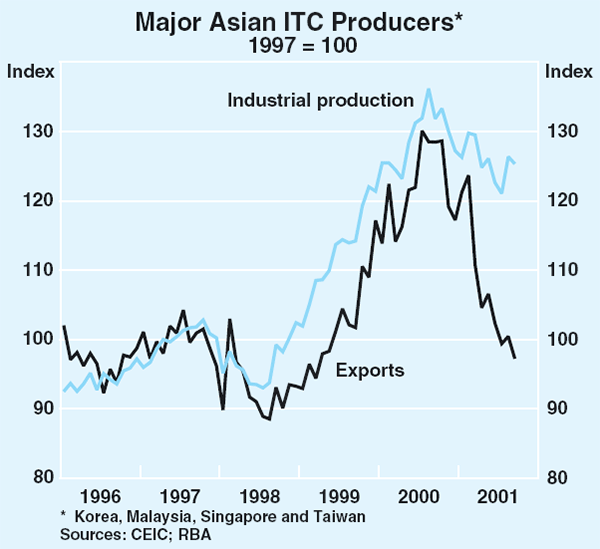
The slowdown in growth experienced in non-Japan Asia towards the end of last year became more pronounced in the first half of 2001. GDP in the region (excluding China) contracted by ½ per cent in the June quarter – the first decline since the 1998 crisis – following two quarters in which it had not grown. The weakness in growth has been most pronounced in those countries heavily involved in the ITC sector. China remains the only economy in the region to be growing at a robust pace, largely reflecting the relatively small size of its external sector, the more diversified nature of its exports and expansionary fiscal policies.
In response to the deteriorating outlook, monetary authorities in much of the region have eased policy. Official interest rates have been reduced significantly in Taiwan, while Korea has eased quite quickly as inflation has moderated. In the Philippines, the sharp rise in interest rates last year in response to rising inflation has largely been unwound. Hong Kong has reduced rates in line with falls in US official interest rates, and Malaysia reduced rates in the wake of the terrorist attacks in the United States (Table 3).
| Change in monetary policy since late 2000 Basis points |
Current policy rate Per cent |
|
|---|---|---|
| Korea | −125 | 4.00 |
| Taiwan | −250 | 2.25 |
| Malaysia | −50 | 5.00 |
| Hong Kong | −450 | 3.50 |
| Thailand | +100 | 2.50 |
| Philippines | −525 | 8.25 |
|
Source: National central banks |
||
Several countries have also announced fiscal packages aimed at boosting domestic demand. In Singapore, the government has announced two packages totalling 8.4 per cent of GDP, which is slightly larger than the stimulus implemented during the Asian crisis. The Hong Kong, Malaysian and Korean governments have also announced stimulus packages that are more modest in size than in Singapore. The Hong Kong package includes measures to assist residential property owners with negative equity in their property due to the significant fall in residential property prices in recent years. In Taiwan, stimulus measures were announced earlier in the year, but delays in legislative approval have meant that the impact is more likely to be felt from the second half of this year.
New Zealand
The New Zealand economy grew by 2 per cent in the June quarter, following a period of slow growth over the preceding year. Private investment rebounded in line with firming business confidence, while consumer spending rose strongly reflecting buoyant labour market conditions and rising rural incomes. Net exports continued to make a strong contribution to growth, with a low exchange rate offering some protection against the slowdown in world growth. Inflation declined to 2.4 per cent in the September quarter, having been around the top end of the RBNZ's target range for the past year due to rising world oil prices, an increase in taxes on tobacco and the depreciation of the exchange rate. The RBNZ reduced the official cash rate by 50 basis points in September, bringing the cumulative easing since March 2001 to 125 basis points.
Europe
Annual growth across the Euro area weakened to around 1¾ per cent in the middle of the year, from its peak of just under 4 per cent a year earlier, though the outcome in the UK was somewhat stronger than that recorded in continental Europe, with this strength continuing in the September quarter. The slowing across Europe was driven by falls in exports, particularly in France, Italy and the UK. Business investment was also very weak in line with the falls recorded in industrial production. In contrast, growth in consumption proved more resilient across most countries, particularly in Germany (where income tax cuts appear to have boosted consumer spending) and the UK, both of which had been subdued late in 2000.
Manufacturing production showed some signs of stabilising across Europe in the middle of the year, in line with a levelling out in business confidence. However business sentiment has fallen sharply over the past couple of months. The survey results may have been temporarily depressed following the terrorist attacks in the US. However if the survey results are indicative of renewed weakness in Europe, downward adjustments are likely to be made to investment plans and the pace of corporate retrenchment will accelerate. The declines in production in Europe earlier in the year appear already to be having an impact on employment growth, especially in Germany, with nearly all countries recording weaker employment outcomes over the course of this year (Graph 8). One exception is the UK where the unemployment rate is around an historical low.
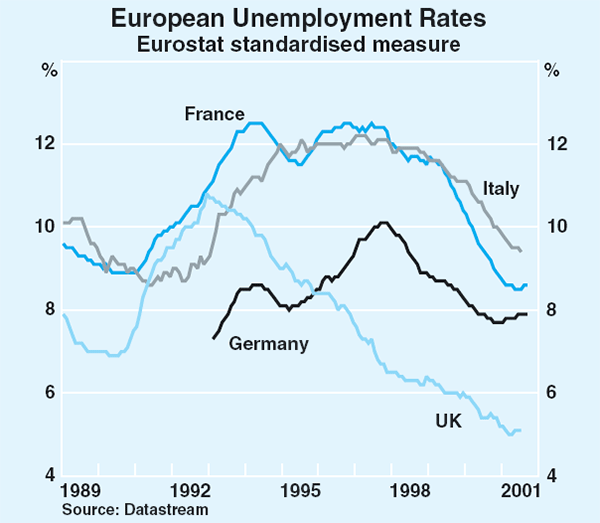
Inflationary pressures continue to ease in the euro area (Graph 9) with CPI inflation falling from its recent peak of 3.4 per cent in May to 2.5 per cent in September, as the impact of higher oil and food prices was unwound. When food and energy are excluded, inflation has drifted higher, though this is expected to be reversed in response to slower growth in aggregate demand and the effect of the recent appreciation of the euro. The ECB eased monetary policy by 25 basis points in late August, and by a further 50 basis points in mid September. Consumer prices in the UK have risen over the past year due to higher food prices in the wake of the foot and mouth disease problem. However, inflation remains around the Bank of England's inflation target of 2½ percent. The Bank of England also cut its key interest rate by 25 basis points to 4.75 per cent in mid September, citing concerns about world growth and the impact of the terrorist attacks, and by a further 25 basis points in early October. This brought the cumulative easing in the UK this cycle to 150 basis points.
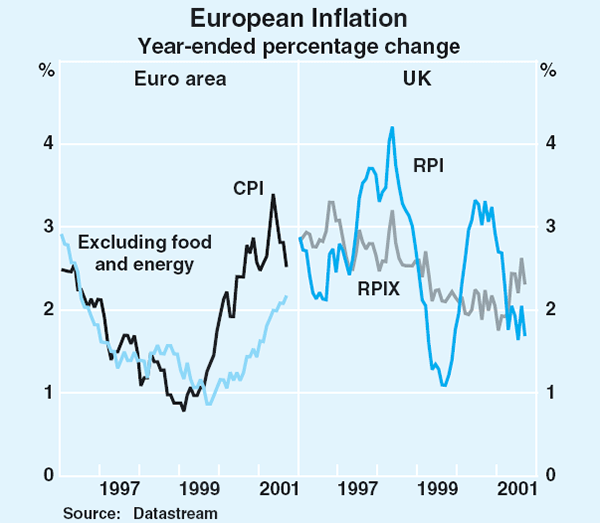
The scope for discretionary fiscal policy to be eased across Europe in the year ahead in response to weaker conditions is constrained by the European Union Growth and Stability Pact, and the overall thrust of policy in 2002 is broadly neutral (Table 4). While most countries are well within the 3 per cent deficit ceiling that triggers penalties, the deficits are forecast to exceed the current Stability Program targets which set down an adjustment path for achieving balanced fiscal positions. In contrast, in the UK a mild fiscal easing is projected next year, following an easing equivalent to around ¾ of a percentage point of GDP this year.
| 2000 | 2001(f) | 2002(f) | |
|---|---|---|---|
| Euro area | −0.8 | −1.1 | −1.0 |
| (−0.7) | (−0.6) | (−0.3) | |
| – France | −1.4 | −1.3 | −1.6 |
| (−1.4) | (−1.0) | (−0.6) | |
| – Germany | −1.3 | −2.2 | −1.8 |
| (−1.0) | (−1.5) | (−1.0) | |
| – Italy | −1.5 | −1.3 | −0.9 |
| (−1.3) | (−0.8) | (−0.5) | |
| United Kingdom | 1.6 | 0.7 | 0.2 |
|
(a) Headline balance, net of mobile telephone licence receipts. Sources: IMF and European Commission |
|||
World economic outlook
The outlook for world economic growth in 2001 has been continually revised down this year, with significant revisions occurring before the terrorist attacks in the US. Surveys of private-sector forecasters, which attempt to take these events into account, imply world growth of around 2½ per cent in 2001 and around 3 per cent in 2002, well down on forecasts from three months ago (Graph 10). The impact on the major industrialised countries is expected to be greater and would take growth in both years to around that recorded in 1991. The impact on Australia's trading partners is also expected to be pronounced, with the degree of synchronisation of the current global economic slowdown having the potential to limit the scope for diversion of exports.
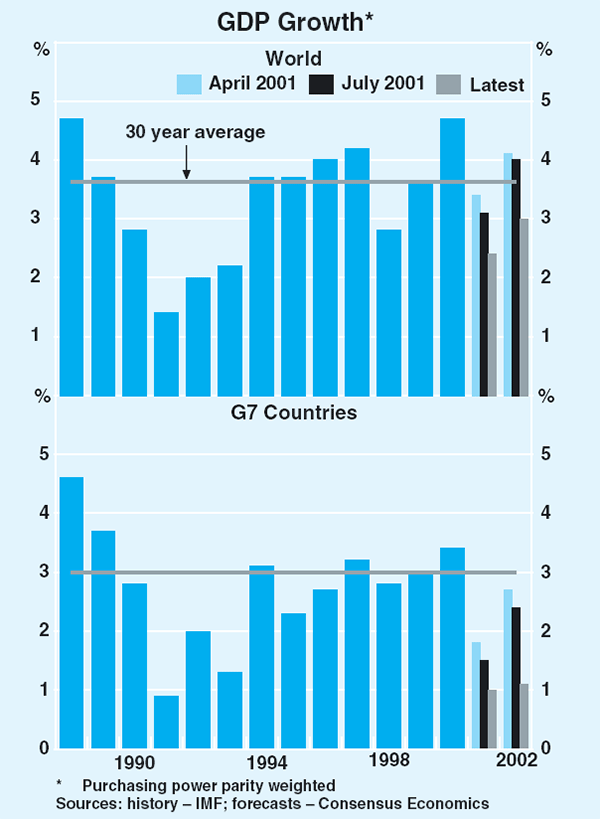
Macroeconomic policies are responding to this weakness. Central banks around the world have eased monetary policy in an effort to support demand, with real official interest rates in G7 countries now at their lowest level in over two decades (Graph 11). Fiscal settings have also become more accommodative, with major expansionary packages announced in the US and a number of Asian countries. Based on IMF forecasts, fiscal settings in the major industrialised countries have been broadly expansionary in 2001, Japan being the main exception. Given recent fiscal packages announced in the US and Asia and the impact of slower growth in government revenues due to weakening activity, it is likely that fiscal policy will also be expansionary in 2002.
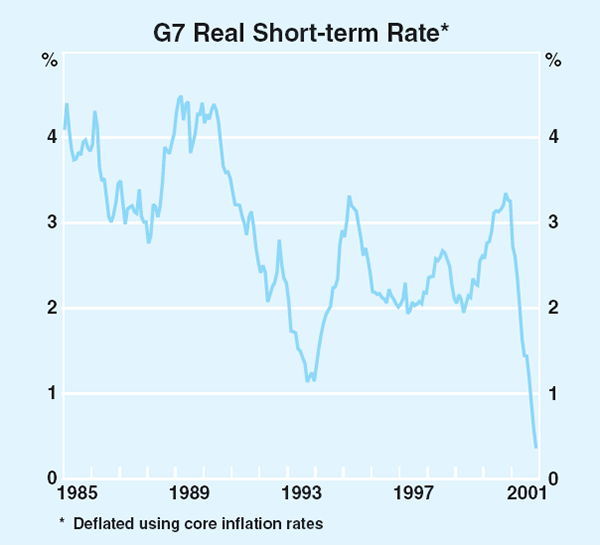
The current cyclical downturn is different from those of the past few decades, in that monetary policy was not as tight prior to the downturn as in other episodes. However the structural imbalances that exist in some countries are large. At this stage, the most likely outcome for the major economies is that the recession in the second half of this year is followed by a modest recovery towards the middle of 2002. A faster recovery, which is characteristic of earlier cycles, is a possibility although the size of the imbalances that need to be unwound in the US, and the ongoing problems in Japan, suggest that this is unlikely. On the downside, there is a risk that the synchronised slowdown, coupled with heightened military tensions globally, will lead to a persistent fall in appetite for risk among businesses and much more conservative behaviour by households.
International and Foreign Exchange Markets
Short-term interest rates
The process of monetary easing that has been evident in most industrial countries during the past year has continued in recent months, as central banks responded to growing signs of economic weakness and evidence that inflationary pressures are starting to diminish.
Central banks around the world acted quickly after the terrorist attacks to boost liquidity in their financial systems. The aim was to ensure that markets did not experience systemic failures resulting from disruptions in payments and settlements systems or the increase in risk aversion. To help calm markets, many central banks issued statements immediately after the attacks, outlining their intentions to provide liquidity support to their financial institutions. These measures were designed to ensure the continued smooth operation of markets rather than to change monetary conditions. The easings by central banks in September generally did not start until a week or so after the attacks. (Australia was an exception in that it had reduced interest rates in early September.)
On 17 September prior to the re-opening of US share markets (markets were closed for 4 working days – the longest shutdown since the 1930s) the US Federal Reserve announced a cut of 50 basis points in its official interest rates. It was followed over the next 48 hours by several other central banks. Subsequent to these steps, which in most instances occurred outside the central banks' regular policy schedules, many central banks followed up with further cuts in interest rates at their regular policy meetings (Graph 12).
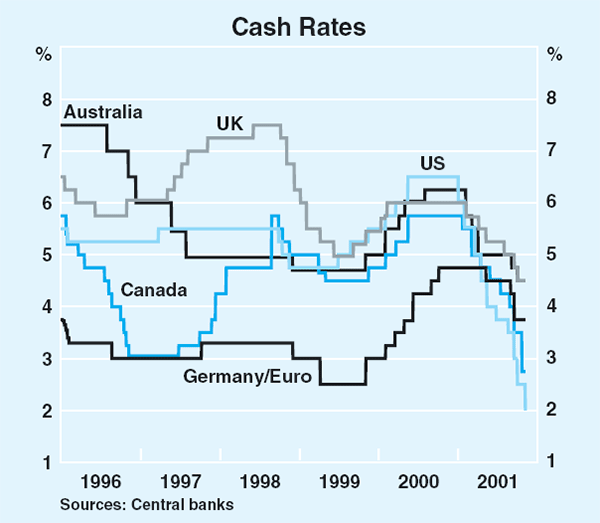
The US Federal Reserve has cut interest rates at every policy meeting this year, as well as on three occasions between meetings. In total, there have been 10 cuts in rates, amounting to 450 basis points. These have reduced the Fed funds target to 2.0 per cent, its lowest level since the early 1960s and 100 basis points below the low point seen in the early 1990s recession (Graph 13). Real short-term interest rates in the US are now around the lows seen in the early 1990s (Graph 14). Financial markets continue to price-in further rate reductions in the US over coming months. They expect the Fed funds target will fall to 1.75 per cent or lower.
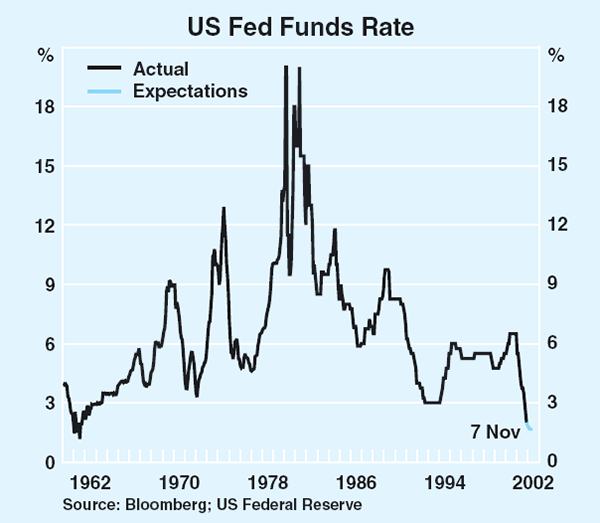

Cumulative easings by other central banks have been significantly less than those of the US Fed. After the Fed, the largest easing has been by the Bank of Canada, which has reduced rates by 300 basis points in 2001. This includes a cut of 75 basis points on 23 October, which took the target cash rate to 2.75 per cent (Table 5).
| 2001 | Cumulative changes since Jan 2001 |
Current level Per cent |
|||||||||||
|---|---|---|---|---|---|---|---|---|---|---|---|---|---|
| Jan | Feb | Mar | Apr | May | Jun | Jul | Aug | Sep | Oct | Nov | |||
| US | −100 | −50 | −50 | −50 | −25 | −25 | −50 | −50 | −50 | −450 | 2.00 | ||
| Canada | −25 | −50 | −25 | −25 | −25 | −25 | −50 | −75 | −300 | 2.75 | |||
| Australia | −50 | −25 | −50 | −25 | −25 | −175 | 4.50 | ||||||
| UK | −25 | −25 | −25 | −25 | −25 | −25 | −150 | 4.50 | |||||
| NZ | −25 | −25 | −25 | −50 | −125 | 5.25 | |||||||
| Switzerland | −25 | −100 | −125 | 2.25 | |||||||||
| Euro area | −25 | −25 | −50 | −100 | 3.75 | ||||||||
| Japan | −10 | −15 | −25 | 0.00 | |||||||||
|
Sources: Central banks |
|||||||||||||
The cumulative cuts this year by other central banks (excluding Japan) generally range from 100 to 175 basis points, with Australia at the top end of this range and the European Central Bank (ECB) at the lower end.
The current level of interest rates among industrial countries (leaving aside Japan where interest rates are at zero) ranges from 2.0 per cent in the US to 5.25 per cent in New Zealand. By historical standards, this range is both low and narrow (Graph 15). Among the English-speaking countries, nominal rates are generally at their lowest level for about 30 years. In Europe, while interest rates are low, they remain above the levels prevailing during the period of economic weakness in the late 1990s. The low level and relatively narrow range of interest rates around the world reflects the fact that inflation is also in a tight range, and low by historical standards.
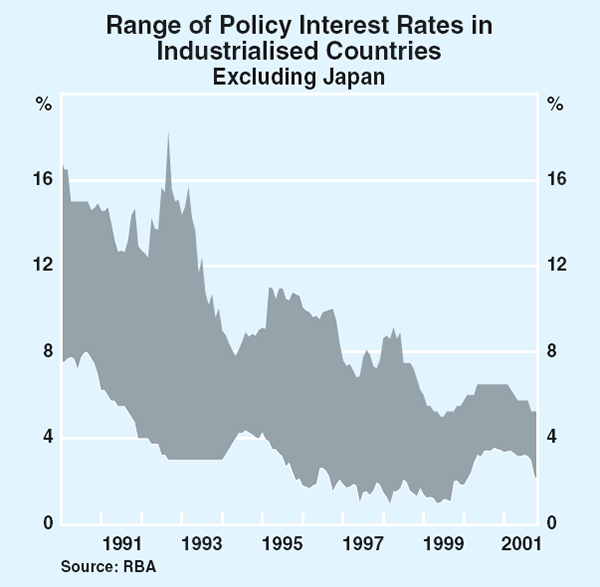
Having reduced its interest rates to zero in March 2001, the Bank of Japan has since been directing its monetary policy to boosting banks' total reserves. Initially the target for reserves was set at 5 trillion yen, which was around 20 per cent above average reserve holdings over the previous year. It has since been increased to ‘over 6 trillion’ yen. Actual reserves rose above this for a time in the second half of September as banks sought to boost their liquidity ahead of their half-year balance date, and are currently at around 9 trillion yen. The Bank of Japan supplied the additional reserves ahead of end September partly by not sterilising intervention that it was undertaking in the foreign exchange market at that time. In other words, it allowed the yen that it delivered to banks in exchange for its purchases of US dollars to remain in the money market, rather than withdraw them by the sales of securities.
Asian central banks, with the exception of Bank Indonesia and Bank Negara, also have eased monetary policy over the past few months. In these countries, nominal interest rates are at low levels, generally in the range of 1–4 per cent. This is well below the level of rates that followed the Asian financial crisis. Indonesia has not shared in this downward trend in interest rates; its rates have been rising since mid 2000 and are now about 18 per cent (Graph 16). This difference is largely explained by the much higher inflation rate in Indonesia, which over the past year was 13 per cent.
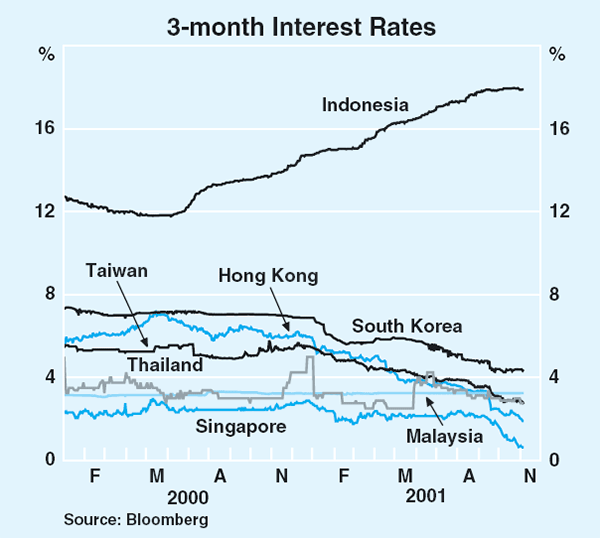
Interest rates in Latin America remain high due to concerns about the sustainability of Argentinean finances, despite further IMF support. Short-term peso interest rates in Argentina are around 60 per cent at present, substantially higher than their level at the time of the 1998 financial crisis. In Brazil, they are around 20 per cent, or about half their 1998 levels (Graph 17).
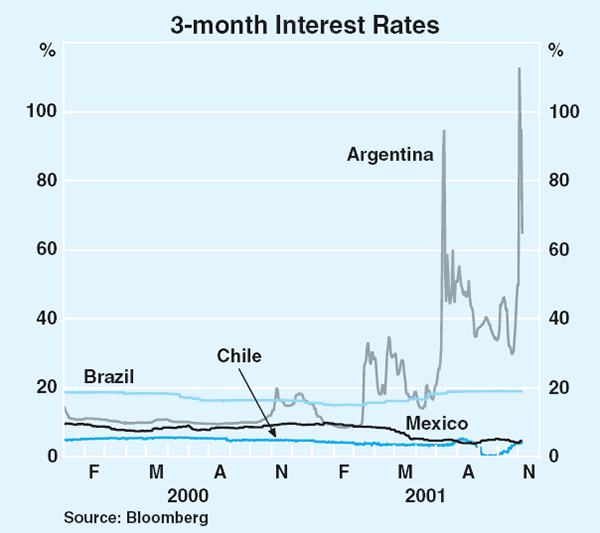
Long-term interest rates
Long bond yields around the world have generally continued to fall over recent months. Lower official interest rates, downward revisions to growth prospects in virtually all countries and signs that inflation in most countries was receding were the main forces driving this. The terrorist attacks added to the downward pressure, particularly for government yields as investors sought to move into relatively safe investments. The fall in bond yields was most notable in the US, where 10-year US Treasury bond yields are down about 125 basis points from their level six months ago and 250 basis points from their peak in early 2000. Yields have fallen to 4.20 per cent, and intra-day fell to 4.1 per cent, the lowest level of bond yields since the mid 1960s (Graph 18).

Long yields in the US have not fallen as much as short rates this year, and are currently over 200 basis points above short rates (Graph 19). This gap is quite high by historical standards, indicating that monetary conditions in the US are relatively easy at present. The gap is not as wide as in the early 1990s, however, suggesting that, on this measure, monetary conditions are not as easy as in that earlier period.
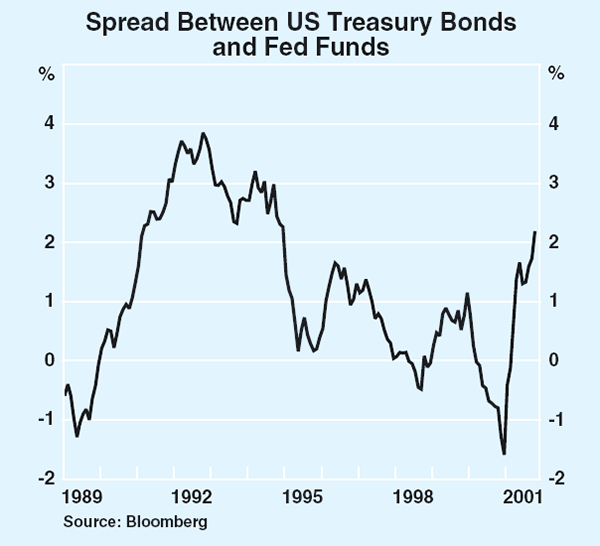
The spreads between yields on government bonds and those on corporate bonds in the US were relatively steady over August and the first part of September, but rose noticeably after the 11 September terrorist attacks. This was because uncertainty created by those attacks led to a rise in risk aversion among investors and therefore a preference for government debt. The increase in spreads was most significant on riskier classes of fixed income debt; spreads on high quality AAA-rated paper did not react much.
Despite the recent rise, the current level of spreads for all the credit categories remains within the range of the past couple of years (Graph 20). That is, markets are not pricing-in an unusually severe deterioration in credit quality.
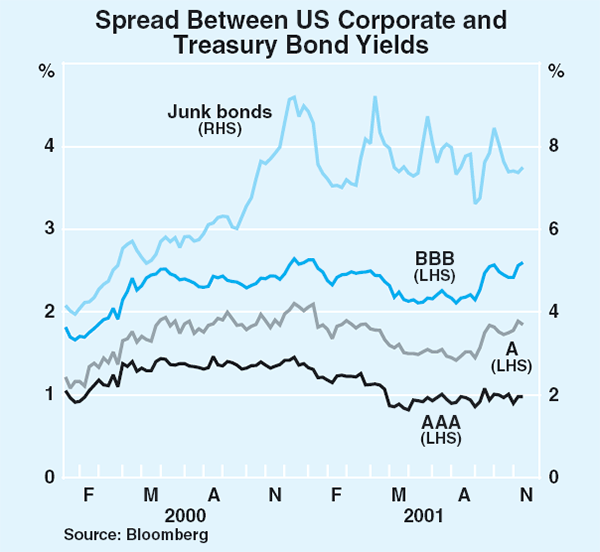
In European bond markets, yields have continued to take their lead from the US. However, while the direction of moves in Europe has mirrored the US, the amplitude has generally been less. German 10-year government bond yields have fallen by around 90 basis points over recent months, to 4.30 per cent. Consequently, the relativities between US and German 10-year government bonds changed sharply. Six months ago, US yields were about 30 basis points above German yields but recently they have generally been below.
Yields on Japanese government bonds have tracked an independent course over recent months, with yields on 10-year government paper generally trading in a tight range between 1.30 per cent and 1.40 per cent.
In emerging markets, the focus remains on Argentina, where economic and financial conditions have failed to improve over the past three months. Although additional IMF assistance was forthcoming in August, investor concerns about the ability of the Argentine Government to meet debt obligations have remained. These concerns were exacerbated in early November when the government announced a plan to swap outstanding government debt with bonds yielding lower coupons. Although ostensibly ‘voluntary’, the swap plan has been interpreted by many in the financial markets as tantamount to default, with Standard and Poor's revising Argentina's sovereign credit rating down to ‘Selective Default’ from CC. Spreads between the country's sovereign debt and US Treasuries increased sharply on the announcement, by 400 basis points to over 2,400 basis points (Graph 21). The current level of spreads is higher than that reached in the mid-1990s crisis. Although events in Argentina have contributed to further rises in yields throughout Latin America, as well as in European emerging markets, the increases so far appear to be reasonably well contained. Spreads on Asian sovereign debt have remained remarkably stable despite events in Argentina.
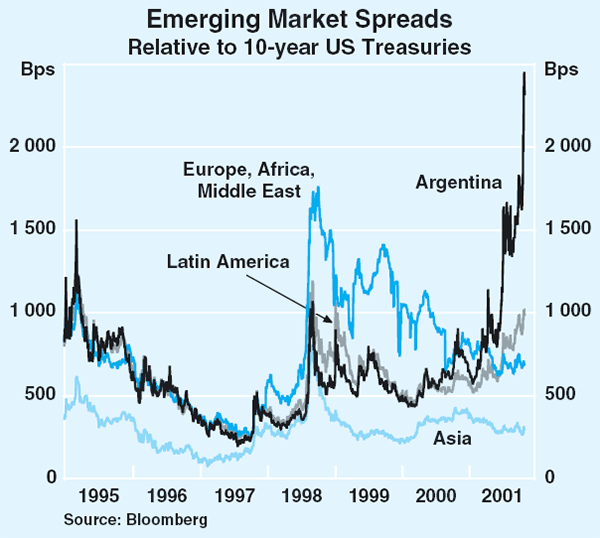
Equity markets
The significant deterioration in the global economic outlook and continued disappointing earnings announcements, particularly by technology companies, have weighed heavily on equity markets over recent months. This equity market weakness mostly predated the terrorist attacks, with August being a particularly weak month in most countries. The terrorist attacks initially led to a further sharp fall in share prices, but by early October this had been unwound in most countries (Graph 22).
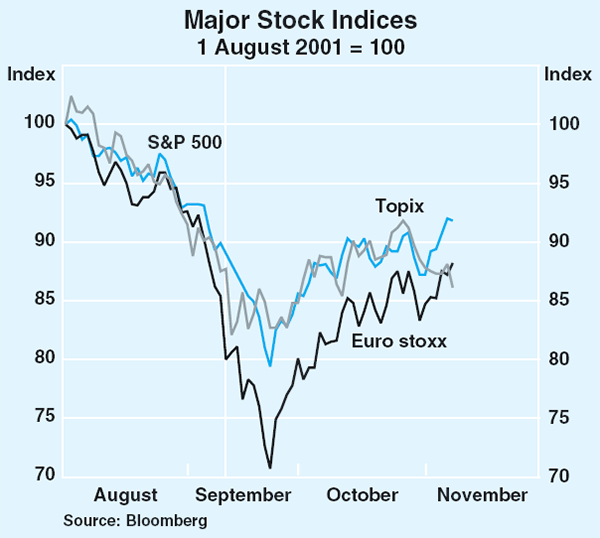
In the United States, the Wilshire Index, the broadest measure of US share prices (accounting for over 90 per cent of listed companies) has fallen by 9 per cent since early August and is now 30 per cent below the peak in March 2000. The S&P 500 has experienced similar falls, while the Nasdaq is down 12 per cent since early August, and 64 per cent from its early 2000 historical high. Since early 1995, when the last phase of the bull run in shares began, the Wilshire, S&P 500 and Nasdaq are now all showing similar net increases – about 120 per cent (Graph 23). The marked outperformance of the Nasdaq during 1999 and early 2000 has now been fully reversed. It is hard to avoid the conclusion that the Nasdaq index experienced a major bubble over this period, rising by 150 per cent over the 15 months to March 2000, only to reverse this over the following twelve months or so.
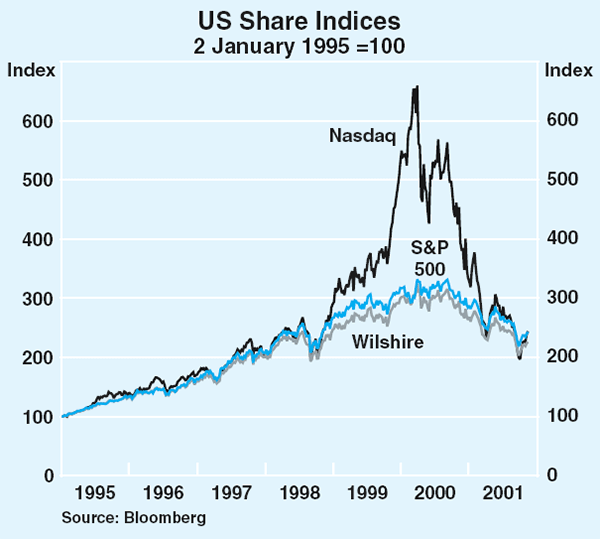
Earnings of companies in the US continue to be weak. For those companies in the S&P 500, earnings declined by 34 per cent in the year to September. The fall in earnings over 2001 is likely to significantly exceed the 15 per cent fall seen in 1991, the worst year for earnings in the early 1990s recession.
Despite the substantial falls in share prices since the early 2000 peaks, some traditional measures of share price valuation, such as price-earnings (P/E) ratios, remain relatively high. The current P/E ratio for the S&P 500, of around 29, remains well above its historical average of 16, even though it is down from the recent peak of 36 (Graph 24). Likewise, the ratio of US share market capitalisation to nominal GDP remains well above its historical average (Graph 25). For this to be justified would require either that GDP in the future grow substantially faster than its historical average, or at least that the share of GDP going to company profits be higher than its historical average.
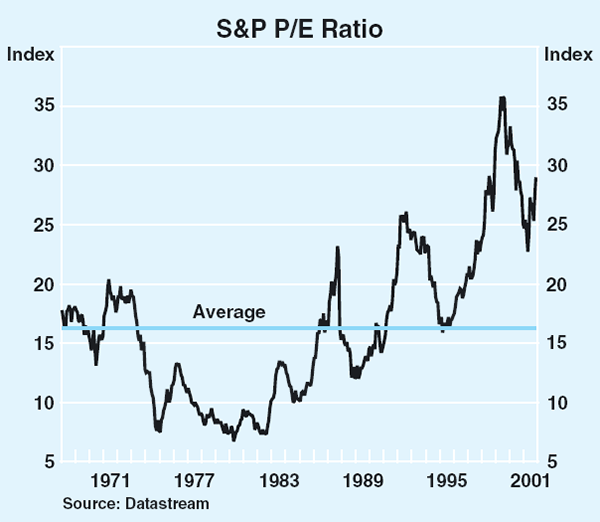
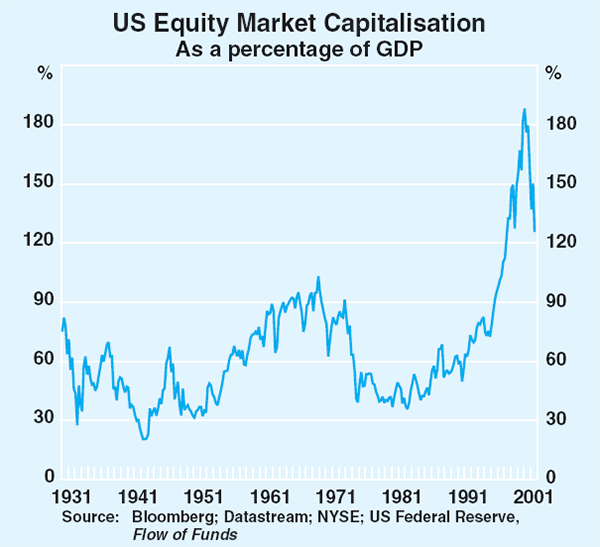
Share prices in other countries have generally followed those in the US, although in many cases falls have been even more pronounced than in the broad US markets (Table 6). The Euro Stoxx index (a broad index of 310 major Euro area companies) has fallen by 12 per cent since early August, and at one stage in late September was down by over double that amount. European markets tend to have quite a high exposure to the telco sector, which has been a particularly weak sector around the world.
| Change since 2000 peak |
Change over 2001 |
Change over past six months |
|
|---|---|---|---|
| United States | |||
| – Wilshire | −30 | −16 | −12 |
| – Dow Jones | −19 | −11 | −13 |
| – S&P 500 | −27 | −15 | −12 |
| – NASDAQ | −64 | −26 | −15 |
| Euro area | |||
| – STOXX | −36 | −23 | −18 |
| United Kingdom | |||
| – FTSE | −25 | −16 | −11 |
| Japan | |||
| – TOPIX | −41 | −19 | −28 |
| Australia* | |||
| – ASX 200 | −6 | 1 | −3 |
| Canada | |||
| – TSE 300 | −37 | −20 | −11 |
|
* Peak was in 2001 Source: Bloomberg |
|||
The pattern in the Japanese share market over recent months has been similar to that in other major countries. The level is, however, much lower. Share price indices in Japan are around one third their level at the peak in 1990.
Asian equity markets have resumed their downward trend, after a brief period of stability around the middle of the year (Graph 26). In aggregate, Asian equity markets (excluding Japan and China) have fallen by around 24 per cent so far this year, but individual performance continues to vary. Hong Kong, Singapore and the Philippines have each fallen by around 30 per cent, while Korea has gained around 10 per cent on levels at the start of this year. Share prices in Latin America are also down by 12 per cent this year (Graph 27). They have been particularly weak in Argentina, where price falls since the start of the year have been in the order of 40 per cent.
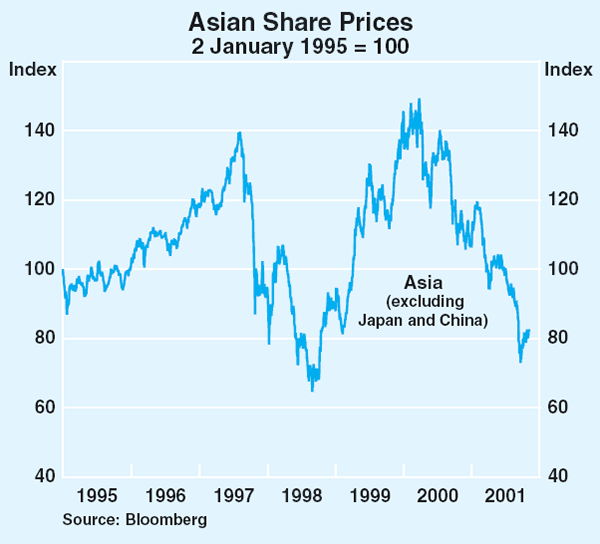
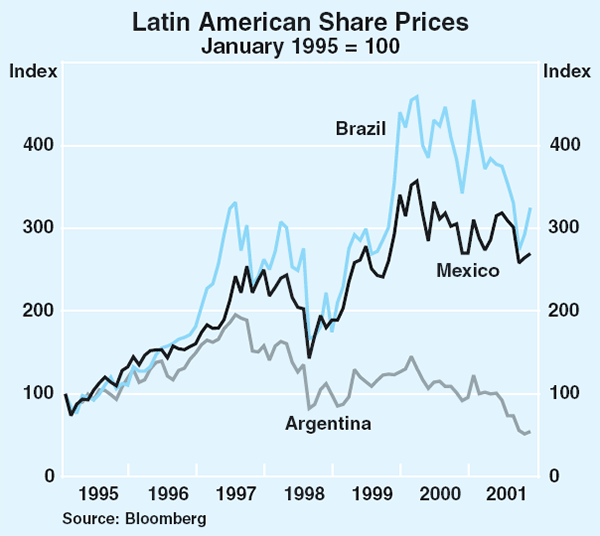
Exchange rates
The strong US dollar appreciation evident since 1995 was partly reversed around the middle of 2001 as the factors that supported the US dollar over the latter half of the 1990s disappeared. The interest rate differential with the rest of the world, for a long time positive to the US, turned negative against most major countries. Similarly, the growth gap in favour of the US closed and US productivity growth slowed (with historical data also having been revised weaker). Falls in the share market also reduced the attractiveness of US equities.
The events of 11 September initially caused the US dollar to fall further (Graph 28). The largest fall was against the Swiss franc, which rose due to increased ‘safe-haven’ flows following the terrorist attacks. The Swiss authorities expressed concern about the franc's appreciation (it rose by 7 per cent against the US dollar and 5 per cent against the euro following the terrorist attacks) and cut interest rates by 50 basis points in response. The US dollar also fell noticeably against the yen. There were reports of repatriation of overseas investments by Japanese institutions to reduce their foreign exposures ahead of their September half-year end. The decline against the yen was resisted by significant intervention in the foreign exchange market by the Japanese authorities, who have repeatedly asserted that an appreciating yen is not consistent with the country's fundamentals. Swings in the US dollar/euro exchange rate have been more muted, though the euro remains at a relatively low level.

More recently demand in the foreign exchange market has again swung in favour of the US dollar. Investors seem to be of the view that the significant monetary and fiscal stimulus applied in the US since the September attacks will result in US economic activity recovering faster than in Europe (and Japan). The recent renewed strength of the US dollar means that its trade-weighted value is now only about 2 per cent below its July peak (Table 7).
| Change over 2001 |
Change since July peak |
|
|---|---|---|
| TWI | 5.2 | −2.2 |
| Euro | 5.0 | −6.8 |
| Yen | 5.8 | −3.8 |
|
Source: Bloomberg |
||
Currencies of Asian emerging markets that float appreciated against the US dollar in July and August, but have since depreciated leaving them relatively unchanged (Graph 29). The exception is Indonesia, where the rupiah has appreciated by 7 per cent since July after resolution of uncertainties regarding the country's political leadership. Latin American currencies continued to slide due to contagion from problems in Argentina. The Brazilian real is down 24 per cent for this year, and the Chilean peso is down 18 per cent.
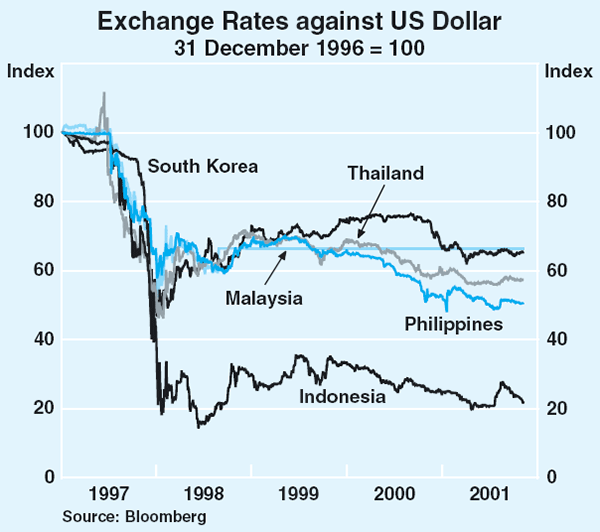
Australian dollar
After trading steadily around US51–52 cents during the middle months of 2001, the Australian dollar has shown considerable volatility since (Graph 30). It rose noticeably in August, to reach almost US54 cents. A number of factors contributed to this, including a growing recognition among market participants that the Australian economy was performing more strongly than its US counterpart. Consensus forecasts for economic growth in Australia were holding up reasonably well, while US growth forecasts were being revised down sharply. This pattern was reflected in divergent trends in share markets in the two countries, with the Australian market remaining close to its peak while the US market was falling quite rapidly. Interest rate differentials were also moving increasingly in Australia's favour. In addition, the release of the June quarter balance of payments, indicating that Australia's current account deficit, as a proportion of GDP, had fallen to its lowest level since 1980, further boosted confidence in the currency.
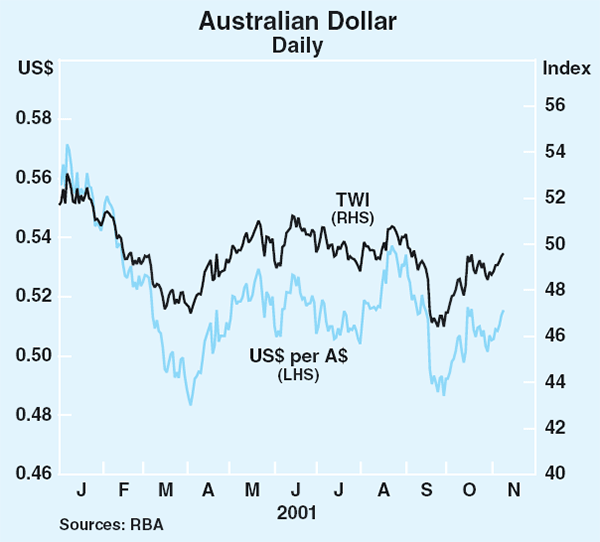
Over late August and early September, as markets became increasingly concerned about the impact of the weakening global economy on Australia, the exchange rate of the Australian dollar began to fall. A weakening in the world economy has traditionally been seen by markets as a negative factor for the Australian dollar because, in the past, periods of global economic weakness have typically resulted in falls in commodity prices and in Australia's terms of trade, with consequential adverse effects on the balance of payments and the economy more generally. As noted in the chapter on the ‘Balance of Payments’, however, even though world economic activity has slowed over the past year and commodity prices have fallen, Australia's terms of trade have risen. This break from the traditional relationship, if sustained, should in due course result in the Australian dollar becoming more resilient to weakness in global economic growth.
The terrorist attacks in the US initially saw the Australian dollar rise amid a general movement away from US dollar denominated assets. But the situation changed quickly over subsequent days as risk aversion among international investors increased. The Australian currency fell sharply, not only against the US dollar but also against other major currencies. During this period, the pattern of investment flows seemed to indicate both a retreat by international investors to their home country and, within countries, a move from equities to relatively secure investments such as government bonds. The currencies that did best during this period were those of countries that have large creditor positions, such as the Swiss franc and the Japanese yen.
Adding to the downward pressure on the exchange rate in the first half of September was a number of large, one-off corporate transactions which resulted in substantial sales of Australian dollars. Some of these hit the market immediately following the terrorist attacks and their timing partly explains the unusually sharp fall experienced by the Australian dollar during this period.
The Australian dollar reached a new low in trade-weighted terms of 46.0 in mid September; the previous low had been 47.1, reached in early April this year (Graph 31). Against the US dollar the exchange rate remained above its previous low of US47.75 cents.

By late September, as confidence started to re-emerge in markets, and with the large one-off transactions completed, the exchange rate stabilised and then recovered. The recovery was reinforced as market attention focused on the widening interest differential in favour of the Australian dollar.
Abstracting from the substantial volatility in the exchange rate over recent months, the current levels of both the US dollar rate and the trade-weighted index are broadly in line with the respective averages over the past year.
In view of the volatile conditions, the Bank undertook an increased amount of intervention in the foreign exchange market in September, buying in total about A$780 million in the market. Intervention operations in August and October were negligible.
Domestic Economic Activity
The Australian economy has recorded moderate growth during 2001, although it remains somewhat slower than was recorded during the second half of the 1990s. Output expanded at an annualised rate of 3¼ per cent over the first half of this year, following the GST-related decline in the second half of 2000 (Graph 32). The main reason for the resumption of growth was that dwelling investment stopped falling (Table 8). A pick-up in growth of consumer spending and public demand also contributed, and exports continued to rise strongly. A similar pattern in growth was recorded across the states, with the pick-up in activity in the first half of 2001 being most marked in Queensland and Victoria.
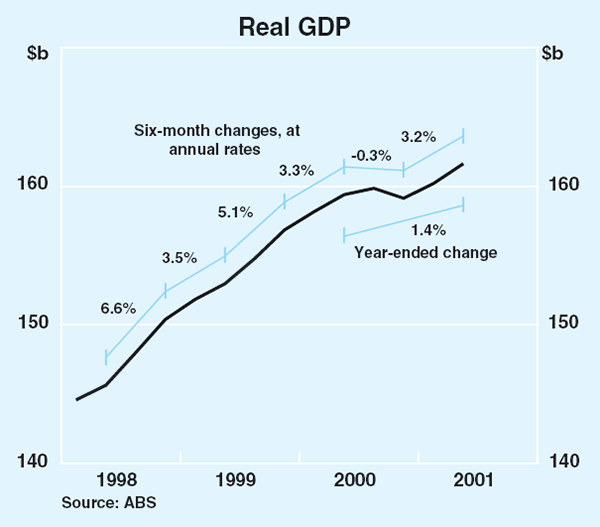
| Six months to: | June quarter 2001 |
||
|---|---|---|---|
| December quarter 2000 |
June quarter 2001 |
||
| Private final demand(a) | −2.4 | 2.1 | 0.2 |
| Consumption | 0.8 | 2.6 | 0.7 |
| Dwelling investment | −31.2 | 3.2 | 3.6 |
| Business investment(a) | −1.5 | −2.0 | −4.9 |
| Public final demand(a) | 0.4 | 2.1 | 0.9 |
| Domestic final demand | −1.8 | 2.1 | 0.3 |
| Change in inventories(b) | 1.0 | −0.9 | 0.7 |
| Exports | 2.2 | 2.0 | 1.1 |
| Imports | −2.7 | −2.4 | −0.2 |
| Net exports(b) | 1.1 | 0.9 | 0.3 |
| Gross domestic product | −0.2 | 1.6 | 0.9 |
|
(a) Adjusted for transfers between the public and private sectors Source: ABS |
|||
The significant expansion in the housing sector that is currently in train should continue through much of this financial year, and will have flow-on effects to construction-related sectors. While the confidence of the household sector was adversely affected by the events of mid September, up until that time consumer confidence had been reasonably positive, supported by the ongoing growth in household incomes and assets and the reductions in interest rates since the beginning of the year. Continued strong growth in household credit should provide support for consumer spending in the period ahead.
Across the business sector, however, conditions have varied considerably over the year to date. Conditions in the construction sector and the construction-related parts of the manufacturing sector have clearly improved since the beginning of this year, and the low exchange rate has afforded a competitive advantage to export-oriented sectors. In contrast, conditions in parts of the services sector, particularly those that are information technology and communications (ITC) related, have deteriorated in line with global trends. Overall, the weakening in trading conditions since the middle of 2000, combined with some increases in costs, has contributed to a decline in aggregate measures of profitability. Although businesses generally recorded some improvement in conditions around the middle of the year, supported by easier fiscal and monetary policies, a corresponding improvement in investment intentions and employment was not observed. Businesses' external fund raisings, particularly through intermediaries, have also remained subdued. More recently, the worsening outlook for the world economy and uncertainty created by the events of mid September have increased the risks surrounding the outlook, particularly for export-oriented businesses.
Household consumption
Consumer spending increased strongly in the first half of 2001, following subdued growth in the second half of last year (Graph 33). Spending on services (which accounts for around three-quarters of household consumption) has continued to grow very strongly, driven largely by rising expenditure on healthcare. Retail trade data suggest that robust growth continued in the September quarter, with the volume of retail sales increasing by 1.6 per cent, to be 5.8 per cent higher than a year earlier. Over the past few quarters, the strength in retail sales has been concentrated in hospitality and services, household goods and other retailing (particularly sales of pharmaceuticals). The pick-up in sales from household goods retailers has been consistent with the recovery of the dwelling construction sector. Households' purchases of motor vehicles have remained soft since the beginning of this financial year, in part reflecting the unwinding of the pre-GST growth in motor vehicle purchases.
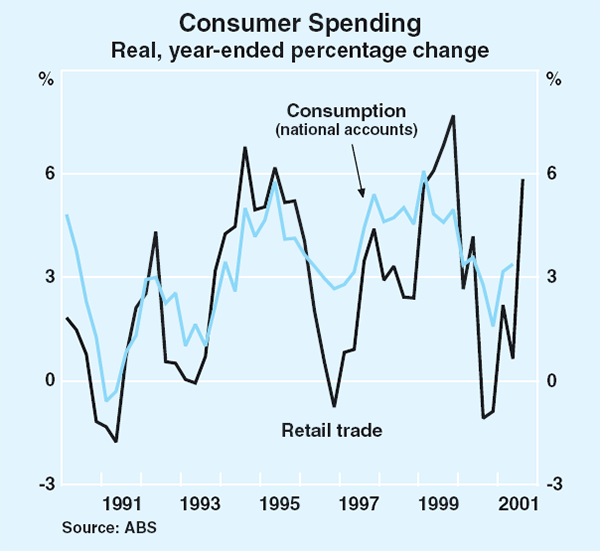
Some of the recent strength in consumer spending has been underpinned by one-off factors. Consumer spending on healthcare has increased markedly over the past year; it increased by almost 25 per cent over the year to the June quarter and contributed around 1 percentage point to consumption growth over that period. In part, this appears to have been a consequence of the government's ‘Lifetime Health Cover’ initiative, which commenced on 1 July 2000. This initiative encouraged the take-up of private health insurance and it seems that the increased insurance cover has led to a significant increase in demand for health services (Graph 34). The disproportionate growth of consumer spending on healthcare relative to health services output in part reflects the large increase in spending on pharmaceuticals during this period. The $300 payment to aged pensioners in June, which was announced in the most recent Commonwealth budget, is also likely to have increased spending on a range of retail items in recent months; with more than 2.2 million people eligible for this payment, it amounts to a potential stimulus of over $660 million.
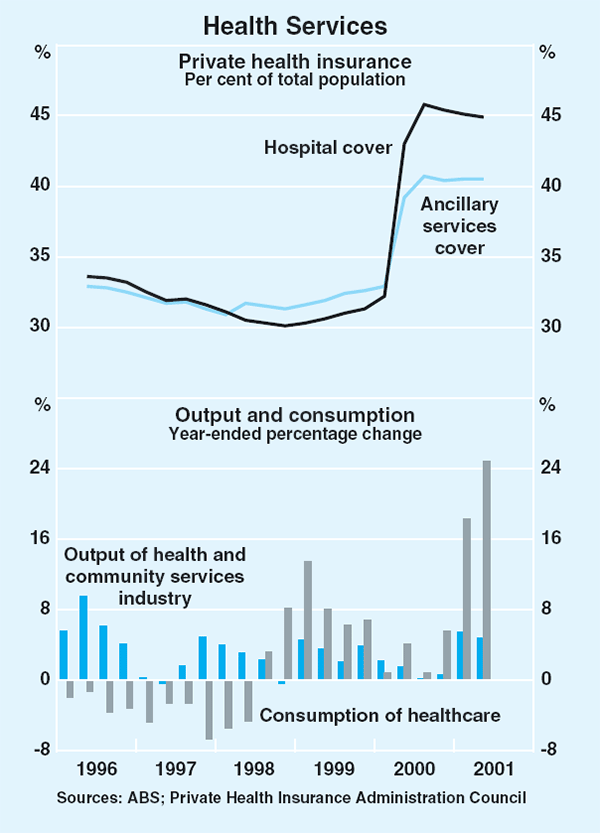
More generally, however, continued growth in household incomes, reductions in interest rates, lower petrol prices and modest growth in household assets have provided conditions conducive to the ongoing expansion in consumer spending. Real disposable income grew by 1.1 per cent in the June quarter, to be 3.7 per cent higher over the year. Although labour market conditions were relatively weak in the June quarter, this was offset by continued growth in wages and lower debt-servicing payments. The fall in the latter, stemming from the lowering of interest rates in the first half of the year, boosted household disposable income by around ½ of one percentage point in the June quarter. The growth in real disposable income over the past year also reflects the fact that, in aggregate, the lowering of tax rates and increases in transfer payments from July 2000 more than offset the increases in prices that occurred at that time (Graph 35).
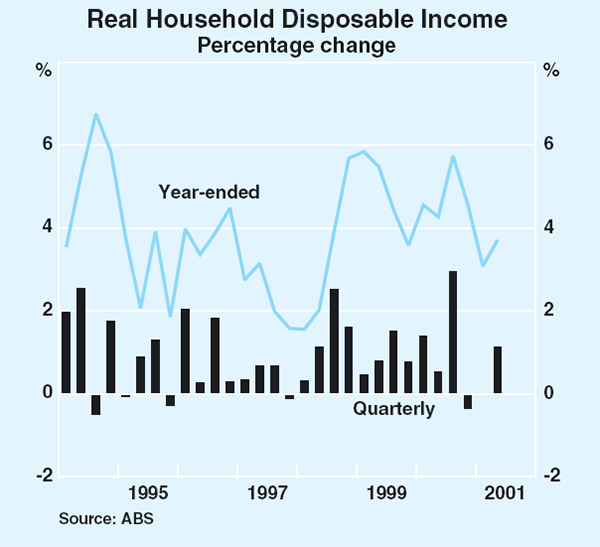
The sharp fall in interest payments has led to a substantially lower household debt-servicing burden, although higher overall levels of household indebtedness mean that the debt-servicing burden is well above previous low points (Graph 36). Housing loan arrears, a lagging indicator of financial stress, remain a small share of total loans by historical standards. The measured saving ratio is currently above the average levels recorded in 1998 and 1999.
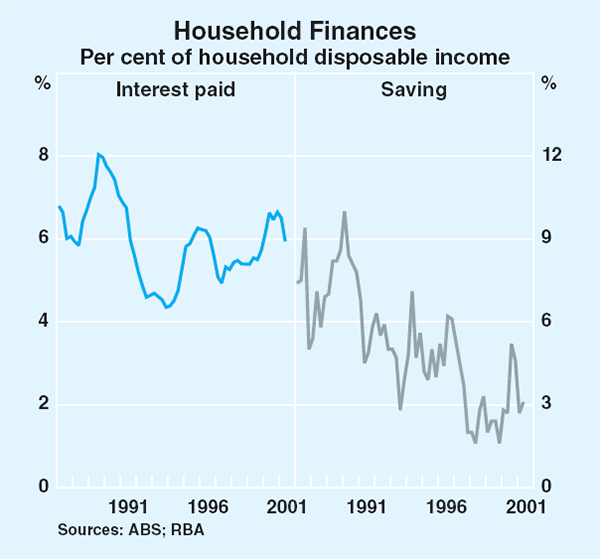
Household credit has grown by an annualised 17 per cent over the six months to September. The strength in household borrowing reflects a significant further expansion in both housing and personal credit, and should support consumption expenditure in the presence of subdued employment growth. The household debt to disposable income ratio has remained at its historical peak of 105 per cent.
On the other side of the balance sheet, the value of household assets increased by 3.7 per cent over the year to the June quarter, with robust growth being recorded in the first half of 2001 after somewhat subdued growth in the second half of 2000 (Table 9). In recent quarters, broad-based gains in dwelling prices and further increases in household financial assets, owing mainly to strong increases in holdings of equities, have contributed to this growth. The decline in equity markets since the middle of the year, however, will have reduced the value of households' financial assets.
| Level | Annualised growth | ||
|---|---|---|---|
| Year to June 2001 |
Average 1996–99 |
||
| $b | Per cent | ||
| Non-financial assets | 1,895 | 1.4 | 12.1 |
| – Dwellings | 1,726 | 1.0 | 13.0 |
| – Consumer durables | 168 | 6.0 | 4.3 |
| Financial assets | 1,248 | 7.3 | 11.0 |
| – Currency and deposits | 273 | 9.9 | 5.6 |
| – Equities and unit trusts | 274 | 16.8 | 25.1 |
| – Superannuation and life offices | 634 | 3.9 | 10.2 |
| – Other | 67 | −4.1 | 6.4 |
| Total assets | 3,143 | 3.7 | 11.7 |
|
Source: RBA |
|||
Measures of consumer sentiment have broadly reflected developments in households' incomes and assets. In the June and September quarters, consumer sentiment, according to the Westpac-Melbourne Institute measure, was at a relatively high level, consistent with the reasonable pace of consumer spending that was recorded. In October, however, in the wake of the terrorist attacks in the US, the deterioration in global growth prospects and the handover of Ansett airlines to administrators, consumer sentiment fell sharply (Graph 37). While large, the fall in sentiment was not unprecedented, being slightly less than the fall in March following the release of the December quarter national accounts. Much of the weakness in October was related to perceptions about economic conditions over the coming year, rather than concerns relating to personal finances. Despite these falls, consumer sentiment remains around its long-run average level.
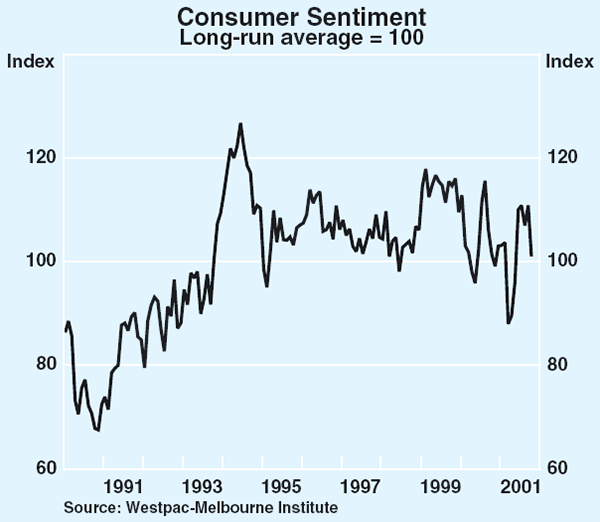
Housing
Dwelling investment rose modestly in the first half of this year and the leading indicators suggest that considerably stronger growth is in prospect for the second half of the year. Early in the September quarter, both building approvals and loan approvals for new construction almost regained the peak levels recorded in early 2000 before easing a little in the latest monthly readings (Graph 38). The growth in dwelling investment over the first half of 2001 was concentrated in alterations and additions, and it appears that the recovery in house-building activity was delayed to some extent by the collapse of HIH Insurance. While liaison suggests that in most states the insurance-related delays have been resolved, some problems appear to have persisted in NSW.
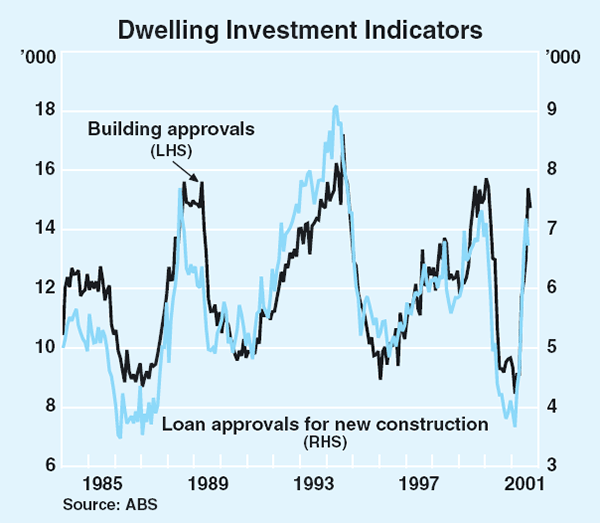
Over the past couple of years, the cycle in dwelling construction activity has been significantly affected by government policies as well as the standard factors such as interest rates and affordability. The effect of the introduction of the GST in mid 2000 on dwelling construction activity has been discussed in previous Statements. More recently, the introduction of the First Home Owner Grant (FHOG) scheme and the Commonwealth Additional Grant (CAG) has assisted the entry of some first-home buyers into the market earlier than would have otherwise been the case. Given that the CAG was expected to expire at the end of December (and the recently announced extension of the CAG still implies some scaling back of the Grant from the beginning of 2002), it may also shift some activity into the next couple of quarters from later periods. Information collected by State Revenue Offices indicates a continued high level of grants issued, particularly for new housing (Graph 39). The effect of the government grants is also evident in the increase in the proportion of first-home buyers seeking finance for housing. While first-home buyers generally comprise around 25 per cent of loan approvals (excluding refinancing), the latest figures put their share around 30 per cent. The gap between these figures is suggestive of the additional stimulus that the government grants are having on the housing sector. The FHOG has provided stimulus to housing demand in all states, although its effect continues to be relatively large in the smaller states, where median house prices are lower.
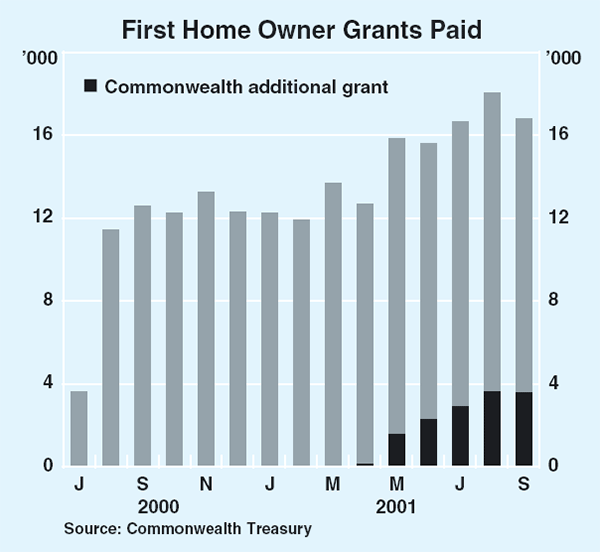
While the effect of the government grants on housing investment is likely to be significant, the recovery in house purchases – both new and established – by non-first-home buyers and investors has also been robust. Since the trough in loan approvals to owner-occupiers in February, the number of loan approvals for first-home buyers has increased by around 60 per cent, while loan approvals to other owner-occupiers increased by around 30 per cent. Investor activity has also been particularly strong: in value terms, the growth in demand for housing loans by investors has been broadly similar to that of first-home buyers, suggesting that other factors, notably low interest rates, have also been important in the recovery. Part of the recovery in activity reflected a return to levels consistent with underlying demand in the housing sector. The pick-up has been stronger than this, however, and the current level of building approvals is well above most estimates of underlying demand.
Strong demand for housing has been reflected in an 8 per cent increase in house prices over the year to the June quarter 2001, according to stratified data published by the ABS (Graph 40). These data attempt to remove the effect of compositional change in the sample of houses sold; this has been important in aiding interpretation of price movements in recent quarters, given the significant changes in the proportion of first-home buyers in the market. House prices have increased most strongly in recent quarters in Melbourne and Canberra, although increases have been recorded in most capital cities. The Real Estate Institute of Australia (REIA), which reports median house prices, indicates similar results to the ABS for Australia-wide house price movements. However, in contrast to the rise in house prices in Sydney in the June quarter reported by the ABS, REIA reported a fall, which partly reflected an increase in the proportion of lower-priced properties, particularly in the outer suburbs, which were purchased in the quarter. Large price increases were recorded in the inner suburbs of Sydney. There is now, however, mounting evidence that rental vacancy rates are rising, particularly for medium-density dwellings, so the relatively strong growth in medium-density construction in recent years may well be in the process of lessening excess demand pressures.
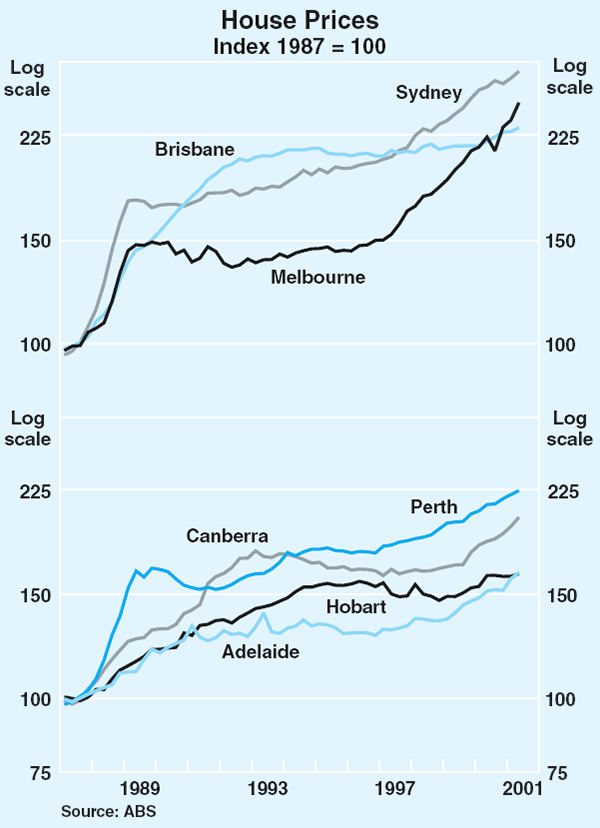
The business sector
Output growth has continued to vary considerably across industries. After the sharp slowdown in the second half of 2000, modest improvements in activity in the construction sector occurred in the first half of 2001 (Graph 41). This has already been associated with an increase in manufacturing output, consistent with the close relationship between construction and related manufacturing industries. Other traditionally cyclical sectors, such as the transport and storage and retail and wholesale trade sectors, also recorded a strong increase in output in the June quarter, with the inventory overhang that accumulated during the second half of 2000 having been unwound to some extent. Some business-related service industries, however, which had been growing relatively strongly in recent years, reported a slowdown in growth in the June quarter. Part of the earlier growth was a result of preparations for the Olympics, Y2K and the new tax system, but the downturn has been exacerbated by the recent downturn in the global ITC industry. (See Box A on ‘The Service Sectors’.)
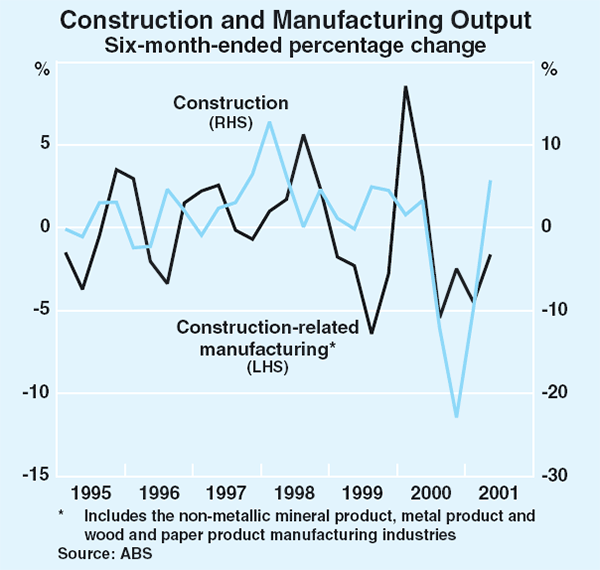
Overall, businesses reported an improvement in conditions and confidence in the September quarter, prior to the events of mid September. A strong improvement in business conditions was reported in the September quarter NAB business survey, taking the index above its long-run average level, with the improvement being concentrated in domestically oriented industries, particularly construction, retail and wholesale (Graph 42). The NAB and Yellow Pages surveys suggest that the improvements were spread across small and large businesses. While the ACCI-Westpac survey and other surveys that focus on the manufacturing sector reported that actual conditions remained relatively subdued in the September quarter, they did record a strong rise in business confidence for the next three to six months. In contrast to the results for the domestically oriented sectors, the September quarter NAB survey reported a deterioration in conditions for businesses exposed to the international economy, particularly mining. This suggests that slowing world economic growth was beginning to have an effect prior to the terrorist attacks in the US.
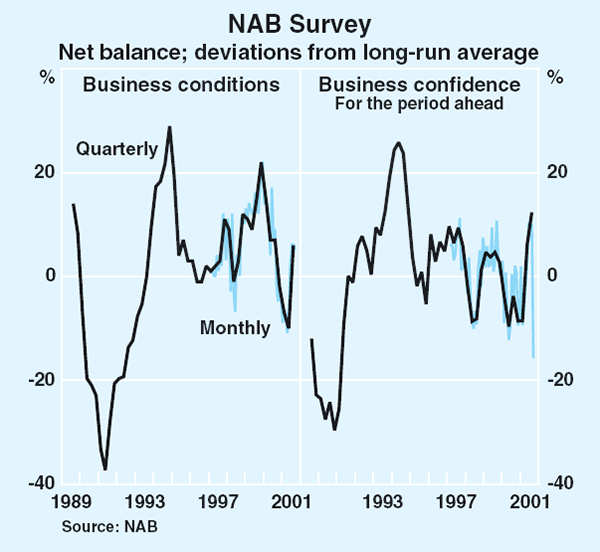
Not surprisingly, surveys conducted after mid September have reported a marked deterioration in business confidence. The September NAB monthly survey reported a large fall in business confidence, taking the series to its lowest level since its inception in 1997, and below all quarterly readings for this survey since 1991. All sectors reported a fall in confidence, with particularly sharp falls recorded for those sectors incorporating insurance and tourism, reflecting their greater exposure to recent events. The September readings from the Dun & Bradstreet survey and the ACCI Survey of Investor Confidence show similar effects. To infer strong implications from this recent deterioration in sentiment for activity would be premature, as it is unclear whether it will be sustained and, if it is, how it will affect business decisions. In particular, it remains unclear whether firms feel more confident about their own operations than about the national economy, which, if true, could have a mitigating effect on business decisions. This occurred during the Asian crisis and there is some evidence in recent survey responses from the ACCI Survey of Investor Confidence that this may be occurring in the current episode. Prospects for the tourism industry, however, have clearly been adversely affected by these developments. (See Box B on ‘The Tourism Industry’.)
Even prior to mid September, the recorded improvements in business conditions and confidence had not had an appreciable effect on businesses' investment intentions, suggesting an underlying degree of caution within the business sector. These results were consistent with the weakness in business investment that continued into the June quarter. In aggregate, investment fell by nearly 5 per cent in the quarter, with a sharp 9 per cent fall in expenditure on machinery and equipment more than offsetting a modest rise in non-dwelling construction activity. Both components of investment have been very subdued over the past couple of years, and are now well below long-run average shares of GDP (Graph 43).
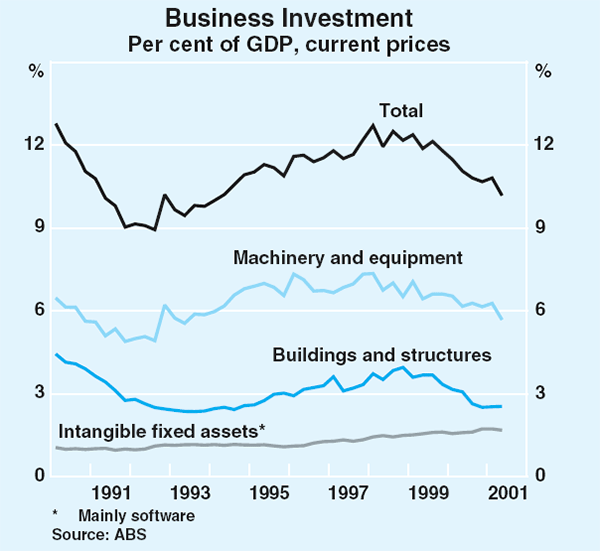
According to the June quarter ABS capital expenditure survey, the outlook for machinery and equipment investment for the 2001/02 financial year has also weakened. These data now imply that nominal growth in equipment investment in 2001/02 will be below 3 per cent, assuming five-year average realisation ratios. Given the recent further slowing in world growth and heightened levels of uncertainty, however, it is likely that a lower realisation ratio is more appropriate. Much of the expected growth in equipment investment continues to be concentrated in the mining sector, which has been partially insulated from the deterioration in global conditions by the low value of the Australian dollar. Investment in motor vehicles, which represents around a quarter of overall machinery and equipment investment, has, to date, received only a small boost as a result of the recently announced changes to the tax treatment of business purchases of motor vehicles.
Investment in buildings and structures is starting to recover, rising by nearly 2 per cent in the June quarter, largely due to an increase in engineering construction. Following considerable weakness in the 2000/01 financial year, the outlook for expenditure on buildings and structures has improved. The strong growth in non-residential building approvals early in 2001, and the improvement in other forward-looking indicators, such as commencements and work-yet-to-be-done, points to a pick-up in non-residential construction activity in the quarters ahead. Support for such activity has been provided by vacancy rates in office property, which remain low by historical standards, and market valuations of property trusts, which have continued to rise. The ABS capital expenditure survey, which reported a strong rise in expected investment in buildings and structures for 2001/02, and the improvement in the value of projects currently under construction or committed, as reported in the Access Economics Investment Monitor, also point to an improvement in the outlook for investment in buildings and structures. A considerable proportion of this growth is expected to come from mining-related sectors.
The slowdown in expenditure on intangible fixed assets has continued, with overall investment declining slightly in the June quarter. The main driver of the decline was further weakness in expenditure on computer software (which accounts for around 80 per cent of intangible fixed asset investment); demand for computer software continues to slow in the post-‘tech boom’ environment and following the boost provided by Y2K and the pre-GST spending on computing and accounting systems. Mineral and petroleum exploration fell in the June quarter, although it remains higher over the year and is expected to be strong over the next six months, reflecting the highly competitive position of the mining sector.
Subdued profits, reflecting increased cost pressures, high levels of competition, and weaker trading conditions, are likely to have contributed to the weakness in business investment. Corporate sector profits, as measured in the national accounts, have fallen significantly since mid 2000 and fell by a further 4.2 per cent in the June quarter (Graph 44). Combined with revisions to recent history, which suggest that corporate profitability was not quite as strong as previously thought, these falls imply that corporate profits as a share of GDP have fallen slightly below their average for the past decade.
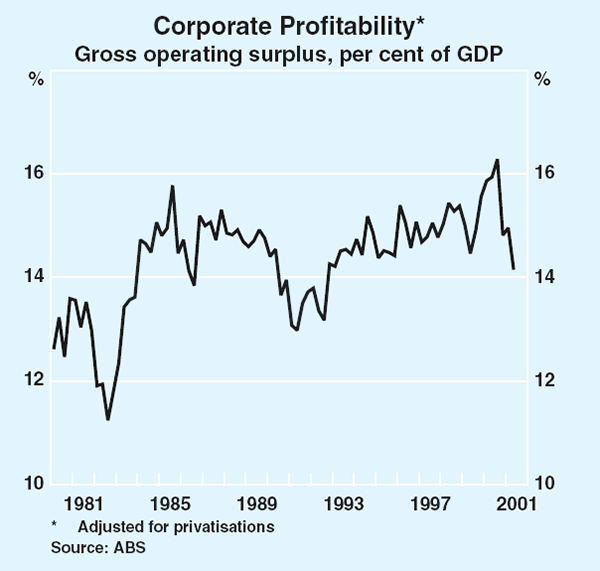
Mining profits increased by around 14 per cent over the year to the June quarter, driven by both strong output growth and higher commodity prices in Australian dollar terms. In contrast, manufacturing profits have fallen by close to 20 per cent, but some recovery may be expected with the recent and prospective strength in the housing sector. The recovery in the housing sector should also be positive for profits of the small business sector, which – as measured by the gross operating surplus (GOS) of unincorporated enterprises – grew by just under 2 per cent in the June quarter, but remained slightly below the level prevailing a year earlier.
The financial position of businesses, however, generally remains sound (Graph 45). Lower official interest rates have contributed to the corporate net interest burden falling in the June quarter, to be 21 per cent of GOS, which is quite low by historical standards. The debt to equity ratio also fell in the June quarter. Although loan arrears are increasing, associated with difficult trading conditions, they remain at low levels as a share of credit.

Consistent with the weakness in business investment and businesses' generally subdued assessment of current conditions, business borrowing from intermediaries has been particularly weak, falling by around 1 per cent over the six months to September on an annualised basis (Graph 46). Bank data suggest that the slowing in business credit over the year to June has been broadly comparable between large and small business, although small business credit (loans under $500,000) has been growing consistently at around half the pace of that to large business. Large firms may have switched to obtaining funding directly from financial markets. Fund raising through non-intermediated debt remained at reasonable levels in the six months to September, with issuance for much of 2001 concentrated in bonds at the expense of commercial paper, perhaps reflecting perceptions of favourable rates for long-term funding. To date in 2001, equity raisings have been around the average levels of recent years, with particular strength recorded in the September quarter, predominantly through private placements rather than floats. When taken together, however, net external fund raisings thus far in 2001 have been somewhat lower as a share of GDP than in the past several years (Graph 47).
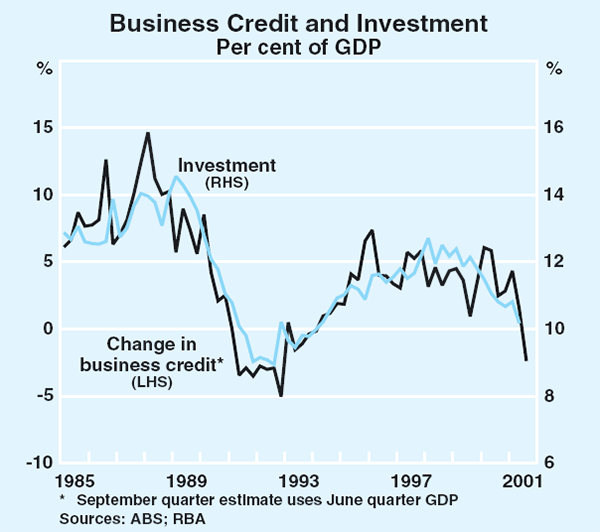
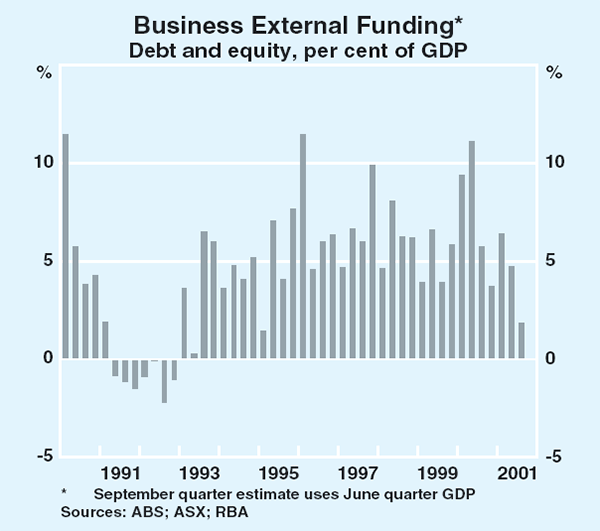
Commonwealth budget
The Government announced that the Commonwealth budget recorded an underlying cash surplus of $5.6 billion in 2000/01 (Table 10). This was around $2.8 billion higher than was originally estimated in May 2000, despite the fact that the economy's growth rate for the year was about half as strong as forecast. Tax receipts from both companies and individuals were considerably higher than initially expected (by about $6.7 billion or 1 per cent of GDP), partly due to the lower than expected take-up of deferral arrangements for paying company tax and perhaps reflecting an expansion of the tax base following the introduction of the new tax system. As a partial offset, however, government spending was also higher than forecast, due to several factors including the introduction of a range of discretionary spending initiatives mainly affecting the second half of the year.
| 1999/2000 | 2000/01 | 2001/02 | 2002/03 | |
|---|---|---|---|---|
| Budget, May 2001 | 12,671 | 2,253 | 1,520 | 1,063 |
| (2.0) | (0.3) | (0.2) | (0.1) | |
| MYEFO, October 2001 | 12,671 | 5,625 | 502 | 991 |
| (2.0) | (0.8) | (0.1) | (0.1) | |
|
Source: Commonwealth Treasury |
||||
In October, the Commonwealth Government updated its economic forecasts and estimate of the budget position in the Mid-Year Economic and Fiscal Outlook (MYEFO). The expected underlying cash surplus for 2001/02 was revised down by $1 billion to around $500 million, and the estimate for 2002/03 was broadly unchanged. The revision for 2001/02 reflected an upward revision to expenses arising from discretionary policy decisions and the effect of higher forecasts for CPI inflation and wages growth, although this was partly offset by upward revisions to revenue.
The revised estimates of the underlying cash surplus in recent and forthcoming years suggest that the fiscal impact on growth, including the contribution of automatic stabilisers and discretionary measures, was around 1¼ percentage points in 2000/01 and will be around ¾ of a percentage point this year. At this stage, state budget estimates imply that very little fiscal stimulus is likely to come from the states.
The labour market
Labour force data and partial indicators of labour demand indicate that conditions in the labour market continue to be weak (Graph 48). Employment increased by 0.5 per cent in the three months to October, to be 0.5 per cent above the corresponding period a year earlier. The participation rate has remained, on average, around 63.8 per cent over the past six months, and the unemployment rate has averaged 6.9 per cent. In October, however, the unemployment rate increased to 7.1 per cent.
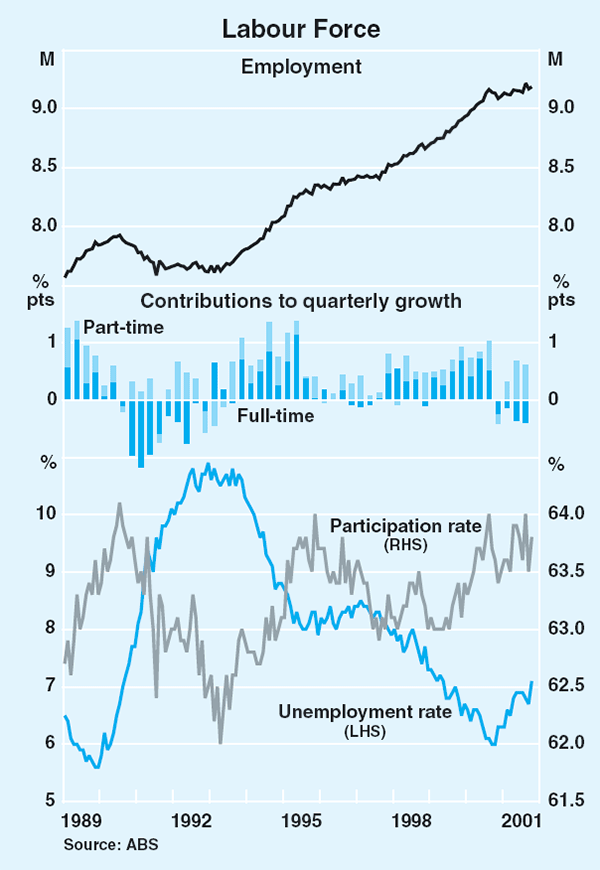
While total employment growth has been weak through most of the past year, the full-time and part-time components have exhibited markedly different trends and considerable volatility. Full-time employment has declined over the past year, to be 1.1 per cent lower in the three months to October than a year earlier. Part-time employment, on the other hand, increased by 5.0 per cent over this period. The considerable volatility from month to month in these components is difficult to explain. An increase in the proportion of workers who are working around 35 hours, the cut-off used by the ABS in its classification of workers as being full-time versus part-time, may have contributed. The temporary employment of workers by the ABS to conduct the Census is estimated to have had little effect on these figures. Interestingly, in previous periods of labour market weakness there have been similar increases in the monthly volatility of full-time and part-time employment, as well as similarly divergent trends in these components.
As is the case for developments in economic activity more generally, the aggregate employment numbers also mask divergent trends across industries (Table 11). Employment in the construction industry increased by 1.2 per cent over the three months to August, following a slight increase over the three months to May. While this growth appears to be relatively modest compared with the increase in construction output that the national accounts and forward indicators of dwelling construction activity have implied for the June and September quarters, it suggests that measured labour productivity in the construction industry may be in the process of returning to more normal levels, having fallen to very low levels during the second half of 2000. Employment in the manufacturing industry has remained weak, falling by 3.1 per cent over the three months to August following a small fall over the previous three months, largely due to continued falls in employment in the construction-related parts of the manufacturing sector. The weakness in the output of the business service industries over the last six months has corresponded with a decline in employment in these sectors. (See Box A on ‘The Service Sectors’ for a further discussion of these developments.)
| Industry share | Growth | ||
|---|---|---|---|
| 3 months to August |
Year to August |
||
| Public-related(a) | 21 | 2.4 | 5.1 |
| Retail and wholesale trade | 20 | 1.7 | 1.5 |
| Business services(b) | 18 | −2.4 | −0.2 |
| Manufacturing | 12 | −3.1 | −4.8 |
| Household services(c) | 12 | 1.4 | 1.9 |
| Construction | 7 | 1.2 | −5.3 |
| Mining and agriculture | 5 | 2.9 | 0.3 |
| Transport | 5 | 2.0 | 1.0 |
|
(a) Electricity, gas and water; public administration and defence; health;
education Source: ABS |
|||
The Victorian labour market has continued to be the most resilient of all the state labour markets, recording the highest growth in employment over the year to the latest three months (Table 12). Above-average growth in employment has also been recorded in both Western Australia and Queensland, over the past year, while employment in South Australia and Tasmania has fallen.
| Employment growth | Unemployment Rate | ||
|---|---|---|---|
| Three months to October |
Year to three months to October |
Three months to October |
|
| NSW | 0.2 | 0.1 | 6.3 |
| Victoria | 0.3 | 1.1 | 6.5 |
| Qld | 0.7 | 1.0 | 8.1 |
| WA | 0.5 | 0.6 | 6.9 |
| SA | 0.3 | −0.8 | 7.2 |
| Tasmania | 0.2 | −0.8 | 9.3 |
| Australia | 0.5 | 0.5 | 6.9 |
|
Source: ABS |
|||
Labour productivity, as measured by output per hour worked in the non-farm economy, increased by 1.2 per cent in the June quarter, after having exhibited little growth over the preceding year. Short-term developments in productivity always reflect both trend and cyclical movements, which cannot easily be separated, but productivity outcomes during the past year or so have been similar to the experience of the mid-1990s slowdown.
Forward-looking indicators of the labour market have been mixed. The major business expectations surveys, taken before the events of mid September, had recorded a significant improvement in the outlook for the labour market in the second half of 2001, on the back of the improvement in business conditions more generally (Graph 49). This improvement was not, however, reflected in the vacancies data. While the ANZ and Department of Workplace Relations and Small Business (DEWRSB) newspaper-based vacancy indexes had stopped falling, they were broadly flat over the six months to September. The ABS employer-based measure of vacancies fell by 3.5 per cent in the September quarter, although its pace of decline has also slowed. Since mid September, most surveys have presented a more subdued outlook for the labour market. The October DEWRSB and ANZ vacancies indexes both recorded declines, although these were not particularly large by historical standards. Overall, these forward-looking indicators suggest that employment will remain soft for a while yet.
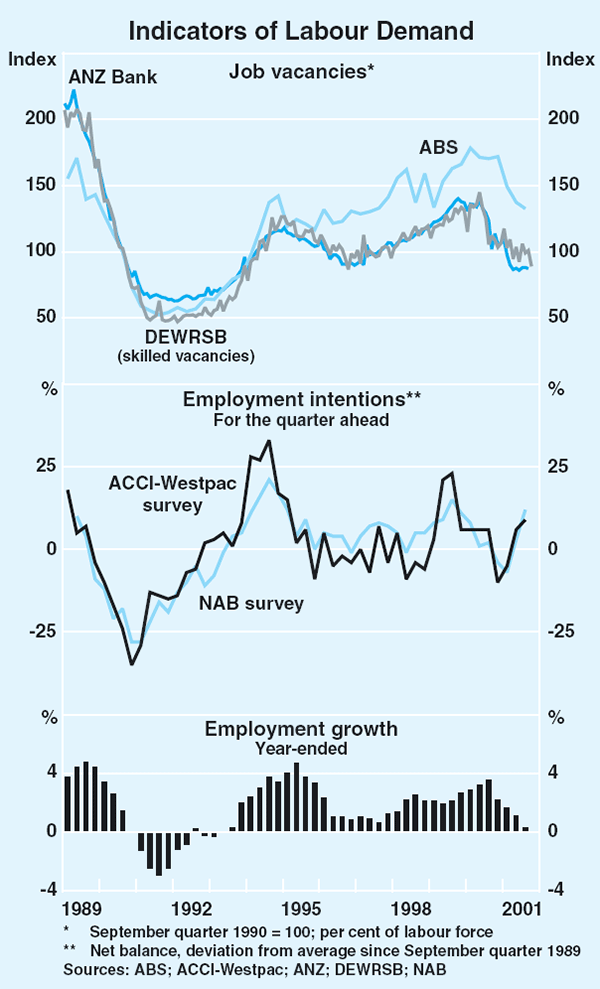
Box A: The Service Sectors
The service sectors have contributed strongly to economic growth in recent years. During the second half of 2000, in particular, growth in some service industries partially offset the weakness in output in those industries of the economy exposed to the downturn in dwelling construction (Graph A1). More recently, as the recovery of dwelling construction has gained momentum and growth in the goods-related sectors has thus recovered, there are signs that some service industries are slowing.
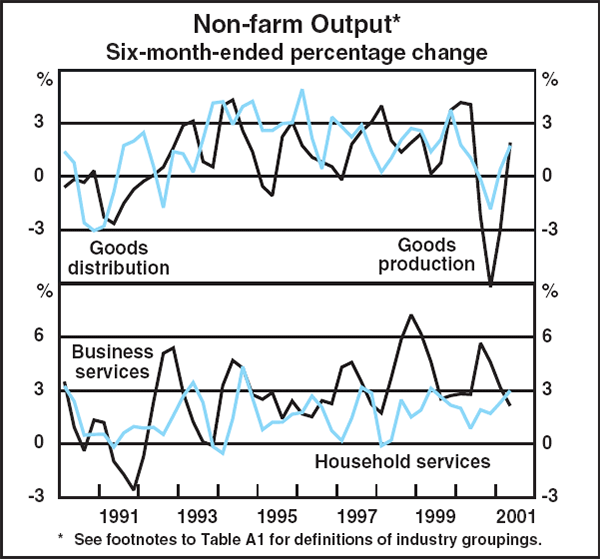
For this analysis the economy has been divided into four groupings, based on whether industries are primarily involved in goods production, goods distribution, supplying services to businesses or supplying services to households. On this basis, the service sectors, which encompass the latter two categories, account for around 45 per cent of total output and employment, about the same as the goods-related sectors (Table A1). Within the service sectors, services provided to businesses contribute the larger share of output, while those provided to households, which tend to be more labour intensive, account for a larger share of employment.
| Share of output 2000/01 |
Share of employment 2000/01 |
Average output growth 1992/93–1999/2000 |
|
|---|---|---|---|
| Goods production(b) | 25.4 | 21.5 | 3.7 |
| Goods distribution(c) | 16.4 | 24.2 | 5.1 |
| Business services(d) | 22.8 | 17.6 | 6.2 |
| Household services(e) | 17.8 | 27.9 | 3.4 |
|
(a) The propensity of an industry to service households versus businesses
was determined using input-output tables, and an industry was deemed
to supply households if more than 50 per cent of its total supply was
allocated to final consumption by households. Source: ABS |
|||
During the past decade, growth in the service sectors has, on average, been greater than that in the goods-related sectors. In the past few years, growth in the business services industries has been particularly rapid, reflecting several factors such as the preparations for Y2K, the new tax system, and, to a lesser extent, the Olympics, as well as the expansion of telecommunications networks following the deregulation of the domestic telecommunications industry. Each of these developments created a large temporary increase in demand for specialist services, especially in the fields of information technology and communications (ITC), accounting and consultancy. The reduction in demand from these sources would have, of itself, contributed to a slowing in activity in the business services sector. It has, however, been exacerbated by the global downturn in ITC activity, and the more general cyclical slowing in growth that has taken place.
In recent years, growth in the household services sector has also been relatively strong, underpinned by growth in the health, accommodation, cafes and restaurants, and personal services industries. Over the past year, the resilience of the household services sector has been due mainly to the continued strength in demand for health services, with an easing in demand being recorded in many of the other major components. As discussed in the section on household consumption, the strength in demand for health services appears to be largely because of federal government incentives to take up private health insurance.
The disparate performances of the business and household service sectors has been reflected in the labour market. Business services employment is now lower than a year ago, the first such annual decline recorded since the early 1990s (Graph A2). Employment in household services, on the other hand, continues to grow relatively strongly.
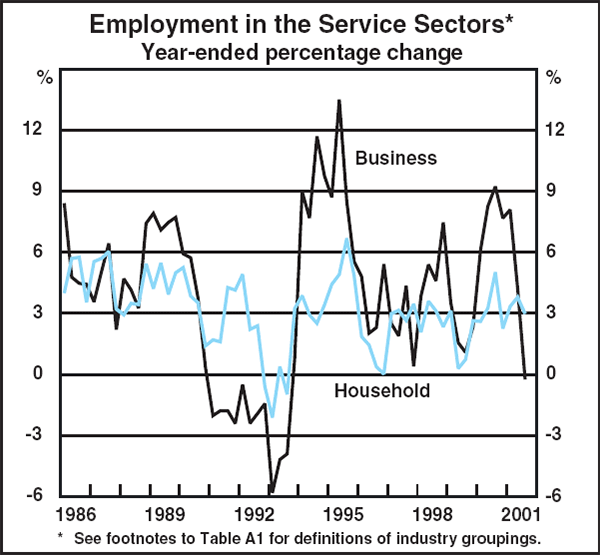
A continuation of the slowing in business services output is in prospect, with job vacancies falling sharply across a range of job types in the sector (Graph A3). This includes falls in vacancies in areas where special factors are no longer supporting demand – such as in ITC and accounting. However, falls are also evident in areas of the business services sector that are most exposed to changes in discretionary spending by firms, such as marketing and advertising.
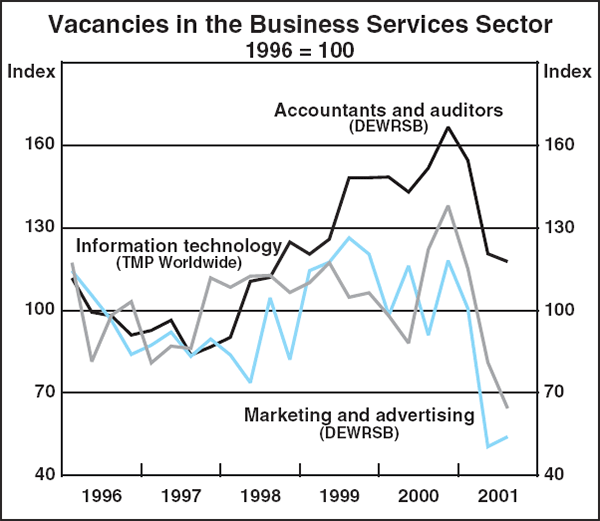
While services supplied to households have recently been supportive of growth, their growth is also likely to slow. The potential for further strong growth in health services, for example, could be limited as coverage by private health insurance reaches saturation levels. The recent reduction in domestic and international airline travel will also have reduced demand for tourist-oriented services during the second half of 2001.
Box B: The Tourism Industry
Tourism makes a significant contribution to economic activity in Australia and to Australia's exports. While measuring the size of the tourism industry is quite difficult, the ABS has estimated that in 1997/98, the tourism industry accounted for 4.5 per cent of GDP (Table B1). This implies that it is roughly similar in size to the education and mining industries. Over three-quarters of tourism output is consumed by domestic tourists, who mainly comprise households but also include businesses and government.[1]
| Domestic(a) | International(b) | Total | ||
|---|---|---|---|---|
| Households | Business/Government | |||
| Tourism expenditure ($m) | 38,770 | 6,596 | 12,792 | 58,158 |
| Tourism output ($m) | 17,026 | 2,755 | 5,394 | 25,174 |
| – as a per cent of GDP | 3.0 | 0.5 | 1.0 | 4.5 |
| Tourism share of employment (%) | – | – | – | 6.0 |
|
(a) Includes expenditure by outbound Australian residents before and after
overseas trips. Source: Australian National Accounts: Tourism Satellite Account, 1997/98, ABS Cat No 5249.0 |
||||
Many parts of the economy are involved in the provision of goods and services to tourists. Around two-thirds of tourism output, however, is contributed by the transport and storage, accommodation, cafes and restaurants, and retail and wholesale trade industries (Table B2). The transport and storage industry makes the largest contribution to tourism output, principally due to the use of air travel by both domestic and international tourists. The accommodation, cafes and restaurants industry, however, is the most tourism dependent, with around 36 per cent of its output directly attributable to the tourism industry.
| Share of tourism value-added |
Share of industry output attributable to the tourism industry |
|
|---|---|---|
| Transport and storage | 25 | 18 |
| Accommodation, cafes and restaurants | 20 | 36 |
| Retail and wholesale trade | 20 | 7 |
| Manufacturing | 11 | 4 |
| Cultural and recreational services | 5 | 12 |
|
Source: Australian National Accounts: Tourism Satellite Account, 1997/98, ABS Cat No 5249.0 |
||
The tourism industry is highly export oriented, contributing around 11 per cent of Australia's total export earnings even though it accounts for only 4.5 per cent of output (Graph B1). In part, this reflects the different characteristics of the international and domestic tourist markets. Although the high share of business tourists among domestic tourists implies that the average domestic tourist tends to spend much more per night than the average international tourist, over the course of their stay, the average international tourist spends considerably more (Table B3). This in turn probably reflects the fact that the average short-stay international tourist is relatively high spending, while there are also a significant number of international tourists (for example, backpackers) who, although not wealthy, spend a considerable amount because of the length of their stay.
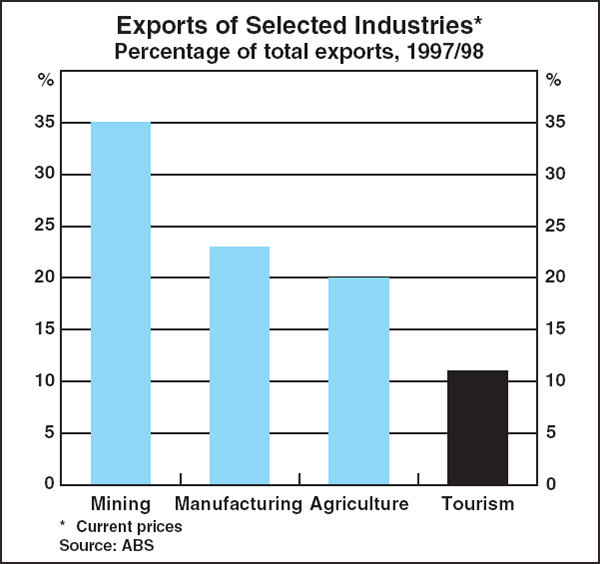
| Domestic tourists(a) | International tourists |
|||
|---|---|---|---|---|
| Households | Business | Total | ||
| Tourists (million) | 59 | 15 | 74 | 4 |
| Tourist nights (million) | 249 | 45 | 293 | 113 |
| Average nights per tourist | 4 | 3 | 4 | 26 |
| Average expenditure per tourist(b) ($) | 459 | 647 | 496 | 2168 |
| Average expenditure per night(b) ($) | 109 | 212 | 125 | 83 |
|
(a) Overnight travel within Australia by Australian residents. Sources: National Visitor Survey and International Visitor Survey, Bureau of Tourism Research |
||||
Recent developments
The collapse of Ansett and the US terrorist attacks were associated with a sharp fall in airline travel. Given that air transport makes a large direct contribution to the output of the tourism industry and facilitates tourism more generally, the recent downturn in airline travel has had a significant and immediate effect on the tourism industry.
Ansett accounted for approximately 40 per cent of the domestic aviation market (both passenger and freight) and around 3½ per cent of international passenger movements to and from Australia. There has been a sizeable decline in domestic air services in the past couple of months, although liaison suggests that it has been much less than during the pilots' strike of 1989 (Graph B2). The magnitude of the fall in international passenger movements is hard to establish, although the Tourism Forecasting Council has revised down its forecast for overseas arrivals in the December quarter by around 15 per cent.
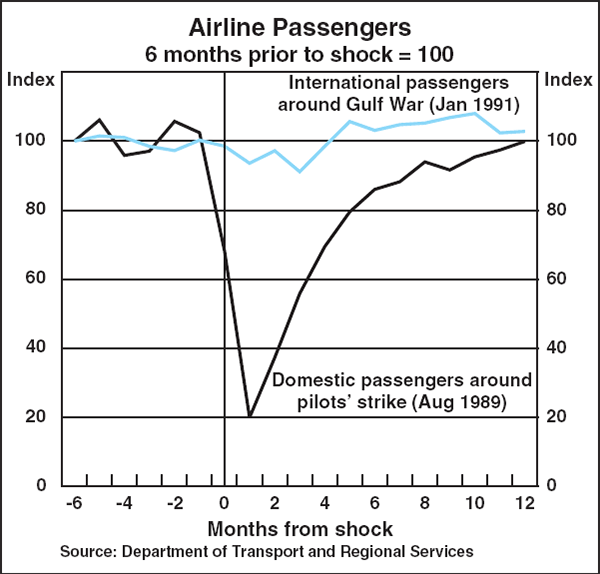
The effect on aggregate output in the economy of these developments is dependent on a number of factors. Most importantly, it depends on the initial size of the contraction in the tourism industry, and the extent to which domestic consumers substitute spending on other goods or services for the spending they would otherwise have directed towards tourist activities (both domestically and internationally). Secondly, it depends on the flow-on effects of these developments to other industries. Finally, it depends on the time it takes before both the capacity of the domestic airline industry is restored to satisfy demand and international tourism recovers.
It will be difficult to predict the relative sizes of these effects with any accuracy. Around 17 per cent of domestic tourists use airline travel as their main mode of transport, although much higher figures are recorded for the Northern Territory and Tasmania (Graph B3). The variation in these figures across states reflects both the feasibility and accessibility of alternative modes of transport and differing shares of interstate tourists. Overall, however, these data illustrate that a large proportion of domestic tourists are not reliant on air transport, and they suggest that there may be some scope for substitution as, for example, domestic tourists choose holiday destinations to which they can drive rather than fly. If Australia benefits from a safe-haven status, it could also encourage the replacement of overseas travel with domestic travel and attract international tourists from other destinations. The latter factors appear to have played a role during the Gulf War, and the former during the pilots' strike. In both cases, aggregate economic activity was little affected by the significant shocks to airline travel that occurred.
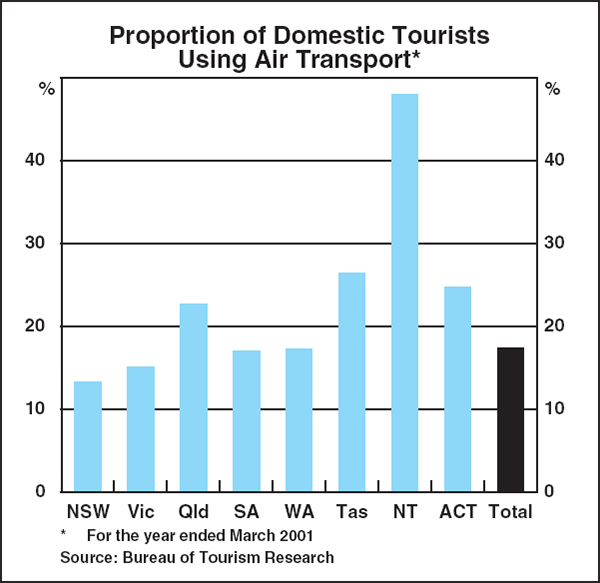
However, there are also forces that may inhibit the recovery of tourism and so generate more pervasive effects on economic activity. The weakened financial position of creditors to Ansett, particularly small businesses, may inhibit spending. Heightened concerns about flying could also imply that it takes longer before the demand for tourist-related activities recovers. More generally, given that tourist expenditures are to some extent discretionary, and given the tourism industry's reliance on exports, it may be more exposed than most industries to any further deterioration in domestic and global prospects.
Balance of Payments
The slowdown in the world economy over the course of the year has been reflected in slower growth in export volumes and a decline in the world price of a number of commodities, both exported and imported by Australia. The low level of the exchange rate, however, has helped insulate the economy from the full effects of moderating external demand. Import volumes continued to fall in the September quarter, offsetting a decline in export volumes, so that net exports are likely to have had little impact on GDP growth in the quarter, after adding two percentage points to growth over the year to the June quarter. Primarily reflecting the likely rise in the terms of trade in the September quarter, the trade surplus widened further, after the first surplus in four years was recorded in the March quarter (Graph 50). Consequently, the current account deficit is likely to have narrowed further from its 20-year low in the June quarter, to be around 1¾ per cent of GDP in the September quarter, assuming no change in the net income deficit as a share of GDP.
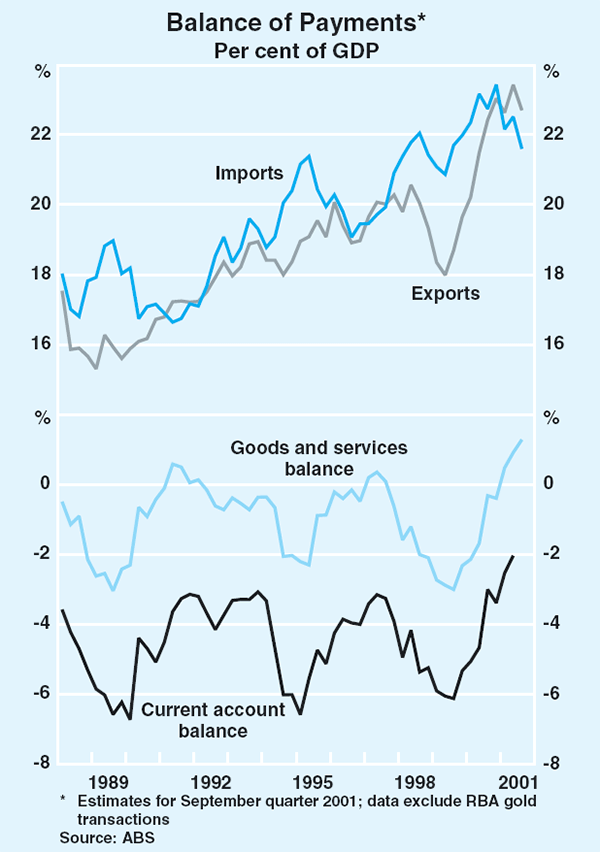
Some of the narrowing in the current account deficit over the past couple of years is the result of an improvement in Australia's terms of trade, which have risen by about 9½ per cent from the Asian-crisis lows. The rise in the terms of trade has also provided a significant boost to domestic incomes and living standards. It is unusual for Australia's terms of trade to be rising at this stage of the world economic cycle, and this reflects the strength in some export prices, particularly coal and beef prices, as well as falling prices for electronic goods, which Australia imports. The weaker world outlook may be reflected in falls in the prices of rural and resource commodities in the period ahead, but the effect on the terms of trade will be limited by the prospect of further falls in the prices of electronics and other manufactured goods.
The value of exports fell in the September quarter, but is still 6 per cent higher over the year. The decline was particularly large in manufactured exports. Merchandise export growth to most regions has slowed over the past year, though this has been particularly noticeable for exports to those regions experiencing the sharpest downturns, such as countries in east Asia (Graph 51). The slowing in demand from the ITC-producing countries, such as Singapore and Taiwan, has been most pronounced. Growth in exports to Japan, while slowing, has been underpinned by firm demand for resources and, to a lesser extent, rural products. The strongest growth in the value of merchandise exports over the past year has been to China, where export values have risen by just under 40 per cent. These exports may receive a further boost following China's accession into the WTO. With growth in the major regions slowing simultaneously, however, Australian exporters will find it more difficult to divert products to alternative markets than was the case during the Asian crisis.
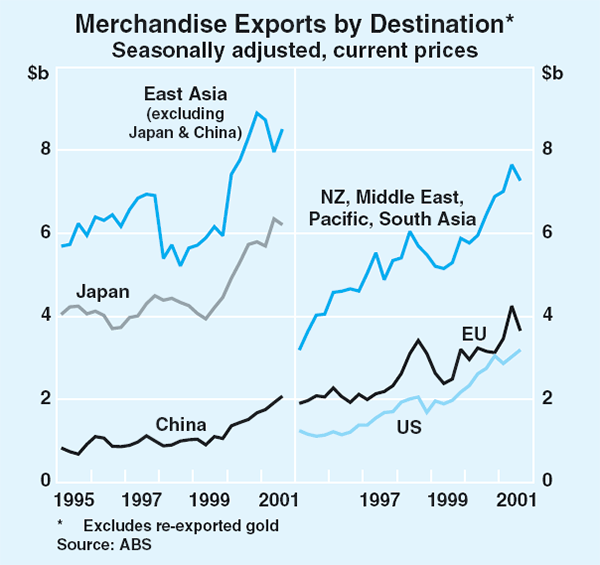
The value of resource exports fell in the September quarter, though this followed a large rise in the previous quarter (Graph 52). After adjusting for probable movements in resource prices in the September quarter, there appears to be some levelling out in resource export volumes over the past few quarters. Looking ahead, the low levels of spending on exploration and investment in mining in recent years will continue to limit growth in production. According to the Australian Bureau of Agricultural and Resource Economics (ABARE), Australian mine production will rise by around 1 per cent in 2001/02, compared with an increase of nearly 7 per cent in 2000/01. Production of base metals is forecast to increase by around 2 per cent in 2001/02. Production of energy is forecast to remain fairly flat with a moderate expansion of production in the coal, uranium and gas industries being offset by lower output of crude oil owing to a decline in productivity of a number of mature oil fields.

The value of rural exports has continued to rise due to high levels of production and firm prices. The gains have been particularly marked in meat exports, although growth in the Japanese market, which accounts for more than one-third of Australia's beef and veal exports by weight, has slowed recently following the discovery of ‘mad cow’ disease in Japan. The value of cereal exports has been flat this year as production has fallen from the very high levels recorded in the past three years. Higher livestock prices have also encouraged some substitution away from crops. Wool exports have softened due to wool supply being at an historic low. According to ABARE, the volume of farm production is expected to increase by a little over 1 per cent in 2001/02. Increases in beef and veal production are expected to be partially offset by small declines in crop production and a reduction in the supply of wool.
The manufacturing and service export sectors tend to be most affected by weakness in the world economy (Graph 53). Manufactured export volumes, after growing by 17 per cent over the year to the March quarter, fell in the June quarter and are likely to have fallen again in the September quarter, reflecting the weakness in Australia's trading partners, with a marked slowdown in exports of machinery. Growth in service exports, after abstracting from the Olympics, has moderated over the past year, although the value of service exports rose in the September quarter, boosted by a pick-up in sports-related arrivals. However, overseas arrivals fell by 4 per cent in September, with sharp falls in arrivals from the US and Japan.
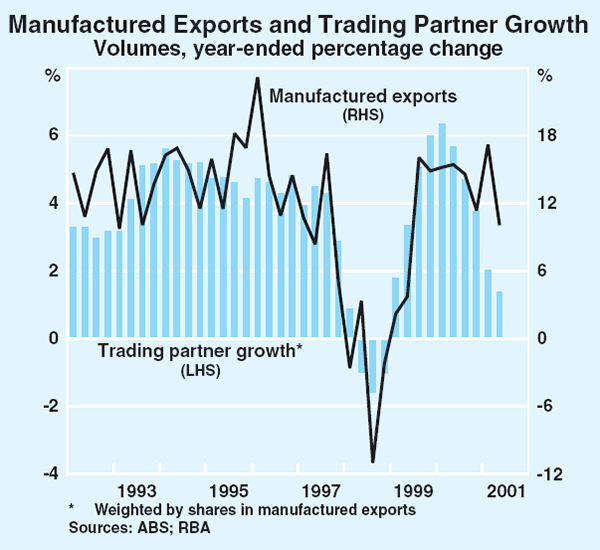
The slower growth in domestic demand over the year to June, combined with the low exchange rate, was reflected in a fall in import volumes over the past year (Graph 54). The decline in import volumes has been broad-based, with large falls recorded in imports of capital and intermediate goods, both of which declined by more than 9 per cent over the year to June (Graph 55). The outcome for capital goods was in line with weak investment over the past year, though the disproportionately large fall in capital imports suggests that firms may have increasingly sourced their capital goods from domestic producers, most likely in response to higher capital import prices. The import penetration ratio has steadied over the past year or so, after being on a strong upward trend for most of the 1990s.
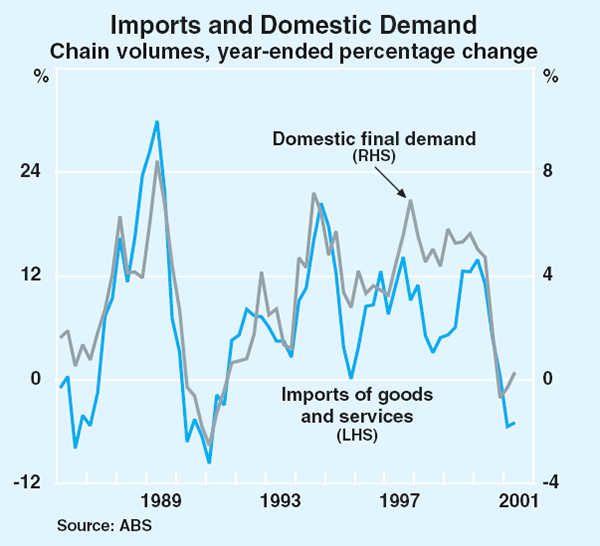
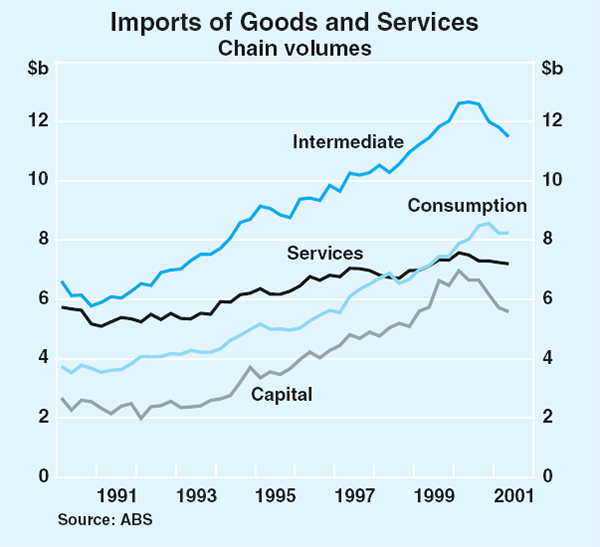
The net income deficit in the June quarter remained around 3 per cent of GDP, where it has been for more than three years. The ratio of net interest payments to exports fell to under 9 per cent in the June quarter owing to payments on net debt declining as interest rates fell, and exports rising. This compares with a peak of over 20 per cent in 1990.
There were substantial net equity inflows and debt outflows in the June quarter, in contrast to the trend evident since mid 1999. There has been a noticeable pick-up in net portfolio equity investment inflows from the US in 2001. Australia's net foreign debt fell in the June quarter to $311 billion, or 46 per cent of GDP, though this was offset by an increase in net foreign equity liabilities (Graph 56). Overall, net foreign liabilities remain at just under 60 per cent of GDP.
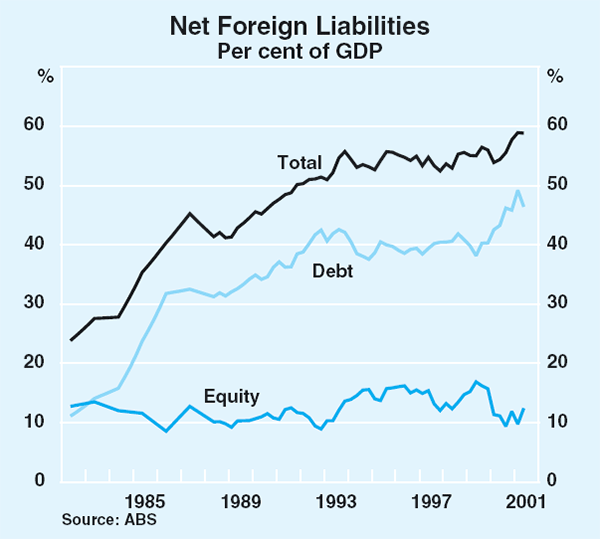
Commodity prices
The RBA commodity price index has fallen in foreign-currency terms by a little over 2 per cent from its peak in June, although it is still about 15 per cent higher than the trough recorded in the first half of 1999. The trend in this index has been quite different to that of some other commonly used indexes, notably the CRB index (Graph 57). This reflects the stronger performance of key rural and resource prices over the past year. In Australian dollar terms, commodity prices are at very high levels and are 43 per cent higher than the low point reached in early 1999, partly due to the depreciation of the exchange rate since then.
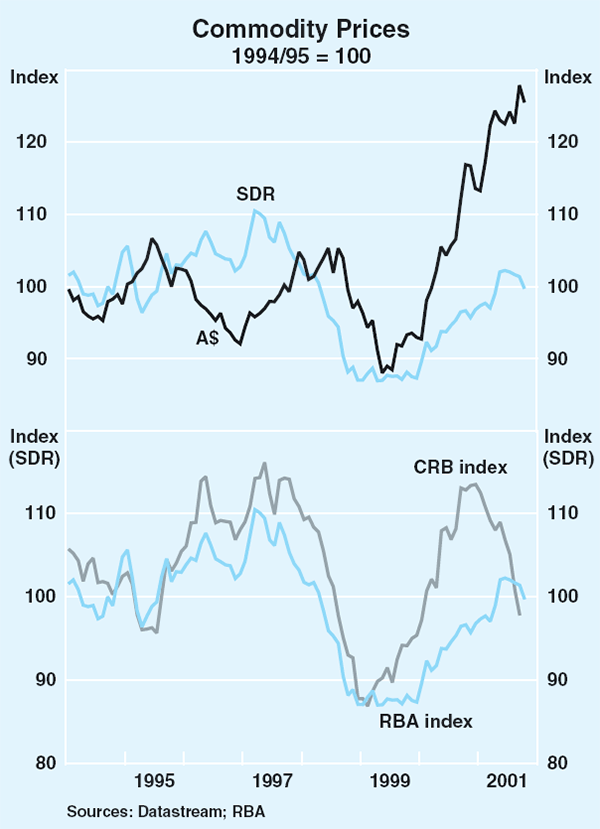
Rural commodity prices have risen over the course of this year, but prices for some rural commodities have begun to ease over the past month or so (Table 13). Beef and veal prices remain high as restrictions on South American beef exporters, arising from concerns about foot and mouth disease, and drought conditions in parts of the US have limited global supply. Wool prices, however, have edged lower as Chinese demand has softened and European buyers have been largely absent from the market.
| October | Latest 3 months |
Year to latest 3 months |
|
|---|---|---|---|
| Rural | −4.2 | −0.8 | 3.3 |
| – beef and veal | −3.6 | 11.8 | 23.6 |
| – wool | −6.8 | −8.4 | −0.5 |
| – wheat | 1.7 | −0.2 | 11.2 |
| – sugar | −15.3 | −17.5 | −23.1 |
| Base metals | −3.6 | −12.1 | −18.0 |
| – aluminium | −4.1 | −11.3 | −12.3 |
| – copper | −3.0 | −13.1 | −24.2 |
| – nickel | −4.0 | −23.3 | −35.7 |
| – lead | 1.3 | 1.2 | −0.7 |
| Other resources | 0.2 | 1.4 | 12.9 |
| – gold | 0.3 | 1.5 | 3.9 |
| RBA Index | −1.7 | −1.2 | 4.9 |
| Memo items: | |||
| Oil in US$ (a) | −15.8 | −8.0 | −22.6 |
| Coal in US$ (b) | −0.1 | −3.9 | 28.3 |
| (a) Oil prices are not included in the RBA Index. (b) Spot price for steaming coal from the Australian Coal Report; latest observation is for September. |
|||
Base metals prices have continued to fall, reflecting the deterioration in the outlook for world growth (Graph 58). Aluminium prices, which had held up early in the year due to the effects of production cuts in the US, have resumed their downward trend, in line with most other base metals prices. Demand from the automotive, consumer durable and engineering sectors in the US has declined quite sharply, while falling electricity prices have increased the possibility of an expansion in US production. Nickel and copper prices have been under considerable downward pressure following slowing demand and a consequent build-up in inventories.
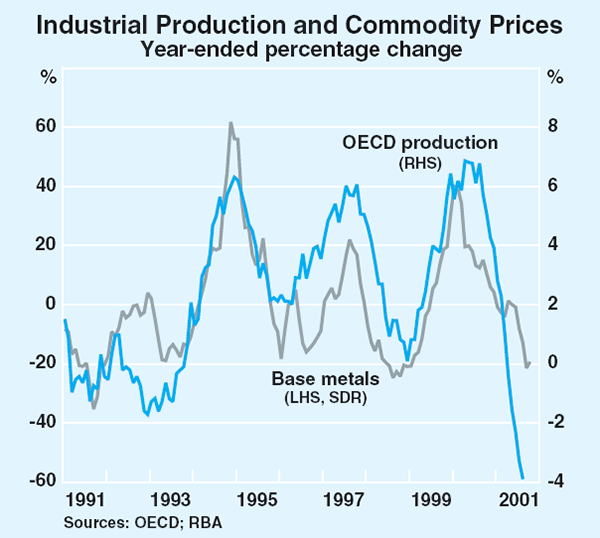
The price of gold rose to over US$290 an ounce following the terrorist attacks in the US, with the commodity receiving some ‘safe-haven’ support. It has since returned to around US$270, where it has traded for much of the past year. In Australian dollar terms, however, the gold price is back around the highs of the Asian financial crisis. Preliminary negotiations are under way for next year's round of price-setting for coal and iron ore contracts. Spot prices for thermal coal have eased recently, though they remain close to the contract prices due to tight supply conditions. Industry analysts expect reductions in world steel production to limit any upward pressure on iron ore and coking coal prices.
After spiking briefly following the terrorist attacks on the US, oil prices have fallen below the bottom of OPEC's target range, with the benchmark West Texas intermediate oil price now trading at around US$20 a barrel, a two-year low (Graph 59). The weaker global outlook was the main factor behind the fall. Despite the approaching northern hemisphere winter and talk of OPEC production cuts, oil prices are expected to remain subdued in the near term, reflecting softness in world demand.

Some of Australia's imports are also experiencing long-term price declines typical of the trend decline in the prices of rural and resource commodities that has occurred over past decades. Telecommunications and data processing equipment, which account for just under 10 per cent of Australia's imports, have experienced large price reductions over the past ten years. This primarily is a result of the fall in the price of electronic hardware underpinned by sharp declines in the price of memory chips, as well as falling software prices reflecting technological innovations. Lower prices for a range of internationally traded manufactured goods have also been a feature of recent years.
The fall in import prices, which has been particularly marked since the mid 1990s, has contributed to a rise in the terms of trade, boosting living standards in Australia (Graph 60). The terms of trade have risen almost continuously since their late-1998 trough. More recently, the fall in technology-related prices has provided a significant boost to the terms of trade in circumstances during which, historically, the terms of trade have tended to decline.
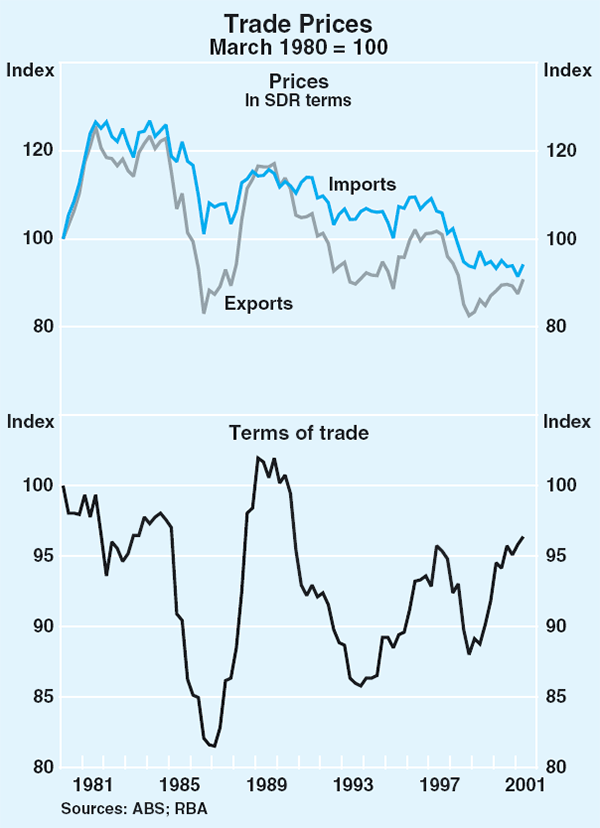
Domestic Financial Markets
Market interest rates
Renewed concerns about prospects for the global economy have seen further significant falls in market interest rates on both short and long-term debt in Australia in recent months. This trend accelerated late in the quarter following the terrorist attacks in the US.
Around the middle of the year, expectations for further monetary easing in Australia had largely disappeared as markets increasingly recognised the continuing good performance of the domestic economy. In August, however, expectations of a further easing in domestic monetary policy began to emerge. The main force behind this was the increasing gloom about the global outlook, as this was seen as eventually weighing on the domestic economy. Concerns about the international economy have continued to be an important influence on markets since. They were reinforced by the events of 11 September.
The first easing of monetary policy took place on 5 September, and although the money markets took it in their stride, there were some views expressed doubting the need for action at that time. The second easing a month later, and therefore after the events of 11 September, was fully anticipated and caused no reaction. The two reductions have taken the cash rate to 4.5 per cent, 25 points below the previous low which occurred in both the late 1990s and early 1990s (Graph 61). Comparisons further back in history are complicated because targets for the cash rate were not announced before the 1990s, but the last time the cash rate had averaged a level this low over a month was in 1973.
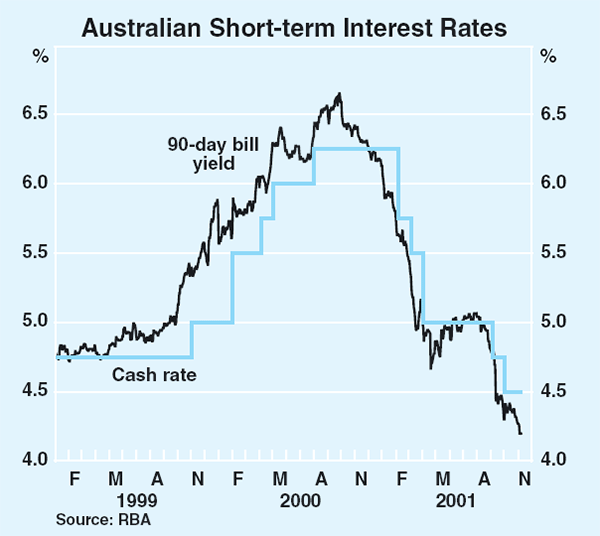
Yields on 90-day bank bills have fallen a little more than the cash rate in recent months as markets have priced in additional monetary easings in the months ahead. Yields are currently at 4.2 per cent, compared with a little over 5 per cent in early July. Like the cash rate, the current level of bill yields is the lowest for about 30 years.
The decline in interest rates in Australia has been smaller than has occurred in the US. Hence the spread between the cash rate in the two countries has widened to 250 basis points from 125 basis points in mid year (Graph 62). Markets expect this differential to narrow a little over coming months.
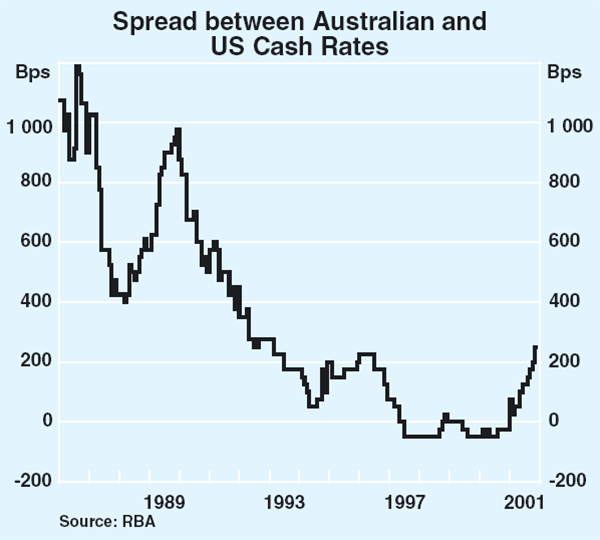
A positive spread between Australian and US cash rates has been the norm, though there was an unusual period in the late 1990s when the Australian rate was below that in the US. The current spread is higher than in the mid 1990s but lower than that in the early 1990s.
Yields on medium and long-term bonds in Australia have also declined by significant margins in recent months. Bond yields started the September quarter at their highest levels for 2001. However, the deterioration in the global economic outlook that emerged midway through the quarter and the consequential concerns about Australia's growth saw bond yields fall sharply from around 6.25 per cent in July, to around 5.50 per cent by early September. The terrorist attacks in the US resulted in further modest declines in long-term interest rates, as did the lower-than-expected CPI outcome in late October. Yields on 10-year bonds are now around 5.0 per cent, around 120 basis points lower than at the start of July (Graph 63).
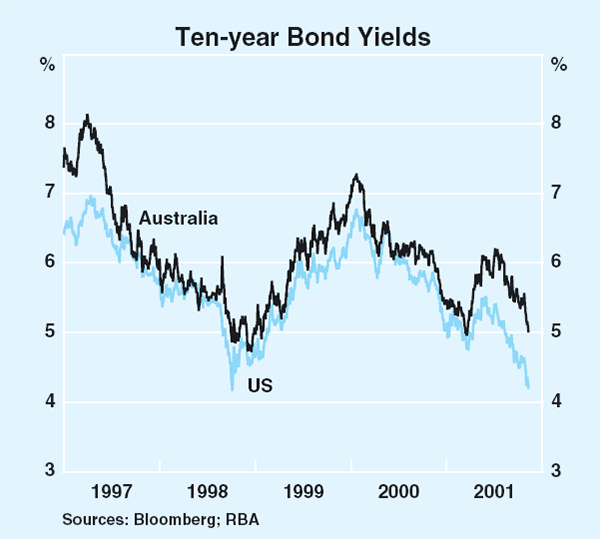
The differential between Australian and US bond yields – which had widened significantly over the June quarter as prospects for the two economies diverged – has tended to move in a fairly stable range of between 70 and 100 basis points over recent months. Most recent trading has been around 85 basis points.
The events in the US on 11 September generated a sharp increase in banks' demand for liquidity when Australian markets opened the following day. Like other central banks, the RBA responded with substantial injections of liquidity to meet the demand (see Box C). In the event, the payments system was able to continue operating normally, although trading in some securities markets remained subdued for several days.
Interbank price-making in the underlying market for Treasury and semi-government bonds was very limited for a few days after the terrorist attacks and client business was undertaken on a ‘best endeavours’ basis. In contrast to the lower activity in physical bond and repo markets, trading in interest rate futures and options on the Sydney Futures Exchange was little affected in the aftermath of 11 September. The futures market played an important role in facilitating risk management and price discovery through this period.
Corporate bond yields have fallen in recent months, but not as much as government yields – i.e. there has been a rise in the credit spreads on corporate bonds (Graph 64). The events of 11 September were an important factor. Except for the lowest-rated bonds, about three quarters of that rise has now been reversed.
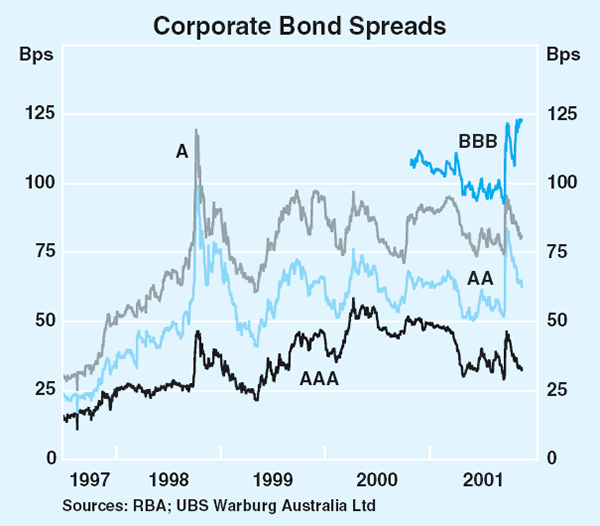
There was virtually no trading in the corporate bond market in the first two days after 11 September. While trading of domestic issues resumed on Friday 14 September, market-makers were reluctant to trade bonds issued by US investment banks and insurance companies because of their direct exposure to US events. Although trading in AAA-rated bonds and bonds issued by Australian banks returned to normal levels by 20 September, for the overall market trading volumes were around one-third their normal level. The Australian experience was similar to that seen in overseas markets; trading in investment-grade bonds was running at about a third of normal volumes in the US and Europe in the week ending 21 September.
Australian credit spreads remain well below US spreads. In the US, adjustment to the 11 September shock has come through a sustained widening in spreads rather than a decline in issuance volumes, which have continued at high levels (Graph 65). By contrast, adjustment in our market (and the European market to some extent) is working mainly through quantity (see ‘Debt markets’ below).
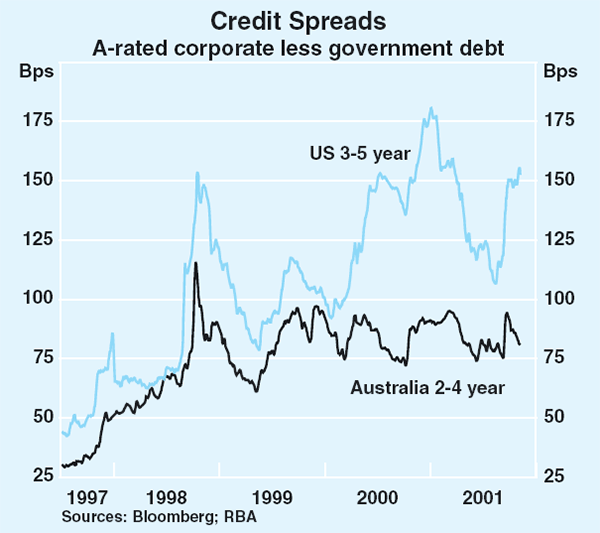
Intermediaries' interest rates
Reductions in the cash rate target in September and October were passed on completely and quickly to almost all borrowers offering residential property as security (ordinary mortgages, home equity personal loans and residentially secured small business loans). Interest rate reductions have been smaller for small businesses offering other security, and for credit card borrowers.
All types of mortgage lenders have passed on in full to residential mortgage rates both the September and October easings in policy (Graph 66). The current average standard variable rate of the banks, at 6.3 per cent, is 20 basis points below the previous cyclical low in 1999 and is at its lowest level since March 1970. The average basic rate fell to 5.75 per cent, the lowest mortgage rate since July 1968.

In the case of small business loans, not all banks have passed reductions in the cash rate on to all types of loans. Whereas the margin between the cash rate and small business loans secured by residential property has remained roughly constant, the margins for other small business loans have widened in the past two months (Table 14). When combined with the increase that occurred in the first half of 2000, as banks increased some business lending rates independently of changes in the cash rate, the margin is now up to 40 basis points above its level in 1998/99.
| Current level (early November) |
Change since August 2001 |
Change since January 2001 |
Cyclical low 1998/99 |
|
|---|---|---|---|---|
| Household | ||||
| Mortgages | ||||
| – Standard variable | 6.30 | −0.50 | −1.75 | 6.50 |
| – Basic housing | 5.75 | −0.50 | −1.75 | 5.90 |
| – Mortgage managers | 6.00 | −0.50 | −1.80 | 6.10 |
| – 3-year fixed | 6.30 | −0.50 | −0.65 | 6.40 |
| Personal lending | ||||
| – Residential secured | 6.45 | −0.55 | −1.75 | 6.60 |
| – Credit cards | 15.90 | −0.10 | −0.80 | 15.25 |
| Small business | ||||
| Residential secured: | ||||
| – Overdraft | 6.95 | −0.45 | −1.65 | 6.95 |
| – Term loan | 6.45 | −0.55 | −1.65 | 6.65 |
| – 3-year fixed | 6.20 | −0.80 | −0.80 | 6.50 |
| Other security: | ||||
| – Overdraft | 7.60 | −0.40 | −1.60 | 7.45 |
| – Term loan | 7.15 | −0.30 | −1.55 | 7.05 |
| Large business | ||||
| – Overdraft | 8.05 | −0.45 | −1.70 | 7.95 |
| – Term loan | 7.95 | −0.45 | −1.65 | 7.90 |
| Cash rate | 4.50 | −0.50 | −1.75 | 4.75 |
|
Source: RBA |
||||
For mortgage and small business loans that carry a fixed interest rate, the interest rates at which new loans are being offered have fallen in line with rates in capital markets. The declines have brought most fixed rates to levels close to their low points of earlier this year and similar to the cyclical low points reached in 1998. Approvals for fixed-rate housing loans have remained below 10 per cent of total housing loan approvals so far this year (Graph 67).
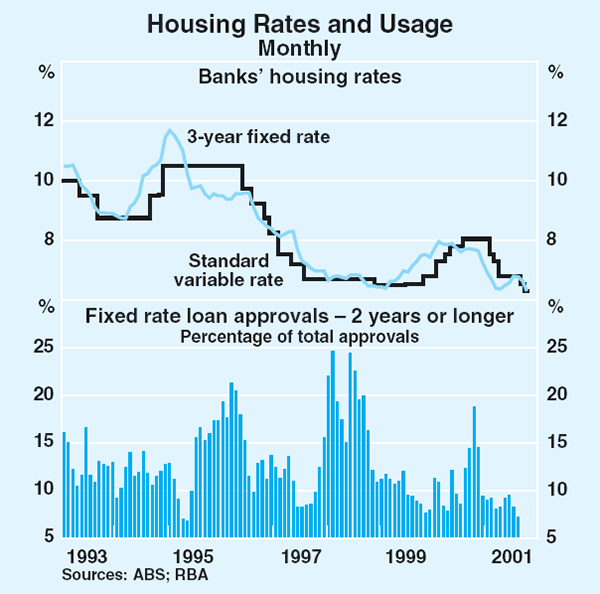
Capital markets developments
Debt markets
Domestic non-government bond issuance was again strong in the September quarter, totalling $9 billion (Graph 68). The proportion of issues in the form of asset-backed securities rose to about half. Issues of asset-backed securities have remained strong since the terrorist attacks, though issues of corporate bonds have fallen away (Table 15). Total non-government bonds outstanding are now just over $100 billion.
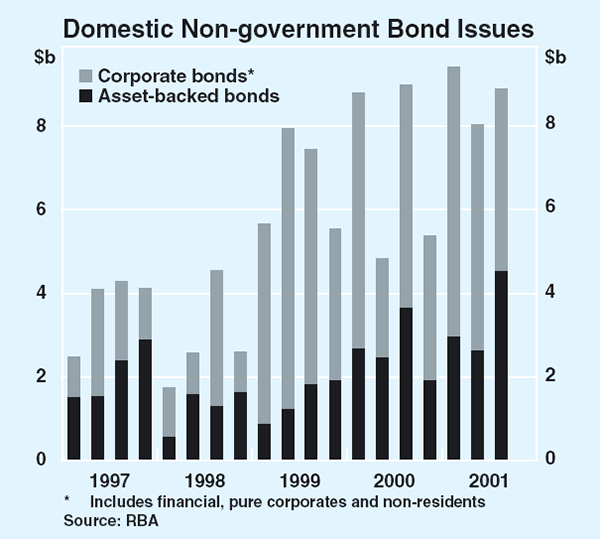
| Sector | 2001 | 2000 | 1999 | ||
|---|---|---|---|---|---|
| October | Sep qtr | June qtr | |||
| Financials | 0.40 | 1.7 | 1.0 | 5.1 | 10.1 |
| Non-residents | 0.10 | 1.2 | 2.4 | 3.5 | 5.6 |
| Corporates | 0.05 | 1.5 | 1.9 | 8.3 | 5.0 |
| Sub-total | |||||
| (Non-asset-backed) | 0.55 | 4.4 | 5.3 | 16.9 | 20.7 |
| of which: | |||||
| – Credit-enhanced | 0.00 | 0.9 | 1.2 | 3.8 | 0.0 |
| – Floating rate notes | 0.15 | 1.4 | 1.5 | 6.5 | 1.1 |
| Asset-backed | 0.80 | 4.5 | 2.7 | 10.6 | 5.9 |
| Total issuance | 1.35 | 8.9 | 8.0 | 27.5 | 26.6 |
|
Source: RBA |
|||||
The strong increase in asset-backed securities, most of which have been residential mortgage-backed, reflects solid demand for housing loans in the economy. There has been a strong appetite from overseas investors for these bonds, and an increased proportion of asset-backed deals has been placed directly in offshore markets. During the September quarter, about half of all asset-backed securities were issued offshore.
Although most asset-backed securities are backed by residential mortgages, the domestic asset-backed market has become more diverse, with issues of securities backed by car loans, yet-to-be completed residential units and non-conforming residential loans during the September quarter. (Non-conforming borrowers include those with a history of not meeting repayments or those whose credit history is difficult to establish, such as the self-employed and new migrants.)
The asset-backed sector was, briefly, adversely affected by the terrorist attacks in the US. Most issuers of residential mortgage-backed securities rely on mortgage insurance to support the credit quality of their securities. Ratings agencies placed a number of residential mortgage-backed securities on negative credit watch in the light of concerns about their mortgage insurer's exposure to losses in the US, though these were subsequently removed in mid October.
Issuance by corporates was a modest $1.5 billion in the September quarter. While issuance began the quarter strongly, it slowed in August and ground to a halt in September. Only four non-asset-backed issues have been placed in the domestic market since then. Broader concerns about corporate credit quality have also held back issuance. Out of the 114 rated entities in the corporate sector of Australia and New Zealand rated by Standard and Poor's, 32 corporates have been downgraded this year while only seven have been upgraded.
Issuance is expected to be boosted in coming months in order to refinance a large number of maturities of existing corporate bonds. Scheduled maturities over the December quarter amount to $4.4 billion, almost double the total volume of maturities observed throughout the previous three quarters (Graph 69). Prospective maturities for 2002 stand at $9.8 billion, compared with $6.7 billion in 2001.
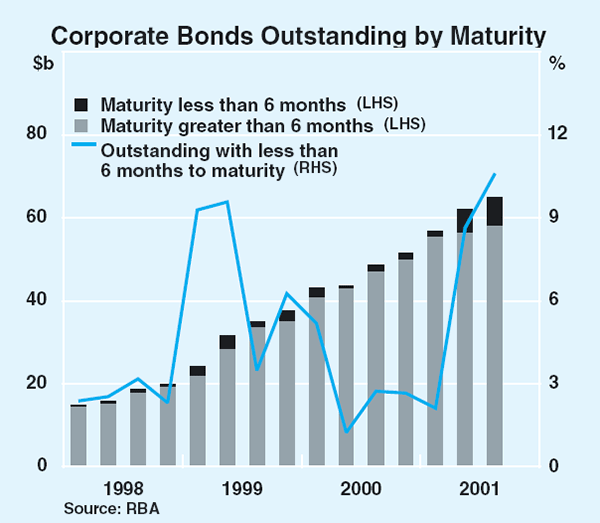
Changes to the associates test applied when determining whether debt security holdings are subject to interest withholding tax were announced in early September. Onshore associates (Australian residents or non-residents conducting business through a permanent establishment in Australia) of domestic debt issuers will now be exempt from interest withholding tax.
Equity markets
Whereas most share market indices overseas have been falling since early 2000, the Australian market continued to rise through to mid 2001. It did not experience the excesses seen overseas in earlier years, and therefore has not been not subject to the corrections now taking place overseas. Even though the Australian market fell over July and August, the falls were smaller than those overseas, so the relative performance continued to improve. The immediate reaction to the terrorist attacks was very similar across most countries, including Australia, as was the subsequent recovery (Graph 70).
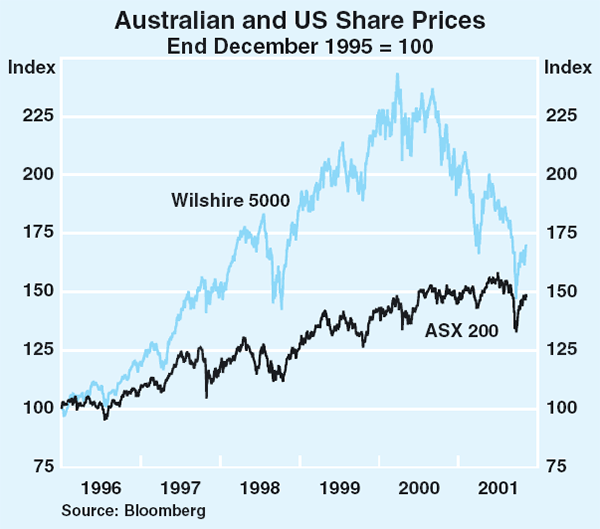
The Australian share market index is currently about 6 per cent below its peak, whereas markets in most overseas countries are down about 25–40 per cent from their peaks, most of which were in early 2000. This relatively strong performance of the Australian market has helped to close the gap that opened up between the Australian and overseas markets in earlier years. Since 1995, the Australian market has risen by a net 50 per cent, which is the same as the increases in the UK and Canada, though still less than the increase of around 70 per cent in the broad US indices. Part of the divergence between the Australian and the US markets can be attributed to the different policies relating to dividend payments and share buy backs in the two countries (see Box D).
The Australian share market remained open throughout September, and no operational problems were reported. Trading levels at the Australian Stock Exchange and in the market for Share Price Index futures at the Sydney Futures exchange were around historical norms.
In August and September most of the largest listed companies reported their results for the first six months of this year. Overall, profits were flat compared with those earned in the first half of 2000. These results were broadly in line with market expectations. Profits for the full year 2000 were up by 32 per cent.
Industrial companies' profits fell 6 per cent in the latest half year. This outcome was affected by the losses in the media sector due to weakness in advertising revenue and losses on investments. Banks performed strongly compared to the other sectors with a rise of 20 per cent. For industrial companies other than in the bank and media sectors, profits fell 3 per cent. Resource companies produced a 35 per cent increase in profits in the first half of 2001, higher than the banking sector.
During the course of the past year, analysts' expectations for earnings growth have been revised down. Downward revisions in earnings estimates through the year tend to be the norm, but those for 2001 were larger than usual (Graph 71). Currently, analysts expect full-year 2001 earnings per share to be only slightly above last year's results. Expected earnings per share are up by 15 per cent in 2002.
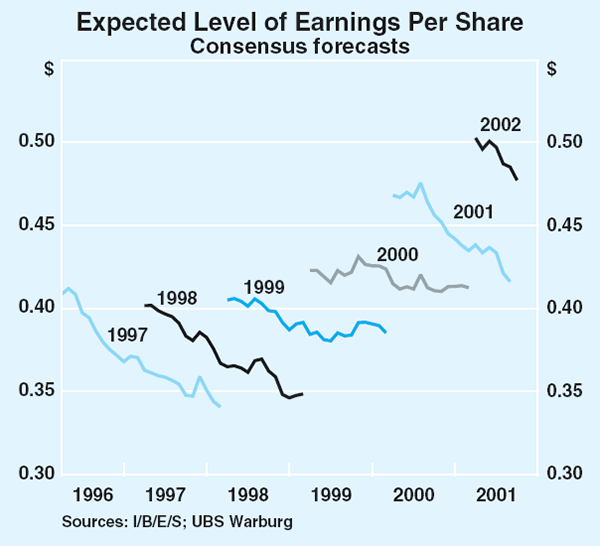
The Australian Price Earnings (PE) ratio has been fairly steady this year and is currently 23 (Graph 72). In contrast, the US PE ratio has risen over the past few months to stand at 29. This has occurred despite the fall in share prices, and reflects the very sharp falls in corporate profitability in that country.
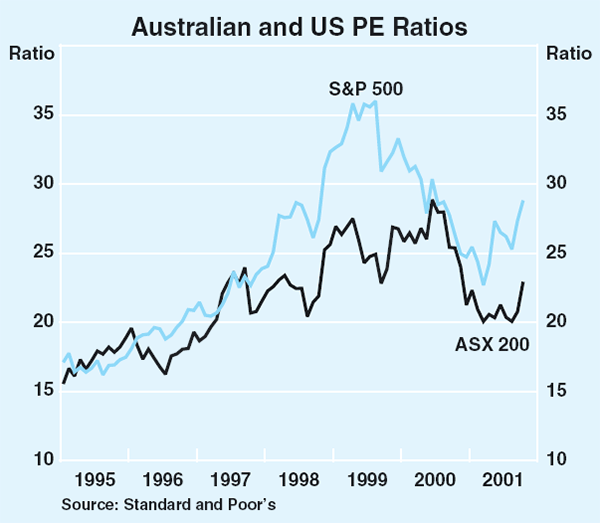
The 11 September events caused the deferment of some initial public offerings. For the September quarter as a whole, initial public offerings were slightly down on the levels seen in the previous quarter, with 15 companies raising a total of $297 million. Such raisings have slowed sharply in October.
In contrast, equity raisings by existing listed companies (for example, via placements and rights issues) have remained strong into October (Graph 73). During October, $1.5 billion was raised via placements. Moreover, the two largest raisings in October were oversubscribed.
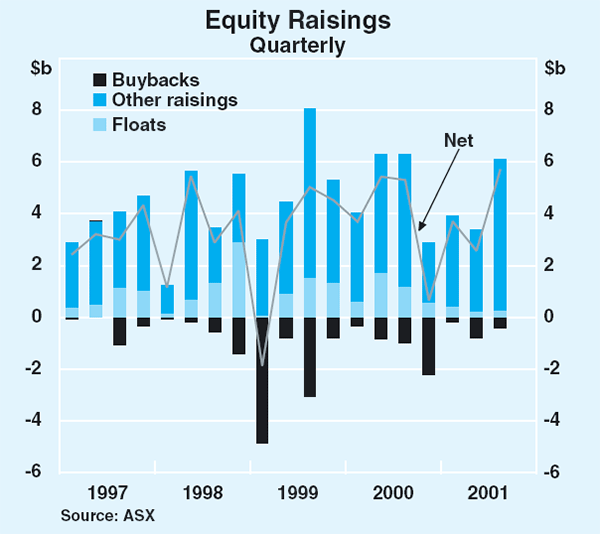
The strength of total equity raisings through the September quarter was not sufficient, however, to offset the slowdown in non-intermediated debt raisings and the fall in intermediated credit. Total business external funding was $3.2 billion, well below the levels seen in previous quarters.
Growth in margin lending for equities and managed funds during the September quarter was well down on the rapid growth seen in the previous 12 months (Table 16). There was almost no change in the average level of credit limit usage but average leverage increased slightly between the June and September quarters. In response to the volatility of markets during the month of September, the number of margin calls was high relative to past quarters.
| Level at end Sep 2001 |
Growth (per cent) | ||
|---|---|---|---|
| Three months to Sep 2001 |
Year to Sep 2001 |
||
| Total margin debt ($b) | 8.5 | 0.4 | 60 |
| Total margin loans approved ($b) | 13.1 | −0.6 | 17 |
| Credit limit use (per cent) | 64.9 | ||
| Value of underlying shares ($b) | 17.4 | −7.1 | 40 |
| Leverage (per cent) | 49.2 | ||
| Number of margin loans | 98,400 | 3.9 | 16 |
| Number of margin calls | 65,600 | 245 | 610 |
|
Source: RBA |
|||
Box C: Bank Liquidity in the Aftermath of 11 September
Central banks around the world sharply increased the supply of liquidity to their financial institutions in the aftermath of 11 September, to ensure that financial systems continued to operate without disruption. This box explains what that meant in the Australian context.
Broadly speaking, the ‘liquidity’ of an institution refers to its capacity to meet short-term financial obligations. In the case of banks, the core part of their liquidity is the current balances held with the central bank. Banks can draw on these at any time and receive instant value. In Australia, banks' funds at the RBA are held in Exchange Settlement (ES) accounts.
The supply of ES funds is controlled by the RBA through daily operations in the money market. The RBA varies the supply of ES funds so as to influence the interest rate at which banks borrow and lend funds to each other. This interest rate, known as the cash rate, is the rate in terms of which monetary policy changes are announced. When the RBA wishes to add funds to the banking system, it purchases securities, giving the seller funds in exchange. Sales of securities by the RBA reduce the supply of ES funds.
Banks' demand for ES funds is normally fairly stable, being based on their expected payment flows. Demand for ES funds can increase substantially, however, in times of uncertainty as banks are less confident about their payment flows and, as a precaution, seek to increase their holdings of liquid balances. Hence, one of the RBA's priorities on the morning of 12 September was to ensure that there were sufficient funds to meet banks' demand, in order to avoid disruption to markets and increases in interest rates. When markets opened in Australia on the morning of 12 September, the RBA issued a statement that payments and settlement systems were operating normally and that it would provide the financial system with liquidity as needed.
Early indications pointed to a sharp increase in the demand for liquidity on the day. Banks expecting to receive payments arising from international transactions were uncertain whether those payments would be received. As a result, they became less willing to lend funds themselves.
The RBA injected significant additional ES funds through its market operations on 12 September. In its normal dealing round (which takes place between 10 and 10.15 am) the RBA boosted the supply of funds to about $2.5 billion, or around three times the amount banks typically hold. The RBA normally only deals once a day but, on this occasion, it undertook a second round of market operations to add further funds later in the day when it was possible to form a clearer view on the demand for funds. This boosted the amount of funds that banks held in their ES accounts at the end of the day to over $5 billion (Graph C1).
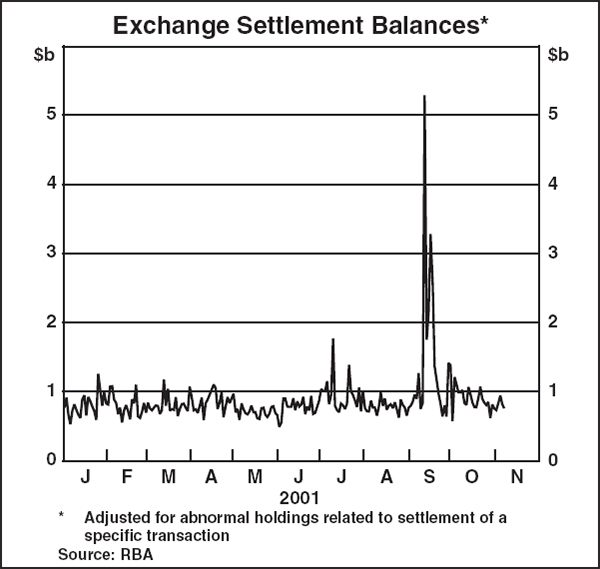
The demand for ES funds remained unusually high for a few days subsequently, with balances averaging about $3 billion over the week. By late September, normal conditions had returned to the market.
The increased supply of liquidity allowed the money market to continue to operate smoothly throughout the period, with the cash rate remaining very close to the target (Graph C2).
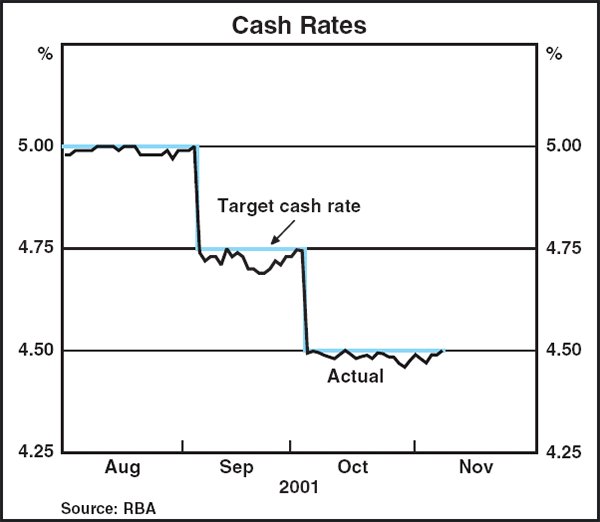
Box D: Share Market Performance and Share Buy Backs
Despite the weakness in the US share market over the past 18 months or so, US share prices have, on average, risen faster than those in Australia over the past decade (Graph D1). Since end 1989, the increase in the S&P 500 index has exceeded that in the ASX 200 by an average annual rate of 3.8 per cent. Many factors have influenced these outcomes. Amongst them are the low dividend payout ratio and the high level of share buy backs in the US.
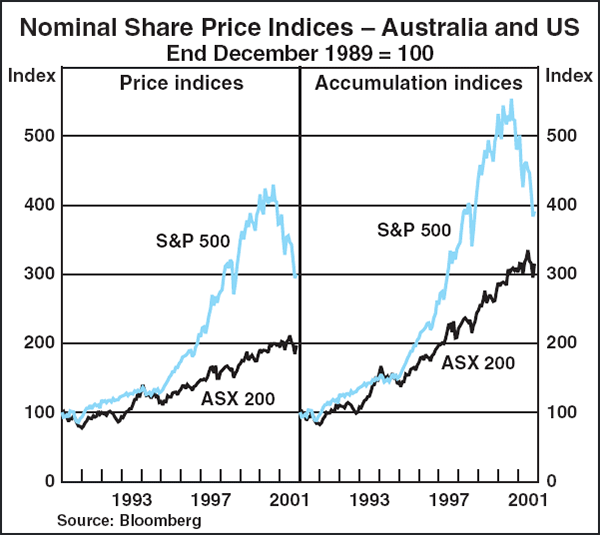
Dividends are very much a part of the return to shareholders and should be included in any assessment of relative returns. Since end 1989, the Australian ASX 200 Accumulation Index, which takes into account dividends, has recorded an annual compound rise of 10 per cent, compared with 12 per cent for the S&P 500 accumulation index (Table D1). This margin is substantially narrower than that in the respective price indices.
| Price index | Accumulation index | ||||
|---|---|---|---|---|---|
| ASX 200 | S&P 500 | ASX 200 | S&P 500 | ||
| 1989–2001 | 5.9 | 9.7 | 10.2 | 12.3 | |
| 1989–1995 | 4.9 | 9.7 | 9.5 | 13.1 | |
| 1996–2001 | 6.9 | 9.8 | 10.9 | 11.4 | |
| 1998–2001 | 5.8 | 2.3 | 9.6 | 3.7 | |
|
Source: Bloomberg |
|||||
The narrower margin between the US and Australian accumulation indices is due to higher dividend payments in Australia. Australia's dividend yield has averaged 4 per cent since end 1989, around double that of the US. This higher yield reflects a higher dividend payout ratio (around 80 per cent), which was encouraged by the introduction of dividend imputation in 1987. The earlier downward trend in the payout ratio has been largely reversed since (Graph D2). In contrast, the US dividend payout ratio has fallen sharply since the early 1990s, to now stand at about 40 per cent.
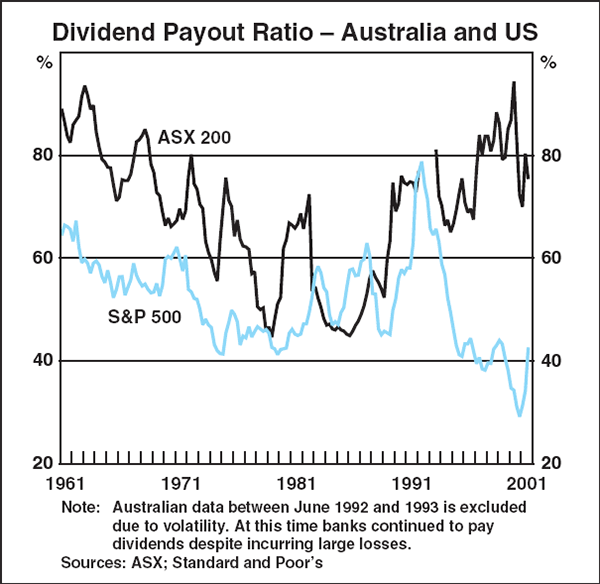
The effects of share buy backs on returns are more difficult to assess. In theory, it can be argued that share buy backs should not affect the price of a company's shares. To buy back its own shares a company must spend funds that it would otherwise have used to generate future income. A buy back, therefore, reduces a company's market value. But the number of shares outstanding is reduced by the same proportion, leaving the price per share unchanged.
On the other hand, empirical studies investigating buy backs in the US market find that buy backs lead to both a short-term price increase and longer-term market out-performance. In any event it should also be noted that, even if a buy back does not directly affect a company's share price, the share price will nonetheless be higher than if the company had paid an equivalent amount in dividends. A payment of dividends reduces the value of the firm but does not change the number of shares outstanding.
Total buy backs for the US equity market in the five years ending December 2000 amounted to over US$1 trillion, or 7 per cent of current domestic capitalisation. Australian share buy backs totalled A$28 billion over the same period, or 4 per cent of market capitalisation.
As a result of the high level of buy backs, the US equity market has recorded only four significant quarters of positive net equity raisings since 1995 (Graph D3). In comparison, Australia has had only one quarter of net buy backs in that period. The high rate of buy backs in the US has meant that US net equity raisings have averaged – 0.15 per cent of total market capitalisation since 1995, compared with an equivalent figure of 0.5 per cent for Australia.

In the US, both the non-financial and financial sectors have run down their equity stock over the last five years. Net raisings by the non-financial and financial sectors amounted to US$–761 billion and US$–93 billion respectively. The only sector to record positive net equity issuance has been foreign corporates, which made net raisings of US$456 billion. The use of buy backs in Australia has generally been modest, though significant use of them was made by financial institutions.
Assessment of Financial Conditions
Financial conditions have eased further since the last Statement, with the cash rate now at its lowest level in almost 30 years. Interest rates on loans from intermediaries and financial market debt instruments are also at historically low levels. While household borrowing continues to rise strongly, business financing has been more subdued, reflecting softer demand for funds. As described in the chapter on ‘Domestic Financial Markets’, the domestic equity market has been volatile, but remains within 6 per cent of its peak. The yield curve has maintained its positive slope and the exchange rate remains at an historically low level.
Interest rates
The 25 basis point reductions in the cash rate in September and October have taken the cumulative easing this cycle to 175 basis points. The magnitude of the easing cycle remains comparable to most major countries, with the notable exception of the US where the relatively weaker outlook has prompted a more aggressive monetary policy response.
While changes in interest rates attract much attention and can have an influence on consumer and business sentiment, the level of interest rates is likely to be of greater importance for economic activity. In both nominal and real terms, interest rates across the yield curve and most lending rates of intermediaries are at, or around, the lowest in almost 30 years. As outlined in previous Statements, one approximate benchmark for assessing the stance of monetary policy is the average real cash rate over the period since 1992, during which there has been, on average, stable inflation and favourable growth outcomes. The current level of the real cash rate, calculated using core inflation, remains substantially below this average (Graph 74). Against this benchmark, real borrowing rates charged by intermediaries are lower again because of the reduction in interest rate margins charged over the course of the 1990s.
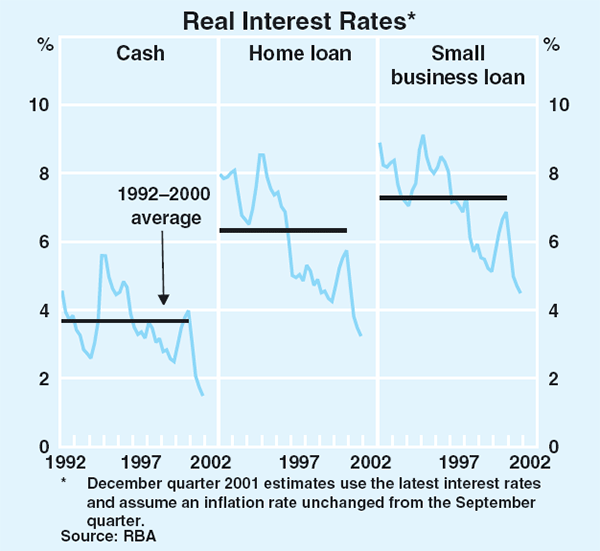
The slope of the yield curve (beyond maturities of around one year) has remained broadly unchanged in recent months (Graph 75). (At the very short end, the yield curve is negatively sloped reflecting market expectations of further easing in monetary policy in the period ahead.) The current positive slope is consistent with perceptions of accommodative monetary policy and continued economic growth.
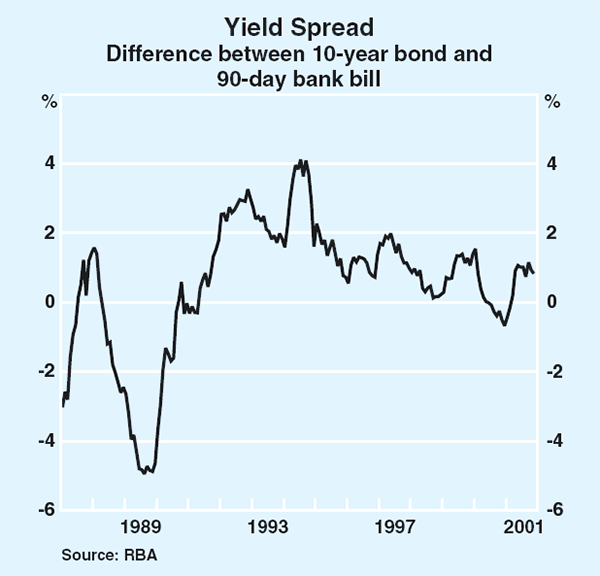
Market-determined interest rates on lower-rated corporate debt suggest a somewhat more cautious outlook in the wake of the terrorist attacks in the US, with spreads to lower-risk government debt generally widening, although the level of yields across the credit spectrum remains relatively low.
Financing activity
Credit grew at an annualised rate of around 8 per cent over the six months to September. This slowdown in credit growth masks quite disparate borrowing behaviour by households and businesses (Graph 76).
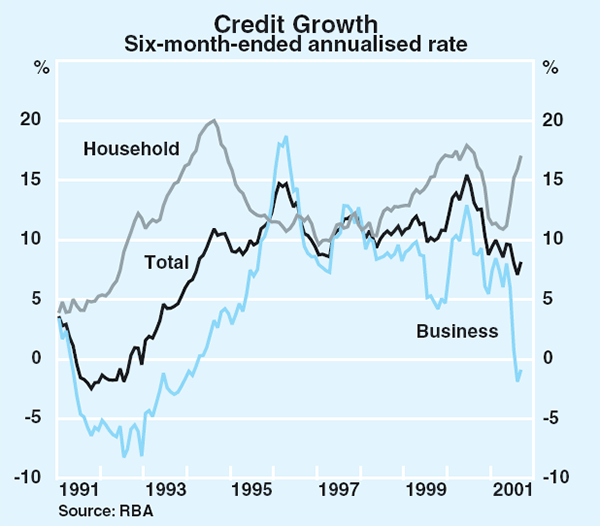
Households continue to borrow at a rapid pace, with household credit rising at an annualised rate of 17 per cent over the six months to September. The strength in household borrowing reflects a significant increase in lending for housing to both owner-occupiers and investors underpinned by the low level of mortgage interest rates and, to a lesser extent, the First Home Owners' Grant scheme. The current high level of loan approvals suggests that household borrowing will remain strong in the coming months.
In contrast, business credit has declined slightly over the same period. The general weakness in business credit – notwithstanding considerable volatility in the monthly data which possibly reflects the impact of the new tax system on the seasonal pattern of business borrowing – is consistent with businesses' uncertainty regarding the economic outlook. Business loan approvals also remain at low levels. Lower intermediated borrowings have been only partially offset by solid growth in business funding raised directly through debt and equity markets. While market financing conditions became less favourable in the wake of the US terrorist attacks, causing the postponement of some debt and equity issues, both equity prices and bond yields remain positive for corporate financing.
Growth in the broader monetary aggregates has picked up recently: M3 and broad money grew at an annualised rate of 13 and 9 per cent respectively over the six months to September. Growth in the monetary aggregates has outstripped that in credit, as net offshore borrowing by financial institutions – a funding source not included in the monetary aggregates – has slowed.
Real exchange rate
As discussed in the chapter on ‘International and Foreign Exchange Markets’, the Australian dollar has been volatile in recent months but is currently around its average over the past year. The real exchange rate, which adjusts for differences in inflation across countries, is also currently close to its level of a year ago but 15 per cent below its 1990s average. This is likely to provide an ongoing impetus to the traded sector of the economy (Graph 77).

Inflation Trends and Prospects
Recent developments in inflation
Consumer prices
The Consumer Price Index (CPI) increased by 0.3 per cent in the September quarter to be 2.5 per cent higher over the year (Graph 78). Inflation measures are now largely unaffected by the direct effect of changes to the tax system, but fluctuations in the price of petrol continue to have a significant influence. Petrol prices fell by over 8 per cent in the September quarter and are 7½per cent lower over the past year. As a result, the decline in petrol prices subtracted almost ½ a percentage point from the latest quarterly and annual rates of inflation.
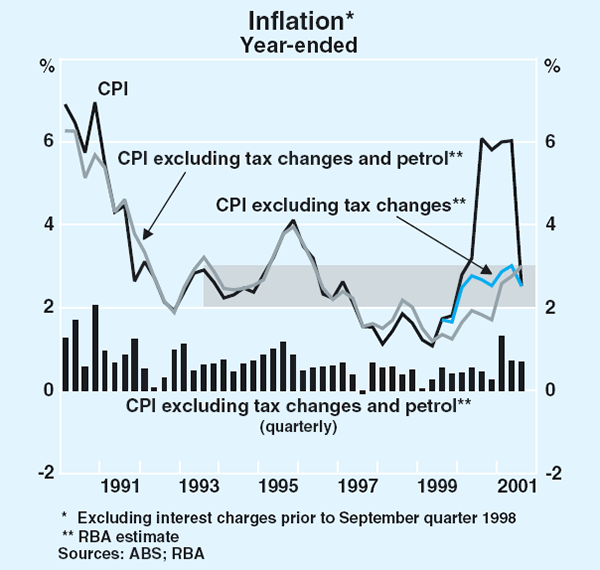
The various measures of underlying inflation were around 0.7 per cent in the September quarter, down from rates of around 0.9 per cent in the March and June quarters (Table 17). Thus, year-ended underlying inflation has risen from 2½ per cent in mid 2000 to around 3 per cent currently. This pick-up largely reflects some flow-through of accumulated upstream price pressures relating to the fall in the exchange rate over the past couple of years and increases in world prices which have flowed through to items such as food. These pressures are evident in the rise in annual growth of the tradables component (excluding petrol) of the CPI from zero at the beginning of 2000, to 3½ per cent over the year to the September quarter (Graph 79). Tradables prices (excluding petrol) are rising faster than non-tradables prices for the first time in six years.
| Quarterly | Year-ended | ||||
|---|---|---|---|---|---|
| June quarter 2001 |
September quarter 2001 |
June quarter 2001 |
September quarter 2001 |
||
| CPI | 0.8 | 0.3 | 6.0 | 2.5 | |
| – Tradables | 1.4 | −0.6 | 5.2 | 2.5 | |
| – Non-tradables | 0.4 | 1.1 | 6.7 | 2.6 | |
| CPI excluding volatile items | 0.9 | 0.7 | 5.8 | 2.9 | |
| Market goods and services excluding volatile items | 1.0 | 0.7 | 5.9 | 2.8 | |
| Weighted median(a) | 0.9 | 0.7 | 5.9 | 3.0 | |
| Trimmed mean(a) | 0.9 | 0.7 | 6.3 | 2.9 | |
|
(a) For details on the calculation of these measures, see ‘Measuring Underlying Inflation’, RBA Bulletin, August 1994, available at <www.rba.gov.au>. Sources: ABS, RBA |
|||||
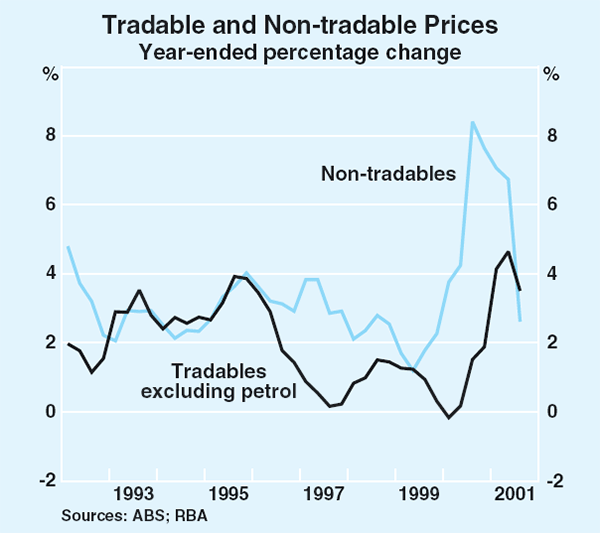
In the latest quarter, however, there are signs that some of this pressure may be abating. The tradables component of the CPI, excluding petrol, increased by 0.2 per cent in the September quarter, after rising by around 1½ per cent in each of the two previous quarters. To some extent the reduction in upward pressure on tradables prices reflects a levelling off in the exchange rate since the end of 2000. In import-weighted terms, the exchange rate had fallen by 14 per cent over the previous year and a half.
The proportion of tradable items recording price rises in the quarter also declined, having risen sharply in the first half of the year, with large price falls recorded for a number of tradable items. Clothing prices declined by nearly 2½ per cent in the September quarter, continuing the trend of the past year as retailers have sought to run down unwanted inventories. This should ease as inventories return to desired levels. Vegetable prices fell by more than 8 per cent in the quarter, and have now substantially unwound the flood-related rise in the March quarter. The large fall in petrol prices – their steepest decline since the Gulf War – reflected lower crude oil prices and tighter refinery margins. A further fall in the petrol component of the CPI in the December quarter is in prospect if the crude oil price, in Australian dollar terms, remains around its current level (Graph 80).
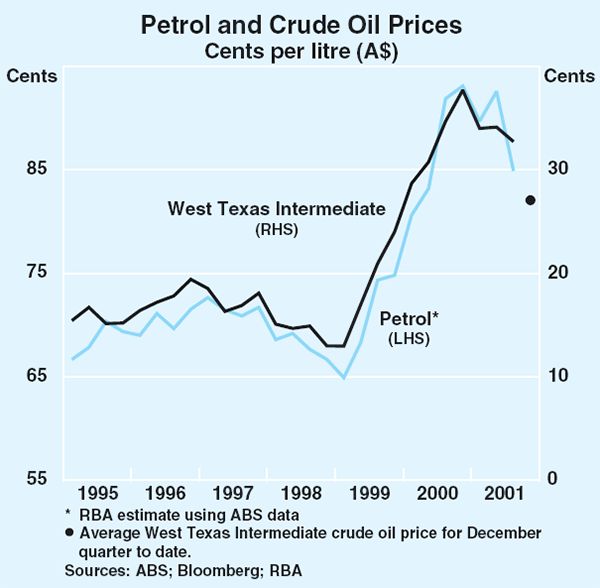
These falls were offset by large rises in the prices of a number of other food items. The price of meat products, in particular, has risen faster over the past year than at any time in the past two decades as a contraction in world supply, due to the outbreaks of livestock diseases, has increased world meat prices. Higher world prices for grain and flour have also led to an increase in the price of cereal products. Prices have risen for dairy products, though for milk this only partially unwinds the large fall in prices experienced in the latter half of 2000. Fruit prices also rose due to supply shortages.
In contrast to the moderate outcome for tradables, the price of non-tradable products increased by a little over 1 per cent in the quarter, after recording outcomes of around ½ a per cent in each of the three previous quarters. House purchase prices, which had risen very little in the previous three quarters, rose by just under 1 per cent in the September quarter, reflecting the recovery in activity in the housing sector.
A number of other non-tradable service prices also rose strongly. Insurance service prices increased by 2.7 per cent in the quarter, and are 7 per cent higher over the past year owing partially to an easing in competitive pressures in the industry. Utility prices, which have generally been stable over the past few years (after excluding the effect of the GST), rose by 3 per cent in the quarter due partly to the cessation of the ‘Winter Power Bonus’ in Victoria, which had reduced household energy bills by $60 over the past three years. Airline ticket prices, as measured in the CPI, are yet to show the impact of recent developments in the airline industry – the demise of Ansett and the reduction in international air travel – as these events occurred late in the quarter.
Producer prices
Input cost pressures, after peaking in the second half of 2000, have moderated over the course of 2001, aided by a decline in import prices (Graph 81). Producer price inflation over the past year is now running at around 3 per cent at all stages of production (Table 18). This is well down on the rates in late 2000, suggesting that inflationary pressure from this source has eased considerably in recent quarters.
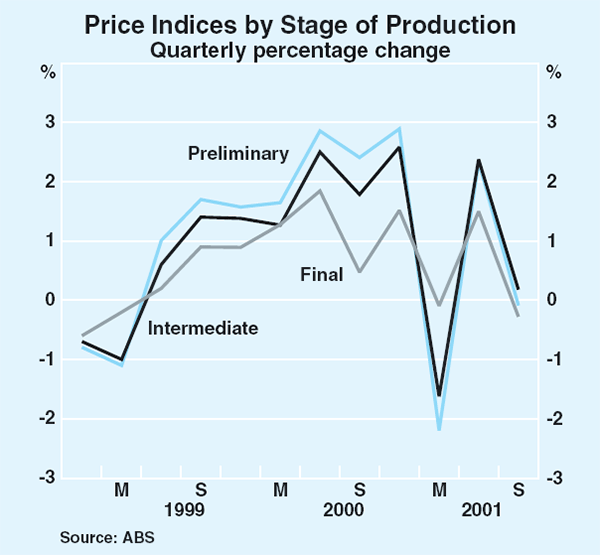
| Sep qtr 2001 |
Year to Sep qtr 2001 |
|
|---|---|---|
| Preliminary | −0.1 | 2.9 |
| – Domestic | 0.4 | 2.9 |
| – Imported | −3.3 | 3.1 |
| Intermediate | 0.2 | 3.5 |
| – Domestic | 0.7 | 3.4 |
| – Imported | −3.3 | 3.9 |
| Final(a) | ||
| Domestic | 0.3 | 2.1 |
| – Consumption | −0.3 | 2.3 |
| – Capital | 0.9 | 2.0 |
| Imported | −2.7 | 5.2 |
| – Consumption | −2.4 | 5.5 |
| – Capital | −3.0 | 4.9 |
| Total | −0.3 | 2.7 |
| – Consumption | −0.7 | 2.8 |
| – Capital | 0.2 | 2.5 |
|
(a) Excluding exports Source: ABS |
||
In the most recent quarter, widespread falls were recorded in the prices of imported goods. The fall in the price of electrical machinery was particularly large, with office equipment prices falling by more than 10 per cent in the September quarter. Oil prices also fell, with the Asian benchmark oil price declining by 9 per cent in the quarter.
These falls were offset by price rises for most domestically produced items. The price of food again rose markedly in the September quarter due to higher prices for meat, grain and dairy products. The rate of inflation for domestically manufactured goods (excluding petrol and basic metal products) slowed in the September quarter, but in annual terms it still remains high at 4½ per cent. Increased activity in the housing sector raised the cost of construction output by almost 1 per cent in the September quarter, after declines in each of the past two quarters. Inflation in the property and business services sector continued at a steady pace overall, but with some variation across industries. The cost of computer consultancy services fell by ½ a per cent in the September quarter, reflecting widespread weakness in demand, while fees for legal services rose by 4½ per cent.
Some upward pressure on business costs is likely to emanate from the insurance and electricity industries. Businesses are reported to have experienced large increases in commercial insurance premiums in recent quarters, reflecting the withdrawal of some low-cost competitors from the market, lower investment returns for insurance companies and an increase in the number of global catastrophes. While the effect of the terrorist attack on the global insurance industry remains uncertain, the inevitable contraction in the supply of reinsurance suggests that upward pressure on commercial premiums is likely to be maintained in the short term. Businesses are also reporting increases in the price of electricity, particularly at the wholesale level, as some of the large price falls that occurred through the second half of the 1990s are unwound (see Box E).
Most major business surveys support the view that inflationary pressures from input cost increases have abated from the pace recorded in 2000. The economy-wide NAB business survey shows that purchase costs increased by 0.6 per cent in the September quarter, their slowest rate for 18 months, with a further slowing expected in the December quarter (Graph 82). Similarly, both the ACCI-Westpac and Australian Industry Group surveys indicate that fewer manufacturers are reporting rising costs than in previous quarters. Business expectations for product price inflation are more mixed, but, in general, fewer firms are expecting to raise prices than at the same time last year.
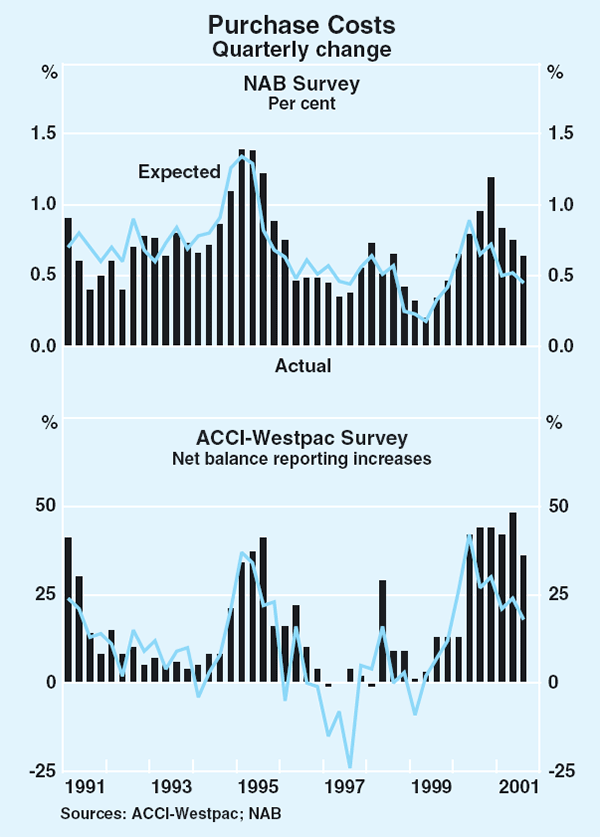
Labour costs
The various measures of wages generally indicate that labour costs remain contained following a modest acceleration in the growth of some of these measures over the course of 2000. The Wage Cost Index (WCI) increased by 3.7 per cent over the year to the June quarter 2001, the same annual rate as in the previous quarter, with similar growth recorded in both the public-sector and private-sector components (Graph 83). This levelling-out in wages growth is consistent with data for new enterprise agreements. The average annualised wage increase in federal enterprise agreements certified in the June quarter was 3.9 per cent, slightly lower than that recorded in the latter part of 2000 (Graph 84). Wage increases under existing federal agreements have remained little changed over the past year and a half at 3.7 per cent.
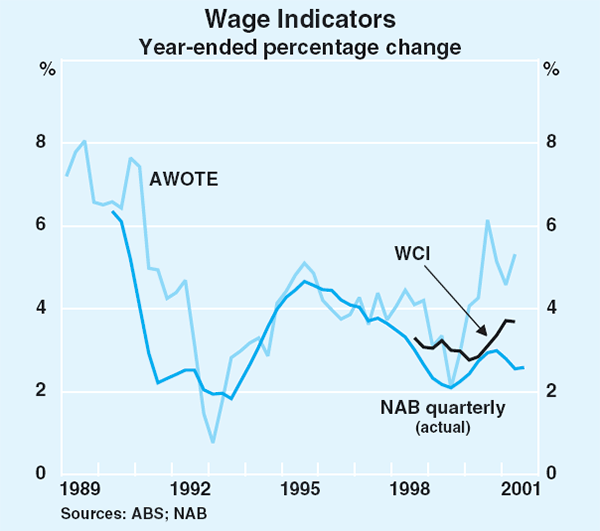
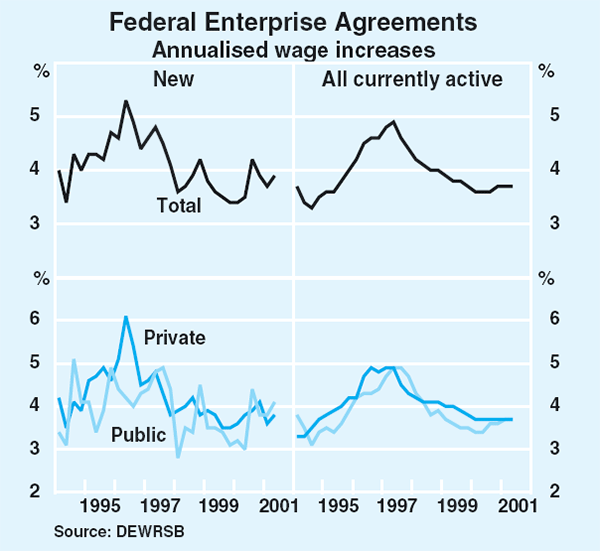
Growth in average weekly ordinary-time earnings (AWOTE) remains firm, rising by 2.2 per cent in the June quarter, to be 5.3 per cent higher than a year ago. The rise in the quarter was well above growth in most other indicators and is likely to reflect compositional problems that beset the Average Weekly Earnings survey.
According to the Mercer Cullen Egan Dell (MCED) Quarterly Salary Review, the average annual increase in office workers' wages was little changed in the September quarter at 4.4 per cent, while growth in executive salaries remained around 4¾ per cent. Recent business surveys indicate that wages growth remains contained, with the NAB quarterly business survey reporting that labour costs continued to grow modestly in the September quarter. Both the NAB economy-wide survey and the ACCI-Westpac survey of manufacturers reported that firms are having little difficulty attracting suitable labour.
The Australian Council of Trade Unions announced in late October that it intends to make an application to the Australian Industrial Relations Commission (AIRC) to vary award rates of pay. The claim, which will be heard as part of the Safety Net Review early next year, seeks a $25 per week increase in pay for all award workers. Last year, the AIRC granted increases of between $13 and $17 per week.
Inflation expectations
The inflation expectations of consumers have been relatively steady over the past few quarters after recording strong rises over the year prior to the introduction of the GST (Graph 85). The Melbourne Institute indicates that consumers' median expectation for inflation over the coming year was 4.5 per cent in October, unchanged from September; this series has exceeded the actual rate of inflation throughout most of the past decade.
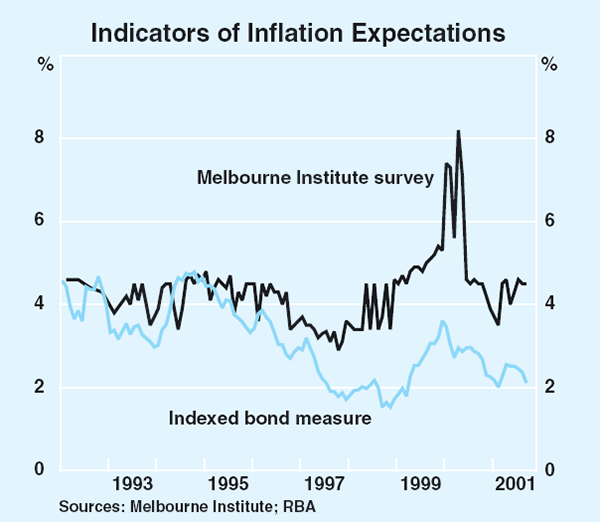
Business expectations for inflation have also remained steady. The NAB business survey indicates that retailers expect to increase prices by 0.7 per cent in the December quarter. Over the medium term, less than one in ten respondents expect inflation to average more than 4 per cent, while one-third of respondents expect inflation to be below 3 per cent. Longer-term inflation expectations of investors, as measured by the difference between nominal and indexed 10-year bond yields, have fallen over the past three months and are back around the low levels recorded in late 1997 and 1998.
Most financial-market economists surveyed by the Bank have revised down their inflation forecasts following the release of the September quarter CPI. The median inflation forecast for the year to June 2002 declined from 2.3 per cent in the August survey, to 2.0 per cent in the latest survey (Table 19). The median inflation forecast for the year to June 2003 was 2.2 per cent. Most respondents' forecasts still incorporate the assumption that over the next couple of years, the exchange rate will appreciate. Trade union officials, as surveyed by the Australian Centre for Industrial Relations Research and Training (ACIRRT), have revised down their expectations for inflation over the year to June 2002 in the November survey, unwinding the sharp increase reported in the May survey. Union officials generally expect inflation to remain around 3 per cent over the year to June 2003.
| Year to June 2002 | Year to June 2003 | |||||
|---|---|---|---|---|---|---|
| May 2001 |
August 2001 |
November 2001 |
August 2001 |
November 2001 |
||
| Market economists(a) | 1.9 | 2.3 | 2.0 | 2.5 | 2.2 | |
| Union officials(b) | 4.5 | 4.0 | 2.9 | 3.8 | 3.1 | |
| (a) RBA survey (b) ACIRRT survey |
||||||
Inflation outlook
After a period in which it was boosted by the rise in the price level associated with the changes to the tax system, CPI inflation was 2½ per cent over the year to September. The various measures of underlying inflation suggest that it has picked up slightly from around 2½ per cent in mid 2000 to around 3 per cent currently. This increase in underlying inflation reflects the pass-through of various cost pressures, in particular those relating to the large decline in the exchange rate over the past couple of years and higher oil prices.
Some of these cost pressures appear to have eased in the latest quarter, as reflected in the producer price data and in a number of business surveys. Petrol prices fell sharply in the September quarter, and are lower still in the December quarter. Although the exchange rate has been reasonably stable, import prices (excluding petrol) fell sharply in the September quarter. This may reflect downward pressure on world prices from the deteriorating global outlook. This is already evident in the prices of electronic equipment, but could become more pervasive if global demand remains weak. The ongoing effects of the earlier decline in the exchange rate on prices for tradables would, in most circumstances, be expected to result in quarterly CPI inflation remaining higher than normal in the period immediately ahead, as profit margins on import sales are gradually restored. But it is possible that the process of margin re-building could occur in part by a decline in foreign-currency prices for imports, with less pressure on final prices to the consumer. This outcome appears to be more likely now than was the case six months ago.
There are several industry-specific factors that will work in the opposite direction over the next year or so, placing some upward pressure on business costs. Businesses are already reporting large increases in commercial insurance premiums, which are likely to continue as reinsurance premiums are raised. Wholesale electricity prices are rising, after a period of declining real electricity prices, with some businesses experiencing particularly large price increases for long-term contracts.
There are also some industry-specific developments that will affect consumer prices more directly. The rebound in the housing market is already feeding through into increases in house purchase costs and this pressure is likely to intensify in the coming quarters. The recent changes to the structure of the airline industry have put upward pressure on the cost of air travel, though this is not yet evident in the CPI. More generally, competitive pressures have helped cap price rises in the insurance, telecommunications and airline sectors over the past decade. The exit of a number of businesses from these industries in recent months may result in some rise in prices in these areas.
Nevertheless, competition remains strong across many sectors, and businesses are likely to find it difficult to raise prices significantly while there remains appreciable spare capacity in the economy. The current subdued state of the labour market, and the prospect that this will persist for some time, means that growth in labour costs should remain well contained and may slow. Together with the general easing in cost pressures, this increases the scope for some margin re-building without strong pressure on consumer prices.
The Bank's assessment is that underlying inflation, measured on a year-ended basis, will reach a little over 3 per cent in the next couple of quarters, before declining to around 2½ per cent through 2002. In the near term, CPI inflation is likely to remain below underlying inflation due to the decline in petrol prices. This assessment is based on the usual assumption that the exchange rate remains around recent levels, though international oil prices are assumed to drift slightly higher over the coming year in response to reductions in oil production.
Risks to the forecast can be identified in both directions. Inflation could be higher than forecast if the world economy were to recover faster than is currently anticipated, lessening the assumed downward pressure on world prices. The possibility of higher oil prices, given the current military tensions, constitutes another upside risk to the outlook for inflation. A sharp and sustained rise in the price of oil would feed directly into consumer prices, but there would also be an indirect effect through higher business costs.
On the other hand, inflation could be lower than forecast if the downturn in the global economy were to be deeper or more protracted than currently assumed. Such a scenario could result from the recession in the US economy being worse than the Consensus forecasts currently imply. In addition to causing larger declines in world prices, the weaker world economy could translate into slower demand growth in Australia and hence, in time, further constrain domestic wage and price increases. Currently, the Bank considers these risks to the central forecast, over a one to two year horizon, to be slightly weighted towards the downside.
Box E: Electricity Prices
The electricity industry in Australia has changed substantially over the past decade. A range of administrative reforms and the introduction of competition to parts of the industry have been associated with significant productivity gains and, for much of the period, declining real electricity prices. However, in recent months there has been upward pressure on electricity prices, with some customers experiencing particularly large price increases.
Reforms implemented over the past decade have resulted in the separation of the components of electricity supply – generation, transmission, distribution, and retail supply. Competition was introduced into the generation of electricity by dividing the power stations into separate corporate entities, initially in Victoria and NSW and later in other states. Competition has also been introduced to parts of the retail electricity market. At this stage, large and some medium-sized users of electricity in most states have the choice of retail supplier – that is, in the parlance of the industry, users are deemed to be ‘contestable’. All users in NSW and Victoria are expected to be able to choose their electricity retailer next year. South Australia plans to adopt full retail contestability later than in these states, while Queensland has decided not to proceed.
Another key development was the establishment in December 1998 of the National Electricity Market (NEM), which connected the individual electricity grids of NSW, Victoria, Queensland, South Australia and the ACT.[1] It allows the transmission of electricity across these regions' borders.
Electricity price developments
Movements in final electricity prices can largely be traced to two components: anenergy charge which mainly reflects movements in wholesale electricity prices, and network charges levied on electricity retailers by electricity distributors, reflecting the costs of building and maintaining the electricity distribution and transmission network. As a rough guide, for medium-sized businesses the energy charge comprises at least 50 per cent of the final electricity price.
The reforms in the electricity industry were associated with a decline in electricity prices faced by businesses and a slowing in the growth of electricity prices faced by households (Graph E1). Large and medium-sized businesses in Victoria and NSW who were contestable benefited from falls in electricity prices during 1996–1998, underpinned by the low wholesale price of electricity as generators competed for market share (Table E1) and, more recently, falling network charges. Businesses in South Australia also experienced lower prices in this period. However, over the past few years, wholesale prices have risen which, along with expected smaller future reductions in network charges, have been feeding through to higher final electricity prices as businesses in these states renegotiate their electricity contracts.
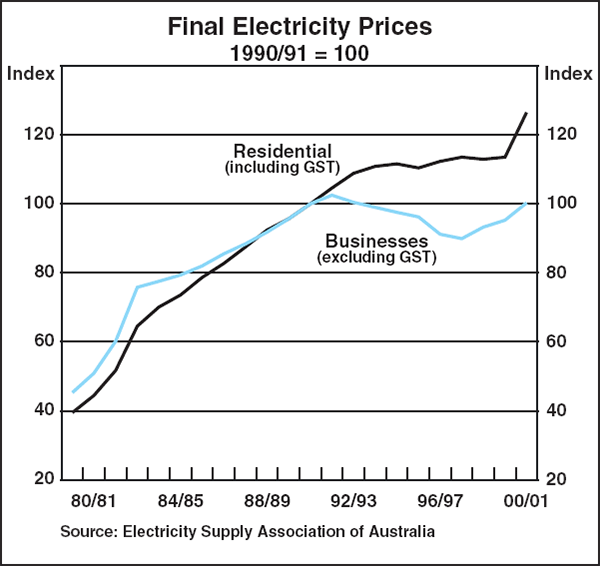
| State | 1994 | 1995 | 1996 | 1997 | 1998 | 1999 | 2000 | 2001(b) |
|---|---|---|---|---|---|---|---|---|
| NSW | – | – | 24.1(c) | 17.5 | 19.4 | 22.7 | 35.7 | 34.7 |
| Victoria | 46.7(d) | 42.2 | 19.9 | 18.8 | 18.3 | 22.6 | 38.3 | 38.3 |
| Queensland | – | – | – | – | – | 41.6 | 50.3 | 37.2 |
| SA | – | – | – | – | – | 54.5 | 57.2 | 46.2 |
|
(a) Prices only available since the commencement of each state's wholesale
spot market Source: NEMMCO |
||||||||
In South Australia, where many additional business users have just become contestable, electricity prices are increasing substantially. This partly reflects the artificially low prices contained in their previously regulated contracts, but also a perceived increased risk that tighter supply of electricity in the summer months may cause large spikes in wholesale electricity prices, as occurred last summer (Graph E2).
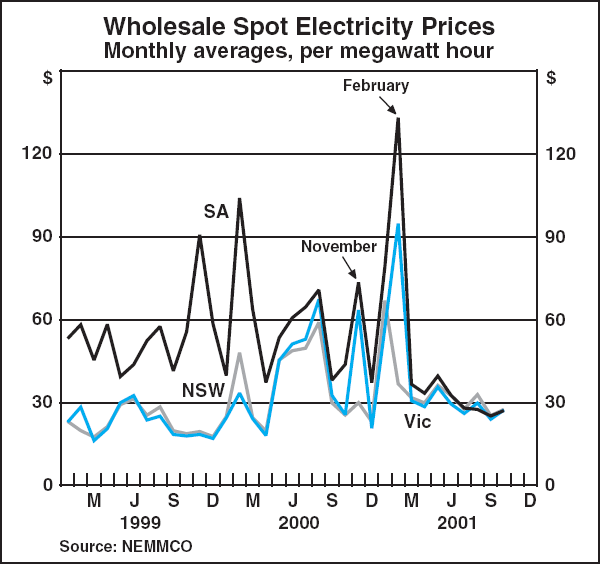
In contrast to larger businesses, the supply of electricity to households and smaller businesses is only now becoming contestable in NSW and Victoria. In Victoria, the government has reserved the right to oversee the setting of electricity prices in that state. In NSW, households have the option until mid 2004 of remaining on (or returning to) a regulated contract which limits the price rise to that of the total CPI. In South Australia and Queensland, price rises of around 3 per cent have been determined for 2001/02.
Effects on the CPI
Electricity prices affect the CPI directly through households' consumption of electricity, and indirectly as changes in input costs faced by businesses are passed on to prices of other goods and services. Electricity has a weight of 1.8 per cent in the CPI and, in the near term, as the majority of households will be covered by regulated contracts containing subdued price increases, the direct effect on inflation will be fairly small. Although electricity comprises less than 2 per cent of total intermediate inputs used in production, it accounts for much more in selected industries – electricity comprises up to 8 per cent of intermediate inputs in parts of the manufacturing industry. The size of recent price increases for some businesses will have a significant effect on their overall costs and may feed through to consumer prices.
Footnote Box B
For statistical purposes, a tourist is defined as a person travelling to, and staying in, places outside their usual place of residence for up to one year. They may be travelling for leisure, business or other purposes, but must not receive remuneration from the place visited. [1]
Footnote Box E
Tasmania is scheduled to join the NEM in the near future. Although distance may preclude Western Australia and the Northern Territory from joining the NEM, they are also implementing electricity reforms. [1]